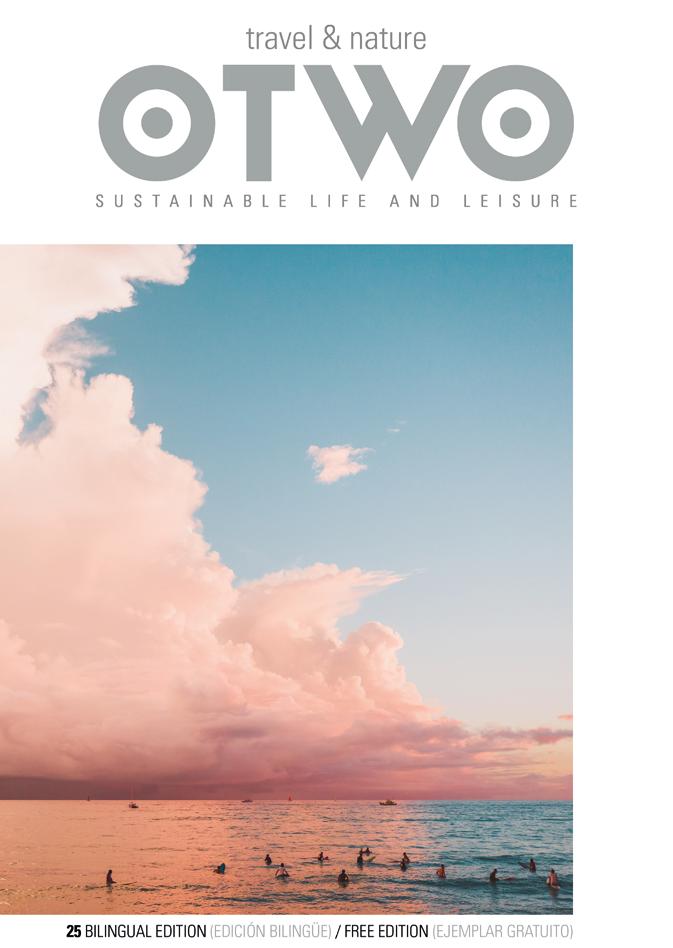


CARPENTRY • MASONRY • GENERAL DECORATION • PLUMBING • ELECTRIC • KITCHENS • BATHROOMS • BEDROOMS
PROFESSIONAL STANDARDS AND BEST PRICES GUARANTEED. REGISTER NOW FOR A NO OBLIGATION ESTIMATE AND RECEIVE A £50 DISCOUNT ON WORKS. WE WILL CALL YOU WHEN LOCK DOWN IS LIFTED : BE THE FIRST AND AVOID THE RUSH!
Admin offices: Suite D 122 Irish Town Call 54083022 or email minorworks@evgib.com
“Sunset is the start of something beautiful: the night”.
Juansen Dizon.
«El atardecer es el inicio de algo hermoso: la noche».
Juansen Dizon.
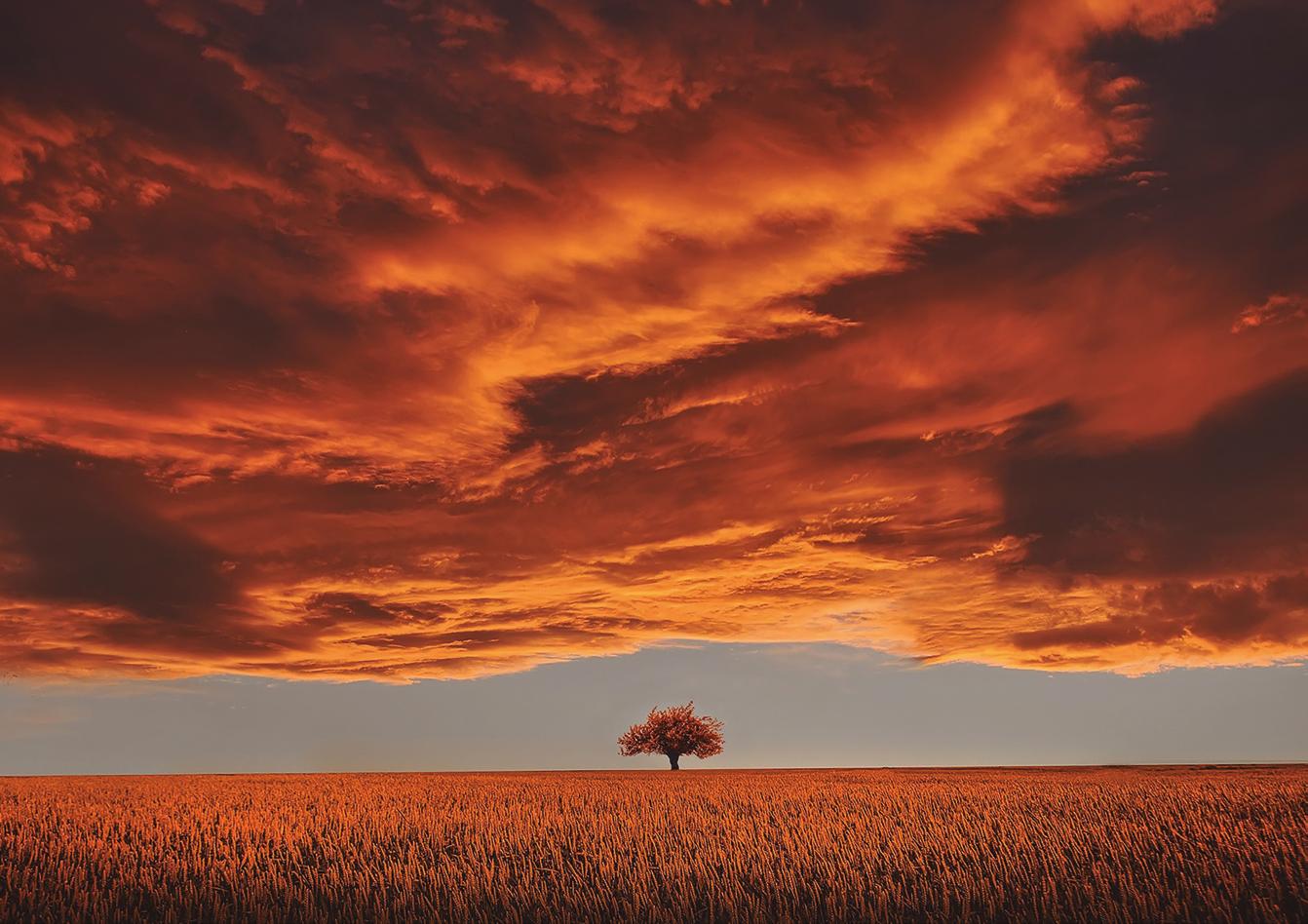
PHOTOGRAPHY: PEXELS.COM

“Don’t simply retire from something; have something to retire to”.
Harry Emerson Fosdick.
«No te retires simplemente de algo; ten algo a lo que retirarte».
Harry Emerson Fosdick.
“I had forgotten how much light there is in the world, till you gave it back to me.”.
Ursula K. Le Guin.
«Olvidé cuanta luz hay en el mundo, hasta cuando me la has regalado».
Ursula K. Le Guin.


Subscribe. A simple gesture, but so important. Plus it’s free. Suscríbete. Un gesto sencillo, pero tan importante. Además, es gratis. www.otwomag.com
This volume was published in September 2021 by Oxygene Ltd. OTWO Issue 26 Oxygene Ltd.Business Centre.
19 George´s Lane.
GX11 1AA, Gibraltar
Tel. +00350 54080331
www.oxygenecommunications.com
© Publishing: Oxygene Ltd.
Vanessa Byrne
Managing & Commercial Director
Juanjo Trujillo
Creative Director & Chief Designer
Sarah Birch
Columnist & Translation
Photographer:
Conchi Trudier, Asociación Amigos de la Janda, Aldepama, Archivo Municipal de La Línea de la Concepción, Pedro Cantalejo Duarte,Handpas Project, Wikipedia, Pexels, Francesco Veronesi, Kai Pilger, Martha Sales, Lindsey K, J. Luis González, In2Adventures, Ebikes Gibraltar, Proema.
Cover photo: Jess Loiterton. Back Cover photo: Brenoanp.
Translations: Sarah Birch, Ana Villata and Merlin Gutherless.
Printing:
Santa Teresa Industrias Graficas SA
All rights reserved. No part of this publication may be reproduced, stored in a retrieval system or transmitted in any form or by any means, electronic, mechanical, photocopying, recording or otherwise, without the prior permission in writing from the publishers.
All rights reserved. ISSN 2633-7401


Shorts
Eco Passion: 10 simple steps to a more sustainable lifestyle.
Eco Passion: 10 sencillos pasos para un estilo de vida más sostenible.
How to get cities cycling.
Cómo llegar a las ciudades en bicicleta.
COAMBA: Solar greenhouses in Almeria in transition to Circular Economy models. Los invernaderos solares de Almería en transición hacia modelos de Economía Circular.
Recovering the Lagoon of La Janda. Recuperar La Laguna de La Janda.
A new journey into the heart of darkness. Interview with Gillermo Pérez, President of Aldepama. Un nuevo viaje al corazón de las tinieblas. Entrevista a Gillermo Pérez, Presidente de Aldepama.
Cave Of Ardales, two centuries since its discovery. Cueva de Ardales, dos siglos desde su descubrimiento.
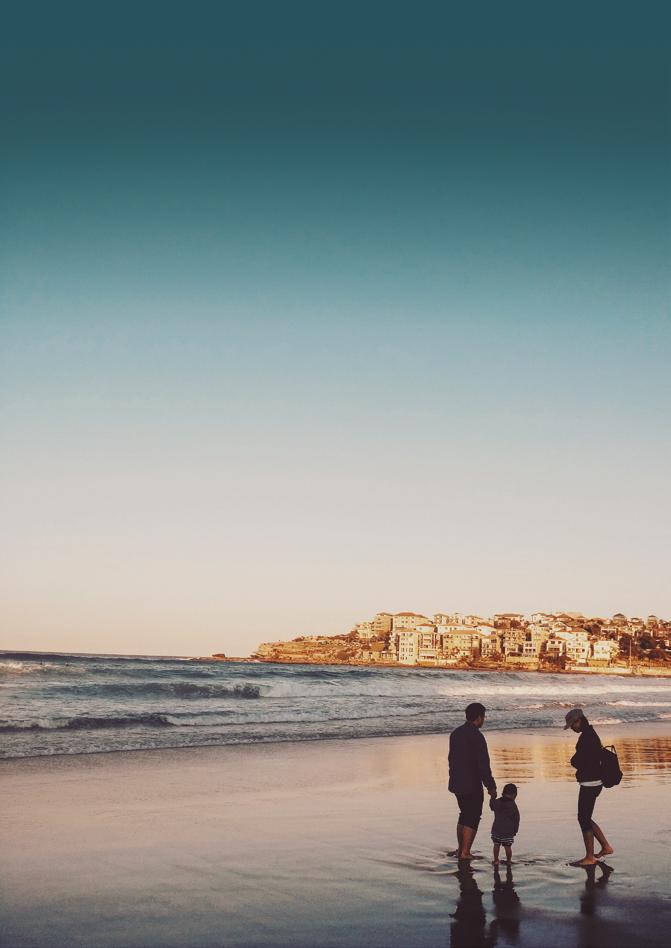

OTWO 26
2021 001
Experiences Quick Guide The adventures of Sai Nosha´s Corner The voice of our future Collection “The flower of the month”. Colección “La flor del mes”
Editorial 10 14 16 24 28 38 48 62 74 88 100 102 104 106 108 110 115 Nature´s Way Narrowing the Strait Clubhouse Minds
.

A note from the editor
Vanessa Byrne / Managing Director
As summer draws to a close and school routines start to kick in, don’t forget it’s not all doom and gloom. We have a few more long weekends and mid-terms to look forward to which will give us bits of freedom to cling on to.
This September we have again joined forces with eBikes Gibraltar to create another event providing focus on cycling. To be held on the 10th of September at 10:30, The National Day Cycle will give the community of Gibraltar a further opportunity to support safer cycling on the Rock. Show your support by joining the Facebook group ‘Stay Calm and Support Safe Cycling on the Rock’ and, if you are available, meet us on your bike at Europa Point by the lighthouse on National Day for a group photo and enjoy a FREE coffee at the Europa Point Cafe.
In this month’s edition we have another article written by Sarah showing how cities and governments have made conscious efforts to prioritize cycling and make it the main mode of transportation. “How to get cities cycling the Dutch way” provides insight on how, as a community, any city can change and adapt to include this sustainable mode of transport. In the article itself there are various links that lead to policies and guidelines taken. A must read.
“One of the great challenges facing humanity in this 21st century is to ensure sufficient and nutritious food supplies for all in the year 2050. This is a serious challenge taking into account the growing world population on the one hance and that the degradation of already scarce natural resources.” This is an issue which needs to be address and solved. Check out page 39 on this month’s edition and see
how the Solar Greenhouses in Almeria are shaping circular economic models in this field.
This month our very own Juanjo Trujillo had the pleasure of interviewing Gillermo Perez, the President of Aldepama and one of the oldest and most combative members of Los Locos del Parque. We have been featuring various articles on this area located just across the border which has been revamped by its residents from ruins to a breathtaking natural location. We now end this 3-part series with an interview from the President of Aldepama who has been there from the start. We cannot be more grateful for their dedication, work and for sharing their most inspiring story with us. Check out their final chapter on page 62. We are happy and proud to introduce our very own column on the Adventures of Sai. The OTWO team are currently revamping an old VW Transporter into a camper van and of course, kitting it out with sustainable energy is a very big must in this venture. Check out page 110 and see why we decided to start on this and follow Sai every month and see it unravel.
Finally, I cannot finish this editorial without a special mention to the spectacular poem written by Alexandra Lester at the age of 15 on page 103. “Promise you’ll try” is an intense poem written for Earth Hour 2017. It really captures the urgency in which we need to change and adapt the way in which we live. Truly inspiring.
Wishing you all a peaceful and swift transition into the routine life.
Peace and love to all
11 10
OTWO 26 / SEPTEMBER 2021 OTWO 26 / SEPTEMBER 2021
ILLUSTRATION:
JUANJO TRUJILLO
Una nota de la editora
A medida que el verano se acerca a su fin y la rutina escolar comienza a ponerse en marcha, no hay que olvidar que no todo es pesimismo. Nos quedan unos cuantos fines de semana largos y exámenes parciales que nos darán un poco de libertad a la que aferrarnos.
Este mes de septiembre hemos vuelto a unir fuerzas con eBikes Gibraltar para crear otro evento centrado en el ciclismo. Se celebrará el 10 de septiembre a las 10:30, el Día Nacional de la Bicicleta dará a la comunidad de Gibraltar una nueva oportunidad de apoyar un ciclismo más seguro en el Peñón. Muestre su apoyo uniéndose al grupo de Facebook “Mantenga la calma y apoye el ciclismo seguro en el Peñón” y, si está disponible, reúnase con nosotros en su bicicleta en Europa Point, junto al faro, el Día Nacional para hacerse una foto de grupo y disfrutar de un café GRATIS en la cafetería de Europa Point.
En la edición de este mes tenemos otro artículo escrito por Sarah que muestra cómo las ciudades y los gobiernos se han esforzado conscientemente por dar prioridad a la bicicleta y convertirla en el principal medio de transporte. “Cómo conseguir que las ciudades vayan en bicicleta al estilo holandés” ofrece una visión de cómo, como comunidad, cualquier ciudad puede cambiar y adaptarse para incluir este modo de transporte sostenible. En el propio artículo hay varios enlaces que llevan a políticas y directrices adoptadas. Una lectura obligada.
“Uno de los grandes retos a los que se enfrenta la humanidad en este siglo XXI es garantizar el suministro de alimentos suficientes y nutritivos para todos en el año 2050. Se trata de un serio reto teniendo en cuenta, por un lado, el crecimiento de la población mundial y, por otro, la degradación de los ya escasos recursos naturales”. Se trata de un problema que hay que abordar y resolver. Consulta la
página 39 de la edición de este mes y comprueba cómo los Invernaderos Solares de Almería están dando forma a modelos económicos circulares en este campo.
Este mes nuestro Juanjo Trujillo ha tenido el placer de entrevistar a Guillermo Pérez, presidente de Aldepama y uno de los miembros más veteranos y combativos de Los Locos del Parque. Hemos publicado varios artículos sobre esta zona situada al otro lado de la frontera, que sus habitantes han transformado el abandono en un lugar de impresionante naturaleza. Ahora terminamos esta serie de 3 partes con una entrevista del Presidente de Aldepama que ha estado allí desde el principio. No podemos estar más agradecidos por su dedicación, su trabajo y por compartir con nosotros su historia más inspiradora. Consulta su capítulo final en la página 62.
Estamos felices y orgullosos de presentar nuestra propia columna en las Aventuras de Sai. El equipo de OTWO está renovando una vieja VW Transporter para convertirla en una furgoneta camper y, por supuesto, equiparla con energía sostenible es una necesidad muy grande en esta empresa. Echa un vistazo a la página 110 y verás por qué decidimos empezar con esto y seguir a Sai cada mes y ver cómo se desenvuelve.
Por último, no puedo terminar este editorial sin una mención especial al espectacular poema escrito por Alexandra Lester a los 15 años en la página 103. “Promete que lo intentarás” es un intenso poema escrito para la Hora del Planeta 2017. Realmente capta la urgencia en la que debemos cambiar y adaptar la forma en la que vivimos. Realmente inspirador.
Les deseo a todos una transición pacífica y rápida a la vida rutinaria.
Paz y amor para todos

13 OTWO 25 / AUGUST 2021 12 OTWO 25 / AUGUST 2021
ILLUSTRATION: JUANJO TRUJILLO
ILLUSTRATION: JUANJO TRUJILLO
Vanessa Byrne / Directora General


SEPTEMBER/ SEPTIEMBRE
Collection “The flower of the month”
MadagascarPalm
Dr Keith Bensusan Director
Gibraltar Botanic Gardens, The Alameda.
The island of Madagascar, off the coast of southeast Africa, has been isolated for 88 million years. It has therefore evolved a very distinct and unusual fauna and flora, and it is considered a global biodiversity hotspot. This huge island of varied habitats has produced some of the most remarkable plants on the planet. Perhaps the most characteristic are the pachycauls: trees and shrubs with disproportionately thick stems that are adapted to the dry conditions that predominate throughout parts of the island. The most famous are the Baobabs: six of the world’s eight species are found in Madagascar alone. Images with towering Grandidier’s Baobab Adansonia grandidieri are perhaps the most famous photographs from the island. However, many smaller species are similarly striking. These include many species in the genus Pachypodium, of which there are twenty-five species, with twenty of these in Madagascar. Although known as the Madagascar Palm, Pachypodium lamerei is not a palm, but rather a member of the dogbane family and thus releated to the Oleander Nerium oleander of the Mediterranean. It grows well in Gibraltar’s climate and can be seen in the Gibraltar Botanic Gardens. Its succulent, thorny trunk and white flowers are very distinctive.
Pachypodium lamerei
Palma de Madagascar
La isla de Madagascar, frente a la costa del sureste de África, ha estado aislada durante 88 millones de años. Por ello, ha desarrollado una fauna y flora muy distintas e inusuales, y se considera un punto caliente de biodiversidad mundial. Esta enorme isla de hábitats variados ha producido algunas de las plantas más notables del planeta. Quizá las más características sean los paquicáceos: árboles y arbustos con tallos desproporcionadamente gruesos que están adaptados a las condiciones de sequedad que predominan en toda la isla. Los más famosos son los baobabs: seis de las ocho especies del mundo se encuentran sólo en Madagascar. Las imágenes del imponente baobab de Grandidier, Adansonia grandidieri, son quizá las fotografías más famosas de la isla. Sin embargo, muchas especies más pequeñas son igualmente llamativas. Entre ellas se encuentran muchas especies del género Pachypodium, del que hay veinticinco especies, veinte de ellas en Madagascar. Aunque se la conoce como palmera de Madagascar, Pachypodium lamerei no es una palmera, sino un miembro de la familia de los bálagos y, por tanto, está relacionada con la adelfa Nerium oleander del Mediterráneo. Crece bien en el clima de Gibraltar y puede verse en los Jardines Botánicos de Gibraltar. Su tronco suculento y espinoso y sus flores blancas son muy característicos.
14
15
OTWO 26 / SEPTEMBER 2021 OTWO 26 / SEPTEMBER 2021

JULY WAS THE HOTTEST MONTH EVER RECORDED
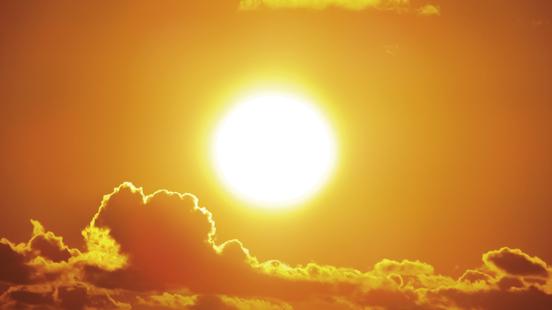
US scientists have confirmed that July 2021 was the hottest month ever recorded on Earth.
The combined global land and ocean surface temperature were 0.93 Celsius higher than the 20th Century average of 15.8C, which not only made it the hottest July ever, but the highest average global temperature ever recorded since records began 142 years ago. July 2021 has beaten the previous joint record set in July 2016, 2019, and 2020.
The National Ocean and Atmospheric Administration (NOAA) found that soaring temperatures were propelled by heatwaves across the globe. Asia had its hottest July ever, and Europe recorded its second hottest July since records began. Most of Europe, particularly Greece, Turkey and Italy, have experienced massive wildfires due to the extreme heat.
Even the Southern Hemisphere has seen unusually warm temperatures, with Australia recording its fourth warmest July on record.
The Climate report published by NOAA also found that the overall area of Arctic Sea ice was 18% below the average amount recorded between 1981 –2010.
As heatwaves continue, NOAA climatologists predict that 2021 will be one of the top ten hottest years ever recorded, with early data from an extraordinarily hot August already reaffirming this grave
forecast. In mid-August, Sicily recorded Europes hottest ever temperature of 48.8C.
The report by NOAA was followed by a major report published by the IPCC (United Nations’ Intergovernmental Panel on Climate Change) that warns of the imminent and real threat the world faces as global temperature continue to rise. The IPCC report also states that human activity has unequivocally driven climate change, with levels of CO2 in the atmosphere currently higher than they have been in 2 million years.
The report reviewed more than 14,000 studies on climate change and concluded that we must swiftly and drastically cut emissions to limit the impact that global warming will have on our planet.
Julio fue el mes más caluroso jamás registrado Científicos estadounidenses han confirmado que julio de 2021 fue el mes más caluroso jamás registrado en la Tierra.
La temperatura global combinada de la superficie terrestre y oceánica fue 0,93 Celsius más alta que la media del siglo XX de 15,8C, lo que no solo lo convirtió en el julio más caluroso de la historia, sino en la temperatura media global más alta jamás registrada desde que se iniciaron los registros hace 142 años. El mes de julio de 2021 ha superado el
anterior récord conjunto establecido en julio de 2016, 2019 y 2020.
La Administración Nacional de los Océanos y la Atmósfera (NOAA) descubrió que el aumento de las temperaturas fue impulsado por las olas de calor en todo el mundo. Asia tuvo el julio más caluroso de su historia, y Europa registró su segundo julio más caluroso desde que se iniciaron los registros. La mayor parte de Europa, sobre todo Grecia, Turquía e Italia, ha sufrido enormes incendios forestales debido al calor extremo.
Incluso el hemisferio sur ha experimentado temperaturas inusualmente cálidas, y Australia ha registrado el cuarto julio más cálido de su historia.
El informe sobre el clima publicado por la NOAA también reveló que la superficie total de hielo marino del Ártico era un 18% inferior a la cantidad media registrada entre 1981 y 2010.
Mientras continúan las olas de calor, los climatólogos de la NOAA predicen que 2021 será uno de los diez años más calurosos jamás registrados, y los primeros datos de un agosto extraordinariamente caluroso ya reafirman esta grave previsión. A mediados de agosto, Sicilia registró la temperatura más cálida de la historia de Europa, con 48,8°C.
El informe de la NOAA fue seguido por un importante informe publicado por el IPCC (Grupo Intergubernamental de Expertos sobre el Cambio Climático de las Naciones Unidas) que advierte de la amenaza inminente y real a la que se enfrenta el mundo a medida que la temperatura global sigue aumentando. El informe del IPCC también afirma que la actividad humana ha impulsado inequívocamente el cambio climático, ya que los niveles de CO2 en la atmósfera son actualmente más altos de lo que han sido en 2 millones de años.
El informe revisó más de 14.000 estudios sobre el cambio climático y concluyó que debemos reducir rápida y drásticamente las emisiones para limitar el impacto que el calentamiento global tendrá en nuestro planeta.

MADRID TO BUILD URBAN FOREST
Madrid plans to build a wall of trees that will surround the city to help tackle climate change and air pollution levels.
The urban forest will be 75km long, consist of near-
ly half a million trees, and absorb 175,000 tonnes of CO2 a year.
The green wall will connect existing forest areas around the city, and trees will be planted in empty sites between roads and buildings in and around Madrid.
The wall will not only help to absorb thousands of tonnes of harmful emissions but also provide respite from rising temperatures caused by human activity. Shade under the trees will be 2C lower than in the rest of the city.
To save water the trees will all be indigenous to Spain. With the risk of desertification reaching the southern hemisphere due to climate change, the green ring around the city is not intended as a park but as a way to lessen the adverse effects of global warming and will be constructed in a way that is easy to maintain with little intervention so that it is self-sustaining.
With cities and urban areas generating three-quarters of global emissions, more and more cities are looking at ways to combat their impact on the planet. The green wall project will work alongside other strategies such as reducing motorised vehicles, promoting green forms of transport, using clean energies and pedestrianizing large parts of the city.
Madrid construirá un bosque urbano
Madrid tiene previsto construir un muro de árboles que rodeará la ciudad para ayudar a combatir el cambio climático y los niveles de contaminación atmosférica.
El bosque urbano tendrá 75 km de longitud, estará formado por casi medio millón de árboles y absorberá 175.000 toneladas de CO2 al año.
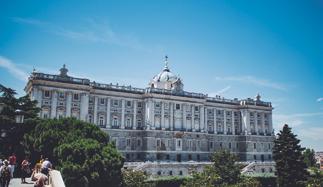
16 OTWO 26 / SEPTEMBER 2021 OTWO 26 / SEPTEMBER 2021 17
El muro verde conectará las zonas forestales existentes alrededor de la ciudad, y se plantarán árboles en los lugares vacíos entre las carreteras y los edificios de Madrid y sus alrededores.
El muro no sólo ayudará a absorber miles de toneladas de emisiones nocivas, sino que también dará un respiro al aumento de las temperaturas causado por la actividad humana. La sombra bajo los árboles será 2C más baja que en el resto de la ciudad.
Para ahorrar agua, los árboles serán todos autóctonos de España. Con el riesgo de desertización que está alcanzando el hemisferio sur debido al cambio climático, el anillo verde que rodea la ciudad no pretende ser un parque, sino una forma de disminuir los efectos adversos del calentamiento global, y se construirá de forma que sea fácil de mantener con poca intervención para que sea autosuficiente.
Dado que las ciudades y las zonas urbanas generan tres cuartas partes de las emisiones mundiales, cada vez más ciudades buscan formas de combatir su impacto en el planeta. El proyecto del muro verde funcionará junto con otras estrategias, como la reducción de los vehículos motorizados, el fomento de formas de transporte ecológicas, el uso de energías limpias y la peatonalización de amplias zonas de la ciudad.

BANNING CFCS GAVE WORLD A CHANCE TO FIGHT CLIMATE CHANGE
A new study has revealed how the landmark ban of CFCs in the 1980s has saved the ozone layer and bought the planet vital time to tackle the climate crisis.
In 1985, three British scientists published findings that ozone levels in the stratosphere above the South Pole were abnormally low, caused by the widespread use of chlorofluorocarbons (CFCs).
The ozone layer is crucial in blocking harmful levels of UV radiation from the sun, which not only causes skin cancer but can damage plants and restrict their growth and ability to absorb carbon.
Within two years of the findings, the 1987 Montreal Protocol to phase out CFCs was signed by 46 countries.
New research has now confirmed that had CFCs not been banned, average global temperatures would have risen by an extra 2.5C by 2100, comple-
tely shattering any hopes of limiting the rise to 1.5C as set out by the Paris Climate Accords.
CFCs were used primarily in refrigeration systems but also in insulation, aerosols and air conditioning. They cause ozone to deplete and are also an extremely harmful greenhouse gas.
The research conducted by the US, UK and New Zealand, was modelled on a theoretical scenario of a 3% rise in CFCs each year from 1987. The ozone layers continued depletion would have had a catastrophic impact on global vegetation’s ability to absorb carbon from the atmosphere, and ultimately the ozone layer would have collapsed by the 2040s.
Without the Montreal Protocol, by 2100 there would have been 580bn fewer tonnes of carbon stored in forests, vegetation and soil, and depending on projected fossil fuel use scenarios, an additional 165-215 parts per million of CO2 in the atmosphere.
The findings are a stark reminder that had the world not unanimously agreed to ban CFCs there would have been no hope of beating the climate crisis today.
La prohibición de los CFC dio al mundo la oportunidad de luchar contra el cambio climático
Un nuevo estudio ha revelado cómo la histórica prohibición de los CFC en la década de 1980 ha salvado la capa de ozono y ha dado al planeta un tiempo vital para afrontar la crisis climática.
En 1985, tres científicos británicos publicaron que los niveles de ozono en la estratosfera sobre el Polo Sur eran anormalmente bajos, causados por el uso generalizado de clorofluorocarbonos (CFC).
La capa de ozono es crucial para bloquear los niveles nocivos de la radiación ultravioleta del sol, que no sólo provoca cáncer de piel, sino que puede dañar las plantas y restringir su crecimiento y capacidad de absorción de carbono.
Dos años después de los descubrimientos, 46 países firmaron el Protocolo de Montreal de 1987 para eliminar los CFC.
Nuevas investigaciones han confirmado ahora que, de no haberse prohibido los CFC, la temperatura media del planeta habría aumentado 2,5 °C más de aquí a 2100, lo que habría hecho añicos cualquier esperanza de limitar el aumento a 1,5 °C, tal y como establecen los Acuerdos Climáticos de París.

Los CFC se utilizaban principalmente en los sistemas de refrigeración, pero también en el aislamiento, los aerosoles y el aire acondicionado. Provocan el agotamiento de la capa de ozono y son también un gas de efecto invernadero extremadamente dañino.
La investigación llevada a cabo por Estados Unidos, Reino Unido y Nueva Zelanda se basó en un escenario teórico de aumento del 3% de los CFC cada año a partir de 1987. El agotamiento continuado de la capa de ozono habría tenido un impacto catastrófico en la capacidad de la vegetación global para absorber el carbono de la atmósfera y, en última instancia, la capa de ozono se habría colapsado en la década de 2040.
Sin el Protocolo de Montreal, en 2100 habría habido 580.000 millones de toneladas menos de carbono almacenado en los bosques, la vegetación y el suelo, y, en función de los escenarios previstos de uso de combustibles fósiles, entre 165 y 215 partes por millón de CO2 adicionales en la atmósfera.
Los resultados son un duro recordatorio de que, si el mundo no hubiera acordado unánimemente la prohibición de los CFC, no habría habido ninguna esperanza de superar la crisis climática actual.

STUDY FINDS GIBRALTAR HAS LARGEST KNOWN CRAG MARTINS ROOST IN THE WORLD
A study conducted by the University of Gibraltar, GONHS, the Botanic Gardens and the Gibraltar Museum has found that Gibraltar is home to the largest known Crag Martin roost in the world.
Last winter, a record 12,000 birds were found roosting in Gorham’s Cave, which represents 1-2% of the European population.
The research also shows that Crag Martins display a high degree of faithfulness to where they roost, with large numbers continuing to come back to Gorham’s Cave year after year.
A statement on the Gibraltar Museum and on the Gorham’s Cave website said: “The study shows that not only do the same birds return to the same caves within and between years, but that the birds in the different caves differ in body condition, indicating that some caves provide better roosting sites than others. These differences in quality of caves could have translated to other species that have used the caves in the past.”
“The findings shed light on the winter ecology of a bird with a very long association with Gibraltar. It indicates that such fidelity and assortment may this have evolved over thousands of years, and it allows us to hypothesise on the relative value of the caves to fauna more generally.”
“Finally, they illustrate the outstanding value of the Gorham’s Cave Complex as a site for original research of faunas past and present.”
The study was published in the Nature research journal Scientific Reports and can be found here
Un estudio revela que Gibraltar cuenta con el mayor dormidero mundial conocido de martinetes del peñón.
Un estudio realizado por la Universidad de Gibral-
19 18
OTWO 26 / SEPTEMBER 2021 OTWO 26 / SEPTEMBER 2021

tar, el GONHS, los Jardines Botánicos y el Museo de Gibraltar ha descubierto que Gibraltar alberga el mayor dormidero mundial de martinetes del peñón.
El invierno pasado, se encontró un récord de 12.000 aves posadas en la Cueva de Gorham, lo que representa entre el 1% y el 2% de la población europea.
La investigación también demuestra que los petirrojos muestran un alto grado de fidelidad al lugar donde se posan, ya que un gran número de ellos sigue regresando a la Cueva de Gorham año tras año.
Una declaración en el Museo de Gibraltar y en el sitio web de la Cueva de Gorham dice: “El estudio muestra que no sólo las mismas aves regresan a las mismas cuevas dentro de un mismo año y entre años, sino que las aves de las distintas cuevas difieren en su condición corporal, lo que indica que algunas cuevas proporcionan mejores lugares de pernocta que otras. Estas diferencias en la calidad de las cuevas podrían haberse trasladado a otras especies que han utilizado las cuevas en el pasado”.
“Los hallazgos arrojan luz sobre la ecología invernal de un ave con una asociación muy larga con Gibraltar. Indican que tal fidelidad y surtido puede haber evolucionado a lo largo de miles de años, y nos permiten formular hipótesis sobre el valor relativo de las cuevas para la fauna en general.”
“Por último, ilustran el extraordinario valor del complejo de cuevas de Gorham como lugar de investigación original de las faunas del pasado y del presente”.
El estudio se ha publicado en la revista de investigación Scientific Reports de Nature y puede consultarse aquí.
CLUBHOUSE GIBRALTAR AND GIBSAMS WORKING TOGETHER BECAUSE OUR MENTAL HEALTH MATTERS SEPTEMBER IS SUICIDE AWARENESS MONTH
Clubhouse Gibraltar and GibSams have got together to hold a presentation and to provide an opportunity to chat to someone face to face (optional), regarding suicide issues or any other concerns on Wednesday 8th September at 304a Main Street at midday. The event will take place for approx. an hour and if people are at work that they may be able to come during their lunch break.
Both charities do important and much needed work in the local community to help those facing difficult times, when you are the one in despair both charities have proven to be a lifeline to those in need. Therefore, both charities feel it is important to join forces and work together to raise awareness. Refreshments will be provided.
All welcome although due to Covid restrictions there will be limited spaces.
Clubhouse Gibraltar y Gibsams trabajan juntos porque nuestra salud mental es importante. Septiembre es el mes de la concienciación sobre el suicidio
Clubhouse Gibraltar y GibSams se han unido para


21 20
OTWO 26 / SEPTEMBER 2021 OTWO 26 / SEPTEMBER 2021
realizar una presentación y ofrecer la oportunidad de charlar con alguien cara a cara (opcional), sobre temas de suicidio o cualquier otra preocupación el miércoles 8 de septiembre en el 304a de Main Street a mediodía. El acto durará aproximadamente una hora y, si la gente está en el trabajo, puede venir durante la pausa del almuerzo.
Ambas organizaciones benéficas realizan un trabajo importante y muy necesario en la comunidad local para ayudar a los que se enfrentan a tiempos difíciles, cuando tú eres el que está desesperado, ambas organizaciones benéficas han demostrado ser un salvavidas para los necesitados. Por lo tanto, ambas organizaciones benéficas consideran que es importante unir fuerzas y trabajar juntas para sensibilizar a la población.
Se ofrecerá un refrigerio.

Todos son bienvenidos, aunque debido a las restricciones de Covid habrá plazas limitadas.
OUR CREATIVE DIRECTOR, JUANJO TRUJILLO, OFFERS A FREE WORKSHOP ON HOW TO IMPROVE THE GRAPHICS OF THE DOCUMENTS IN THE II OF RESEARCHERS ON HISTORICAL MEMORY IN CASTELLAR DE LA FRONTERA.
As a complementary activity to the II MEETING OF HISTORICAL MEMORY RESEARCHERS, the Graphinlove workshop, a day dedicated to improving graphics, documents and presentations, has been programmed.
The workshop will be given by Juanjo Trujillo, a communications professional with many years of experience in the publishing sector and in the field of expo-graphics for museums. The Graphinlove workshop is aimed at researchers and specialists who work with data visualization, the use of maps and information based on photographs and color, and who also have to present them.
In addition to showing and diagnosing examples of poor data graphics, we will propose the most appropriate solutions, the most opportune advice and the most convenient resources to make our work clearer and more efficient.
A brief presentation of the workshop will be given on Saturday 25th and will take place on the morning
of Sunday 26th, with an approximate duration of three hours.
Researchers, who wish to participate in the workshop, should communicate in advance their interest to the organization through the e-mail of the II Meeting. Places are limited to a reduced capacity, so we advise you to register as soon as possible by sending an e-mail to ayuntamiento@castellardelafrontera.es.
GRAPHINLOVE
10:00/12:00: Escaping the Graphic Apocalypse
- Pandemic JPG: Endangered images.
- Typecide: What not to do with text composition.
- Daltonismo and Cía: The hard part of working with color.
- My maps are ugly: Mapping barbarities.
- Datacombe: Do not lie with your data.
12:00/13:00: Spells to avoid sewage images.
- Resources: graphic survival kit. Links and documents.
- The union makes the party: Proposal to create a platform for services and advice on applied graphics, usability, presentations and data visualization.
- Criticize and you will be purified: Guided tour through the exhibition with examples related to Historical Memory and the environment.
Nuestro Director Creativo, Juanjo Trujillo, ofrece un taller gratuito sobre como mejorar las gráficas de los documentos en el II de Investigadores sobre Memoria Histórica en Castellar de la Frontera. Como actividad complementaria al II ENCUENTRO DE INVESTIGADORES SOBRE LA MEMORIA HISTÓRICA se ha programado el taller Graphinlove, una jornada dedicada a mejorar las gráficas, los documentos y las presentaciones.
Impartido por Juanjo Trujillo, un profesional de la comunicación con muchos años de experiencia en el sector editorial y en la expografía para museos. El taller Graphinlove va dirigido a investigadores y especialistas que trabajen con visualización de datos, usos de cartografías e informaciones con base fotográfica y de color, y que además tengan que presentarlos.
Además de mostrar y diagnosticar ejemplos de gráficas de datos deficientes, se propondrán las soluciones más adecuadas, los consejos más oportunos y los recursos más convenientes para que nuestros trabajos ganen en claridad y eficiencia.
El sábado 25 expondrá una breve presentación del taller, que se desarrollará en la mañana del domingo 26, con una duración aproximada de tres horas. Los investigadores que quieran participar en el taller, deben comunicar con antelación su interés a la organización mediante el correo electrónico del II Encuentro. Las plazas están limitadas a un aforo reducido, así que aconsejamos se inscriban lo más pronto posible en el mail: ayuntamiento@castellardelafrontera.es.
GRAPHINLOVE
10:00/12:00: Escapar del Apocalipsis Gráfico
- Pandemia JPG: Imágenes en peligro de extinción.
- Tipocidio: Lo que no se debe hacer con la composición de texto.
- Daltonismo and Cía: Lo jodido de trabajar con el color.
- Mis mapas son feos: Cartografiar barbaridades.
- Datacombe: No lies con tus datos.
12:00/13:00: Conjuros para evitar las imágenes cloacales.
- Recursos: kit de supervivencia gráfica. Enlaces y documentos.
- La unión hace la fiesta: Propuesta para crear una plataforma de servicios y asesoramiento en gráfica aplicada, usabilidad, presentaciones y visualización de datos.
- Critica y te purificarás: Visita guiada por la exposición con ejemplos relacionados con la Memoria Histórica y el medioambiente.

23 22 OTWO 26 / SEPTEMBER 2021 OTWO 26 / SEPTEMBER 2021
From left to right: Alberto Ramos and Luis Antonio García Bravo, meeting directors and future OTWO collaborators. Juanjo Trujillo, creative director of OTWO. De izquierda a derecha: Alberto Ramos y Luis Antonio García Bravo, directores del encuentro y próximos colaboradores de OTWO. Juanjo Trujillo, director creativo de OTWO.





BECOME A MORE CONSCIOUS CONSUMER
Conviértete en un consumidor más consciente
We are consuming resources at an alarming rate and we cannot sustain it. It has been estimated that if everyone on earth consumed the same amount as the average American, four planet earths would be needed to sustain us.
Consumerism is destroying our environment because demand for goods leads to increased production and this production causes pollution, deforestation, climate change, excess water use and at the other end of the cycle major problems with waste disposal and management.
You can save money and reduce your impact on the environment simply by consuming less. Think before you buy. Do you really need it? Can you reuse, repair or upcycle, or buy second hand? Consider buying experiences as gifts instead of risking unwanted items for birthdays and Christmas.
If you need to buy something, be an ethical consumer and buy local, choose products which use recycled or sustainable materials, avoid plastics and only go for products with good ethical credentials.
Estamos consumiendo recursos a un ritmo muy alarmante e insostenible. Se ha estimado que, si todos los habitantes de la Tierra consumieran la misma cantidad que un americano promedio, serían necesarias cuatro planetas Tierra para abastecernos.
El consumismo está destrozando nuestro medio ambiente porque la demanda de bienes lleva a un incremento de la producción y esta producción causa contaminación, deforestación, cambio climático, uso excesivo de agua y, en el otro lado del ciclo, grandes problemas con la eliminación y el tratamiento de los residuos.
Puedes ahorrar dinero y reducir tu impacto en el medio ambiente simplemente consumiendo menos. Piensa antes de comprar. ¿Realmente lo necesitas?
¿Puedes reutilizarlo, repararlo, darle una segunda vida o comprarlo de segunda mano? Contempla la opción de regalar experiencias en lugar de arriesgarte a comprar regalos que puedan no gustar en los cumpleaños y en Navidad.
Si necesitas comprar algo, consume ética y conscientemente y compra en los negocios locales, elige productos hechos de materiales reciclados o sostenibles, evita plásticos y elige productos con credenciales éticas.

25 24
OTWO 26 / SEPTEMBER 2021 OTWO 26 / SEPTEMBER 2021


“Gibraltar’s rich heritage is one of its greatest assets and it is imperative that it is preserved and managed in a sustainable way to continue to benefit future generations”

The Gibraltar Heritage Trust
The Gibraltar Heritage Trust is an independent statutory body entrusted with the preservation of Gibraltar’s heritage. It aims to work in partnership with all like-minded bodies, both locally and internationally. The Trust is responsible to the people of Gibraltar for the preservation and enhancements of all aspects of Gibraltar’s heritage, which includes promotion culturally, educationally and in terms of tourism both for our local population and internationally. It works closely with the Government of Gibraltar and the private sector in fulfilling its aims. Operating on a not for profit basis all funding for Trust projects are raised through our annual membership drive, our commercial activities or through specific project targeted fundraising. All funds generated are applied to achieving the aims and objectives of the Trust.


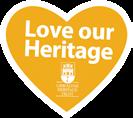

“The events that the Trust organises allow me and my partner to explore places that we simply would not have seen without the help and knowledge of the Trust”

The Trust has a number of statutory and strategic functions to:
1.- Safeguard and enhance the quality and condition of Gibraltar’s historic environment.
2.- Promote wider understanding, enjoyment and appreciation of Gibraltar’s historic environment.
3.- Enhance Gibraltar’s Sense of Place.
4.- Encourage relevant bodies to make Gibraltar’s historic areas better places to live, visit and to invest in.
5.- Work with others to amplify the impact of the wider initiatives to improve the city and make Gibraltar a better place to live, visit and invest in.
6.- Work towards the implementation and enforcement of new heritage legislation, policies and guidelines.
7.- Be open, responsive, transparent, effective and efficient in our work.
By investing in the Trust you are investing in Gibraltar’s past, its present and its future.
With your annual membership, you support Gibraltar and the work that the Trust does to protect and enhance it, however, your membership also entitles you to:
• Access to the Trust’s monthly programme of events, including trips and organised excursions.

• Access, by appointment, to the Trust’s reference library of books related to Gibraltar and its past. (The Trust is accepting donations of books on Gibraltar to add to this resource).
• Free entry to the Gibraltar Museum.
• Free entry to the Upper Rock Nature Reserve, St Michael’s Cave, Great Siege Tunnels, Military Heritage Centre, Tower of Homage, Ape’s Den, Windsor Suspension Bridge and WWII Tunnels.
• Annual report, our regular e-newsletter direct to your inbox, updates and information on what’s happening on the Gibraltar heritage scene.
• Discounts and deals from local businesses added throughout the year.
• Discounts on all Gibraltar Heritage Trust Publications in our shop.

Gibraltar Heritage Trust
The Main Guard
13 John Mackintosh Square PO Box 683, Gibraltar t. (+350) 200 42844 admin@gibraltarheritagetrust.org.gi www.gibraltarheritagetrust.org.gi
27
JOIN US NOW VIA OUR WEBSITE OR POP INTO OUR SHOP

How to get cities cycling The Dutch way
Cómo lhacer que las ciudades pedaleen. La manera holandesa.
Author: Sarah Birch
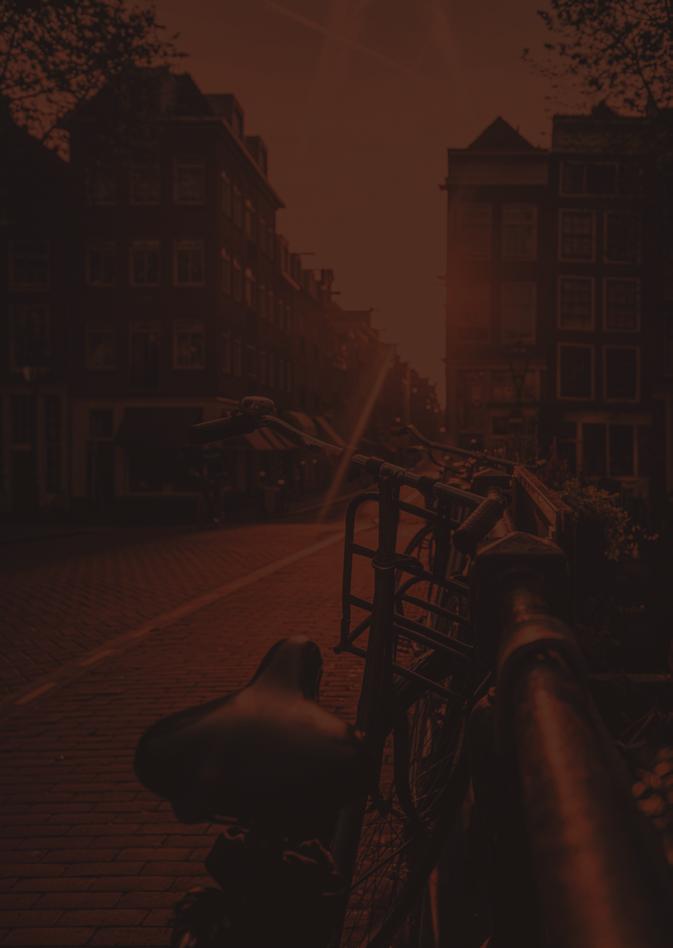
How did cycling become so popular in the Netherlands in the first place?
The bicycle was a staple of Dutch life before World War II, but like the rest of Europe, cars took off during the 1950s and 60s and became the predominant mode of transport.
Following a spate of car accidents in the early 1970s resulting in more than 3000 deaths, 450 of which were children, the Dutch rallied together to demand safer road and cycling conditions.
Then in 1973, the Middle East oil crisis that caused oil prices to soar and its availability to plummet also led to a loss of trust in the sustainability of motorised vehicles.
These factors resulted in the Dutch Government focusing more on cycling infrastructure, and urban planning became far less car-centric.
Safe and widespread cycling infrastructure, together with roads that are not the sole terrain of motorised vehicles, has made cycling easy and inviting for everyone. City centres have segregated cycling lanes, cyclists are given priority at roundabouts, and on narrow streets with little space, signs display the words; ‘bike
¿Cómo se hizo tan popular el ciclismo en los Países Bajos?
La bicicleta era un elemento básico de la vida holandesa antes de la Segunda Guerra Mundial, pero, como en el resto de Europa, los coches despegaron durante los años 50 y 60 y se convirtieron en el medio de transporte predominante.
Tras una avalancha de accidentes de tráfico a principios de los años 70, que provocó más de 3.000 muertes, 450 de ellas de niños, los holandeses se unieron para exigir unas condiciones más seguras para las carreteras y la bicicleta.
Luego, en 1973, la crisis del petróleo en Oriente Medio, que hizo que los precios del petróleo se dispararan y su disponibilidad cayera en picado, también provocó una pérdida de confianza en la sostenibilidad de los vehículos motorizados.
Estos factores hicieron que el gobierno holandés se centrara más en la infraestructura ciclista, y la planificación urbana se volvió mucho menos centrada en el automóvil.
Una infraestructura ciclista segura y generalizada, junto con unas carreteras que no son el único terreno
28 OTWO 26 / SEPTEMBER 2021 OTWO 26 / SEPTEMBER 2021 29
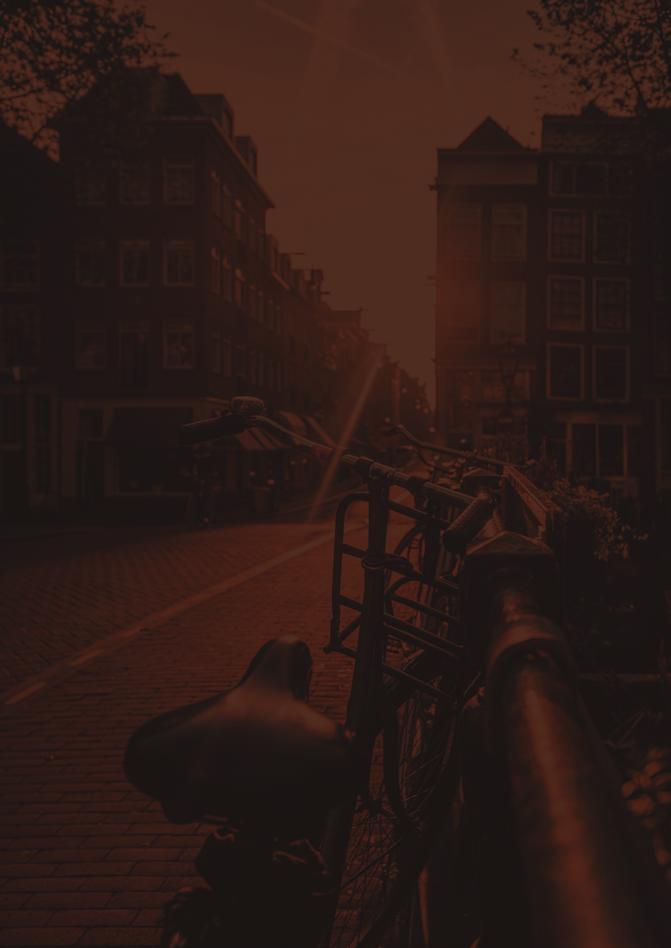
street: cars are guests’. Both types of vehicles can use these roads, but cars must slow down and give way to bicycles.
Cycling is also a part of Dutch life from a young age. Cycling proficiency is a mandatory part of the school curriculum with children made to pass a cycling safety exam in primary school. Young people are used to seeing bicycles on roads and accustomed to seeing their parents get around by bike. Parents often use cargo-style bikes to travel with their babies and toddlers. Together with robust safety measures and infrastructure, many continue to cycle when they become adults.
Most journeys are short and easy, not just because of Holland’s flat terrain but also due to its many densely populated urban areas. Segregated bike paths help further by making a ride to the supermarket or to work relaxed and comfortable, with very few people wearing helmets.
Lastly, because practically everyone in the Netherlands knows how to ride a bicycle, car drivers are much more considerate towards cyclists. Cyclists not only feel protected due to the rigorous safety measures in place across the country, but drivers are aware that roads are not exclusively for cars and treat those who ride bikes accordingly.
More cycling = A better Netherlands
More than 25% of all journeys in the Netherlands are made by bicycle, more than any other country in the world, cycling also continues to rise year on year, particularly amongst younger people. However, research shows that more than half of all car journeys are less than 7.5km, so they continue to work on ways to encourage even more citizens to get on their bikes.
In 2012, the Dutch Government issued a decree declaring that all new residential and utility buildings must include appropriate bicycle facilities, such as bicycle parking and storage.
Then in 2018, hundreds of millions of euros were set aside to boost regional cycling projects to get another 200,000 people across the country cycling. The money went towards upgrading existing infrastructure, constructing new cycle routes, 25,000 new bike stands and employer cycling schemes.
The Cycling and Dutch National Infrastructure Handbook, published by the Ministry for Infrastructure and Water Management, sets out plans to entice more peo-
de los vehículos motorizados, ha hecho que el uso de la bicicleta sea fácil y atractivo para todos. Los centros de las ciudades tienen carriles bici segregados, los ciclistas tienen prioridad en las rotondas y en las calles estrechas con poco espacio, las señales muestran las palabras: «calle para bicicletas: los coches son invitados». Ambos tipos de vehículos pueden utilizar estas vías, pero los coches deben reducir la velocidad y ceder el paso a las bicicletas.
El ciclismo también forma parte de la vida holandesa desde una edad temprana. El dominio de la bicicleta es una parte obligatoria del currículo escolar, y los niños tienen que pasar un examen de seguridad ciclista en la escuela primaria. Los jóvenes están acostumbrados a ver bicicletas en las carreteras y a que sus padres se desplacen en bicicleta. Los padres suelen utilizar bicicletas de tipo carga para viajar con sus bebés y niños pequeños. Junto con las sólidas medidas de seguridad y las infraestructuras, muchos siguen utilizando la bicicleta cuando se hacen adultos.
La mayoría de los trayectos son cortos y fáciles, no sólo por el terreno llano de Holanda, sino también por sus numerosas zonas urbanas densamente pobladas. Los carriles bici segregados ayudan aún más a que un viaje al supermercado o al trabajo sea relajado y cómodo, y muy poca gente lleva casco.
Por último, como prácticamente todo el mundo en Holanda sabe montar en bicicleta, los conductores de coches son mucho más considerados con los ciclistas. Los ciclistas no sólo se sienten protegidos gracias a las rigurosas medidas de seguridad que se aplican en todo el país, sino que los conductores son conscientes de que las carreteras no son exclusivamente para los coches y tratan a los que van en bicicleta en consecuencia.
Más ciclismo = Una mejor Holanda
Más del 25% de los desplazamientos en Holanda se realizan en bicicleta, más que en cualquier otro país del mundo, y el uso de la bicicleta sigue aumentando año tras año, sobre todo entre los más jóvenes. Sin embargo, las investigaciones demuestran que más de la mitad de los desplazamientos en coche son de menos de 7,5 km, por lo que siguen trabajando en formas de animar a más ciudadanos a subirse a la bicicleta.

31 OTWO 26 / SEPTEMBER 2021 30 OTWO 26 / SEPTEMBER 2021


ple to cycle by incorporating cycling in decisions relating to national-level infrastructure. The plans are aligned with Government objectives to get 200,000 commuters out of traffic congestion, increase distances travelled by bike by 20% and make the bicycle a fully-fledged, equivalent alternative in accessibility projects.
Some of the methods outlined to include cycling in new infrastructure plans include increasing infrastructure for cyclists who travel to public transport hubs, considering the increased use of E-bikes by the general public and businesses and how to decrease cycling accidents and increase safety.
The Dutch Cycling Embassy also gives examples of existing Dutch projects that have included cycling in infrastructure plans and best practices for new projects. Successful projects have involved creating cycling infrastructure that is not just functional but attractive, making intersections safer, improving signage, increased and improved parking facilities and increasing infrastructure by creating more car-free streets.
The focus is not just on infrastructure, commuters and younger people; national campaigns also want to keep people cycling as they get older. The CycleOn in your city – Safe Cycling Programme aims to raise awareness amongst elderly cyclists on how to continue cycling safely. Cycling is still popular in the Netherlands amongst older citizens, but by focusing on education and safety awareness, the hope is that more will continue to use their bikes.
The Netherlands is light years ahead of most countries in recognising all of the benefits bicycles can offer. They know that cycling is not just an economical way for everyone to get around; but more cyclists mean economic benefits for businesses, improved health and wellbeing, more green spaces, increased mobility and accessibility for all and tremendous environmental benefits such as cleaner air and reduced carbon emissions.
Even as a world leader in cycling uptake and infrastructure, the Netherlands continues to work towards creating cleaner, safer and accessible urban areas and expand the bicycles reach beyond city limits. The Netherlands understands and has proven time and time again that by providing its citizens with ease of access, more space and a safe environment for all road users, that cycling can become a viable and popular mode of transport for people of all ages.
En 2012, el gobierno holandés promulgó un decreto por el que se declaraba que todos los nuevos edificios residenciales y de servicios públicos debían incluir instalaciones adecuadas para las bicicletas, como aparcamientos y almacenes para las mismas. Luego, en 2018, se reservaron cientos de millones de euros para impulsar proyectos regionales de uso de la bicicleta con el fin de que otras 200.000 personas de todo el país se subieran a ella. El dinero se destinó a la mejora de las infraestructuras existentes, a la construcción de nuevas rutas ciclistas, a 25.000 nuevos aparcamientos para bicicletas y a planes de ciclismo para empresarios.
El Manual de Infraestructuras Nacionales para la Bicicleta y los Países Bajos, publicado por el Ministerio de Infraestructuras y Gestión del Agua, establece planes para atraer a más personas a la bicicleta mediante la incorporación de la misma en las decisiones relativas a las infraestructuras de ámbito nacional. Los planes están en consonancia con los objetivos del gobierno de sacar a 200.000 viajeros de la congestión del tráfico, aumentar las distancias recorridas en bicicleta en un 20% y hacer de la bicicleta una alternativa equivalente en los proyectos de accesibilidad.
Algunos de los métodos expuestos para incluir la bicicleta en los nuevos planes de infraestructuras son el aumento de las infraestructuras para los ciclistas que se desplazan a los centros de transporte público, la consideración del aumento del uso de las bicicletas eléctricas por parte del público en general y de las empresas, y la forma de disminuir los accidentes ciclistas y aumentar la seguridad.
La Embajada Neerlandesa de la Bicicleta también da ejemplos de proyectos neerlandeses existentes que han incluido la bicicleta en los planes de infraestructuras y las mejores prácticas para los nuevos proyectos. Los proyectos que han tenido éxito han consistido en crear una infraestructura ciclista que no sólo sea funcional sino atractiva, en hacer más seguras las intersecciones, en mejorar la señalización, en aumentar y mejorar los aparcamientos y en aumentar la infraestructura creando más calles sin coches.
La atención no se centra únicamente en las infraestructuras, los desplazamientos al trabajo y los jóvenes; las campañas nacionales también quieren que la gente siga montando en bicicleta a medida
32 OTWO 26 / SEPTEMBER 2021 33 OTWO 26 / SEPTEMBER 2021

que envejece. El programa «CycleOn en tu ciudad, Ciclismo seguro» pretende concienciar a los ciclistas de edad avanzada sobre cómo seguir montando en bicicleta de forma segura. El ciclismo sigue siendo popular en los Países Bajos entre los ciudadanos de más edad, pero al centrarse en la educación y la concienciación sobre la seguridad, se espera que sean más los que sigan utilizando la bicicleta.
Los Países Bajos están a años luz de la mayoría de los países en el reconocimiento de todos los beneficios que puede ofrecer la bicicleta. Saben que el uso de la bicicleta no es sólo una forma económica de desplazarse, sino que más ciclistas significan beneficios económicos para las empresas, mejora de la salud y el bienestar, más espacios verdes, mayor movilidad y accesibilidad para todos y enormes beneficios medioambientales, como un aire más limpio y menos emisiones de carbono.
Incluso como líder mundial en la adopción de la bicicleta y sus infraestructuras, Holanda sigue trabajando para crear zonas urbanas más limpias, seguras y accesibles, y para ampliar el alcance de las bicicletas más allá de los límites de la ciudad. Los Países Bajos entienden y han demostrado una y otra vez que, si proporcionan a sus ciudadanos facilidad de acceso, más espacio y un entorno seguro para todos los usuarios de la carretera, la bicicleta puede convertirse en un modo de transporte viable y popular para personas de todas las edades.
OTWO 26 / SEPTEMBER 2021 35 34 OTWO 26 / SEPTEMBER 2021
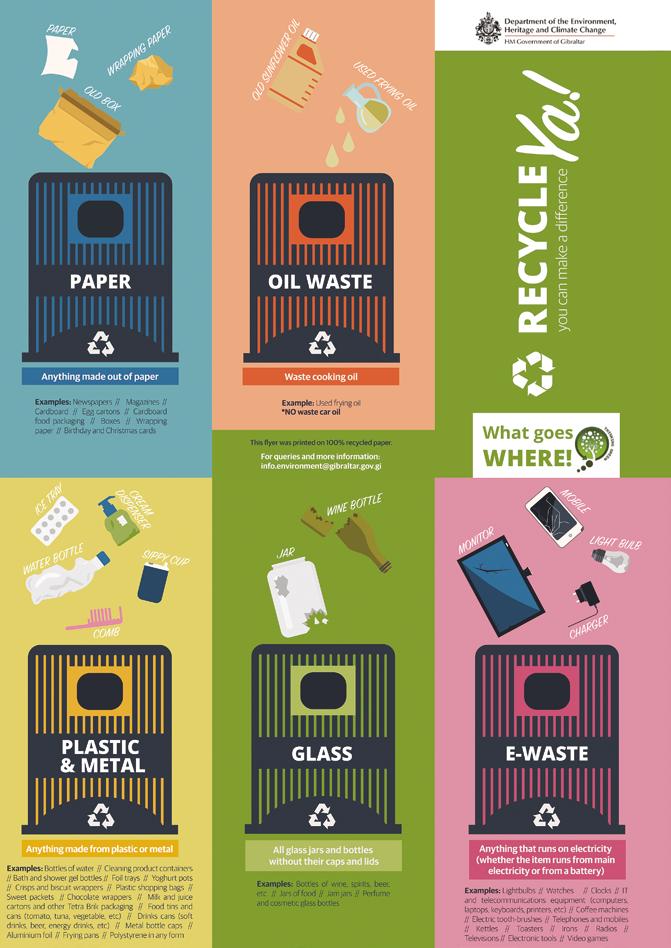


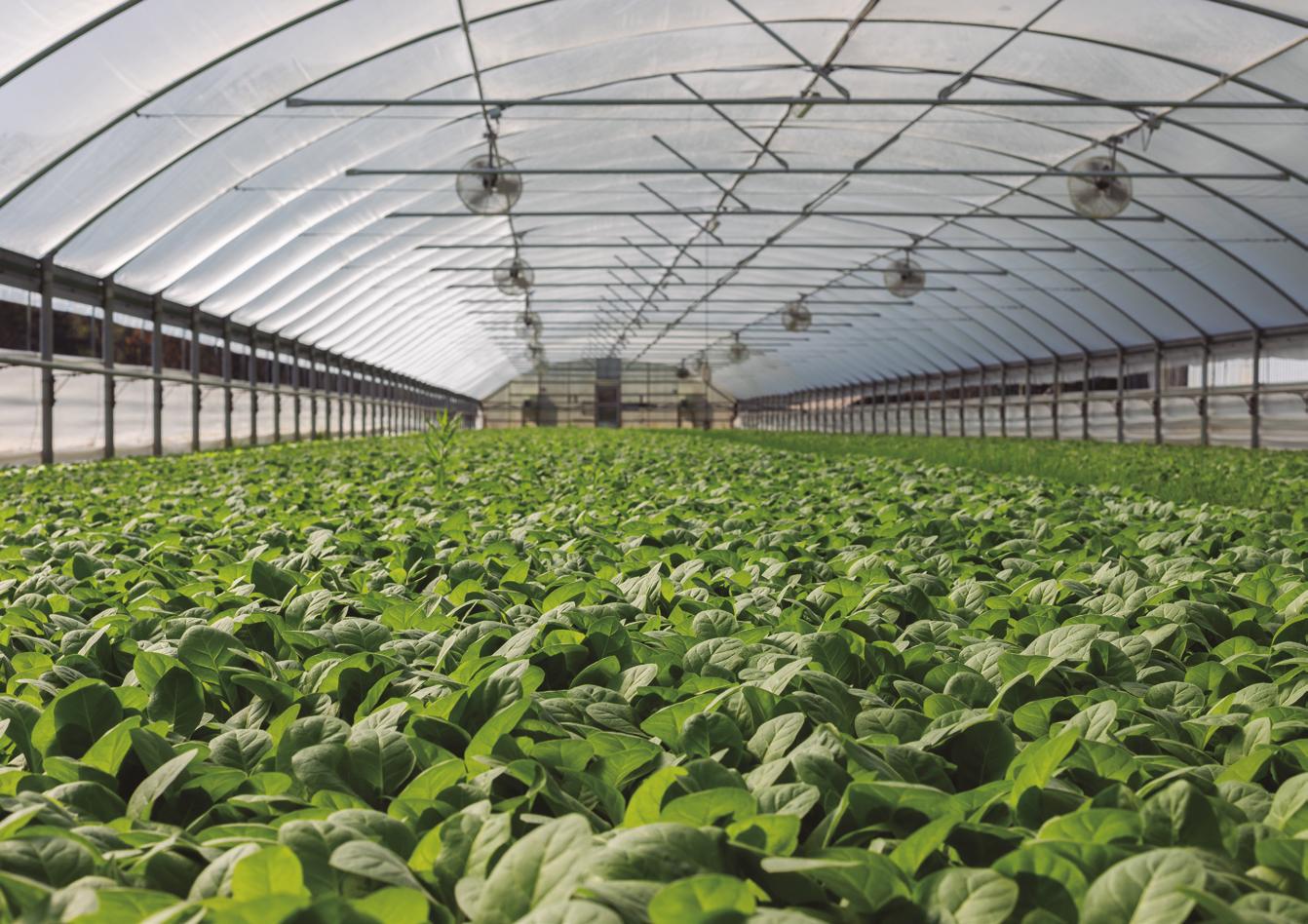
Solar greenhouses in Almeria in transition to Circular Economy models.
Los invernaderos solares de Almería en transición hacia modelos de Economía Circular.
Author: Juan José Amate Ruiz. Ambientólogo y Sociólogo. Director de Sostenibilidad a Medida. Consultor.
One of the great challenges facing humanity in this 21st century is its capacity to ensure sufficient and nutritious food in the year 2050, taking into account that the world population will continue to grow and that the current degradation of already scarce natural resources must be halted. There are no perfect solutions, but one of the food production models that has been pointed out as a solution to solve this problem is the intensive agricultural production model under plastic in Almeria. The origin of this statement is the report “Acting before it is too late: making agriculture truly sustainable for food security in a changing climate”, prepared for the UN Conference on Environment and Development (UNCED). , prepared for the UN Conference on Trade and Development which in 2013 brought together more than 60 international experts who put forward different theses to overcome the current models of industrial, conventional and extensive monoculture-based extensive food production, with a high dependence on external inputs such as fertilizers, agrochemicals and concentrated feed and which hardly contribute to regional development.
Uno de los grandes retos que afronta la humanidad en este siglo XXI es su capacidad para asegurar una alimentación suficiente y nutritiva en el año 2050, teniendo en cuenta que la población mundial va a seguir creciendo y además hay que frenar la actual degradación de los recursos naturales ya de por sí escasos. No existen soluciones perfectas, pero uno de los modelos de producción alimentaria que se señalan como solución para resolver esta problemática es el modelo de producción agrícola intensiva bajo plástico de Almería. El origen de esta afirmación es el informe «Actuar antes de que sea demasiado tarde: hacer que la agricultura sea verdaderamente sostenible en aras de la seguridad alimentaria en un clima cambiante», elaborado para la Conferencia de la ONU sobre comercio y desarrollo que en 2013 reunió a más de 60 expertos internacionales que plantearon diferentes tesis para superar los modelos actuales de producción industrial, convencional y basada en el monocultivo extensivo de alimentos, con una gran dependencia de insumos externos como fertilizantes, productos agroquímicos y piensos concentrados y que apenas contribuyen al desarrollo regional.
OTWO 26 / SEPTEMBER 2021 39 38 OTWO 26 / SEPTEMBER 2021
Although the model of intensive agriculture under plastic developed in Almeria for more than 50 years has proven to be capable of supplying Europe with vegetables while creating wealth and development in one of the most depressed areas of Spain in the middle of the 20th century and being an example in the efficient use of resources such as water and soil, it is no less true that it still needs to address different aspects to be able to claim that it is a sustainable model from an environmental, economic and social point of view.
In this regard, the Instituto de Es tudios Almerienses published at the end of 2020 the study “Closing cycles in intensive agriculture under plastic. The Circular Economy applied to the agroindustry of Almeria”. This publication serves as an approximation of the Circular Economy model to intensive agriculture under plastic in Almeria and brings together the vision that the sector has on the adoption of this model.
Sustainable or Circular?
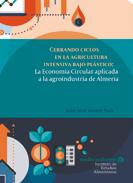
Si bien el modelo de agricultura intensiva bajo plástico desarrollado en Almería durante más de 50 años ha demostrado ser capaz de abastecer a Europa de hortalizas a la vez que crear riqueza y desarrollo en una de las zonas más deprimidas de España mediado el siglo XX y ser ejemplo en la eficiencia en el uso de recursos como el agua o el suelo, no es menos cierto que aún debe abordar diferentes aspectos para poder afirmar que se trata de un modelo sostenible desde un punto de vista ambiental, económico y social.
En ese sentido, el Instituto de Estudios Almerienses publicó a finales de 2020 el estudio «Cerrando ciclos en la agricultura intensiva bajo plástico. La Economia Circular aplicada a la agroindustria de Almería». Esta publicación sirve como aproximación del modelo de Economía Circular a la agricultura intensiva bajo plástico de Almería y reúne además la visión que el sector tiene sobre la adopción de este modelo.
¿Sostenible o Circular?
One of the first issues addressed by the study is the differentiation between Sustainability and Circular Economy. Although sometimes sustainable and circular are used as synonyms when describing the commitment to reduce the impact of a model, project or company on the environment, we are not talking about the same thing.
By circular we mean a system that adopts the principles of the Circular Economy, an economic model that promotes development decoupled from the consumption of raw materials. Its intention is to “close the circle”, maintaining the value of material resources, products or services for as long as possible, avoiding waste.
In the case of intensive agriculture under plastic in Almeria, its sustainability model is focused on eco-efficiency in the consumption of resources, reduced to a minimum and having minimized the impact in the form of harmful substances this emits to the environment. However, this efficiency only improves a linear model, but does not contribute to its circularity. Initiatives such as the Farm to Table
Una de las primeras cuestiones que aborda el estudio es la diferenciación entre Sostenibilidad y Economía Circular. Aunque a veces sostenible y circular se usen como sinónimos a la hora de describir el compromiso por reducir su impacto en el entorno de un modelo, proyecto o empresa, no estamos hablando de lo mismo.
Por circular entendemos aquel sistema que adopta los principios de la Economia Circular, un modelo económico que promueve el desarrollo desacoplado del consumo de materias primas. Su intención es «cerrar el círculo», manteniendo el valor de los recursos materiales, productos o servicios durante el mayor tiempo posible, evitando los residuos. En el caso de la agricultura intensiva bajo plástico de Almería, su modelo de sostenibilidad está centrado en la ecoeficiencia en el consumo de recursos, reducido al mínimo y haber minimizado el impacto en forma de sustancias nocivas este emite al entorno. Sin embargo, esta eficiencia sólo mejora un modelo lineal, pero no contribuye a la circularidad del mismo. Iniciativas como la Estrategia de la Granja a la Mesa, que forma parte del Pacto Verde Europeo,
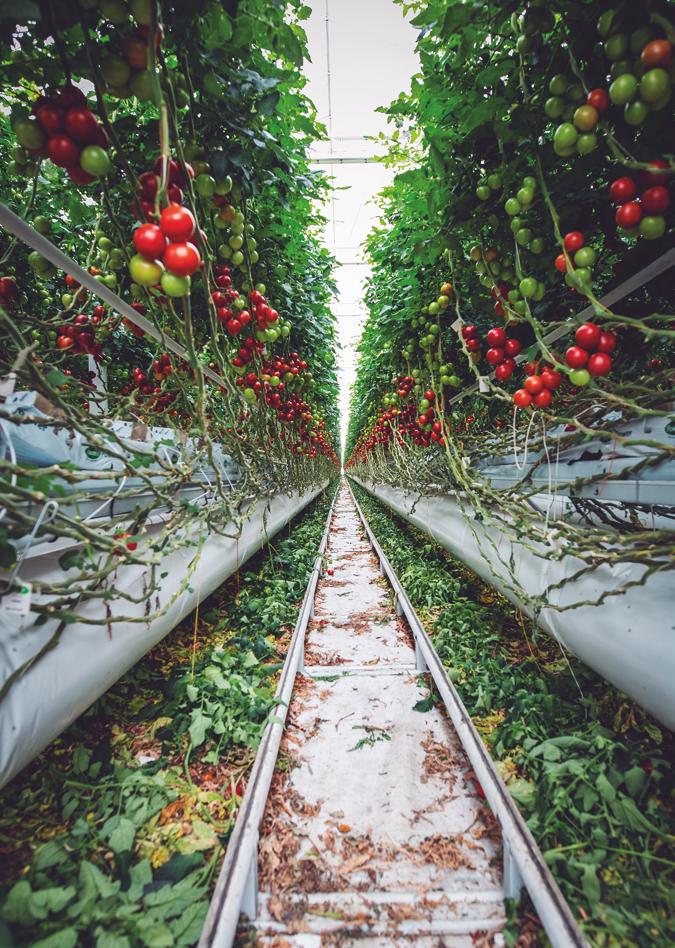
40 OTWO 26 / SEPTEMBER 2021
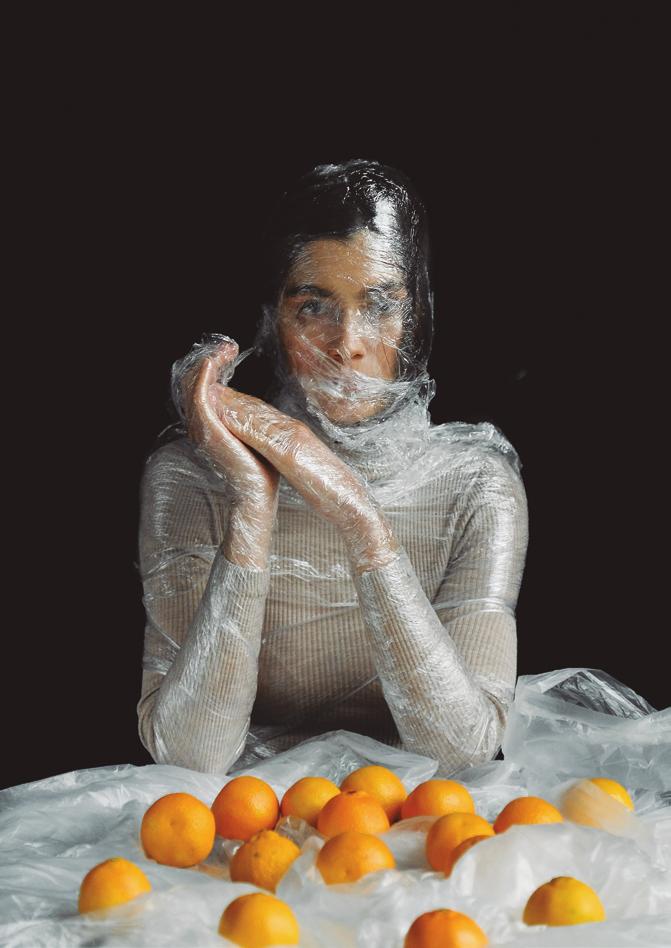
Strategy, which is part of the European Green Pact, advocate sustainable and circular food production systems, therefore, this is the transition in which the sector is currently immersed.
As pointed out by the Ellen McArthur Foundation, a reference entity in terms of circular economy worldwide, consumer goods industries, including agribusiness, seem to be locked in a linear production paradigm. The challenge they face is to break out of this confinement and continue adopting the five principles that this entity points out as basic in the Circular Economy:
- Design without waste. The vegetables produced in Almeria’s greenhouses qualify as zero waste due to the absence of phytosanitary products and other chemical substances, but we must move towards production methods without waste of any kind, the rest lies in the use of plastics for covers and packaging and also in optimizing fertilization.
- Building resilience through diversity. This is not only about crop diversity, but also about promoting on-farm biodiversity, which has proven to be the most effective way to fight pests and diseases.
- Based on renewable energies. One of the hallmarks of the so-called Almeria solar greenhouses is precisely that solar energy is their main source of energy supply.
- Systemic approach. Identifying and attending to the links with other sectors and environments, for example the ecosystem services that allow aquifer recharge.
- Waste is food. Taking advantage of food loss and waste as a nutrient, the field of work of the Circular Bioeconomy in Andalusia.
A committed, innovative sector
The opinion of the sector is included in the study through interviews with representatives of companies, research and knowledge centers and other entities such as environmental groups or trade unions.
They all emphasize the sector’s capacity for innovation and affirm that it will be able to address the changes involved in the transition to more circular and sustainable practices and processes. However, they believe that this will be something that will be achieved in the medium term and needs external support, especially in the form of knowledge to identify
abogan por sistemas de producción alimentaria sostenibles y circulares, por tanto esta es la transición en la que está sumida actualmente el sector.
Como señalan desde la Ellen McArthur Fundation, una entidad de referencia en materia de economía circular a nivel mundial, las industrias de bienes de consumo entre las que incluyo la agroindustria, parecen estar encerradas en un paradigma de producción lineal. El reto que abordan es salir de ese encierro y seguir adoptando los cinco principios que esta entidad señala como básicos en la Economía Circular:
- Diseño sin residuos. Las hortalizas que producen los invernaderos de Almería se califican residuo cero por la ausencia de fitosanitarios y otras sustancias químicas, pero hay que avanzar hacia modos de producción sin residuos de ningún tipo, el resto está en el uso de plásticos para cubiertas y envases y también en optimizar la fertilización.
- Construir resiliencia a través de la diversidad. No sólo se trata de diversidad de cultivos, sino con el fomento de biodiversidad en las explotaciones agrícolas, que se ha revelado como forma más eficaz de lucha frente a plagas y enfermedades.
- Basado en energías renovables. Una de las señas de identidad de los llamados invernaderos solares de Almería es precisamente que la energía solar es su principal fuente de abastecimiento energético.
- Enfoque sistémico. Identificar y atender a los vínculos con otros sectores y entornos, por ejemplo los servicios ecosistémicos que permiten la recarga de acuíferos.
- El desperdicio es comida. Aprovechar la pérdida y el desperdicio alimentario como nutriente, el campo de trabajo de la Bioeconomía circular en Andalucía.
Un sector comprometido e innovador La opinión del sector se integra en el estudio a través de entrevistas realizadas a representantes de empresas, centros de investigación y conocimiento y otras entidades como grupos ecologistas o sindicatos.
Todos ponen de relevancia la capacidad de innovación del sector y afirman que será capaz de abordar los cambios que suponen la transición hacia prácticas y procesos más circulares y sostenibles. Si bien creen que será algo que se logrará a medio plazo y necesita el apoyo externo, sobre todo en forma
OTWO 26 / SEPTEMBER 2021 43 42 OTWO 26 / SEPTEMBER 2021
good practices, although they believe that support in the form of economic resources would also accelerate this transition. One reflection that stands out to me is the one that states that the sector “has always innovated based on muscle, but in this case (in reference to the circular economy) it is going to have to do it based on brains”.
The study is available for download on the website of the Institute of Almerian Studies and as an environmentalist author of the study, I believe that environmentalists have a key role to play in promoting Circular Economy models, and in the case of intensive agriculture in Almeria, we are participating in this transition.
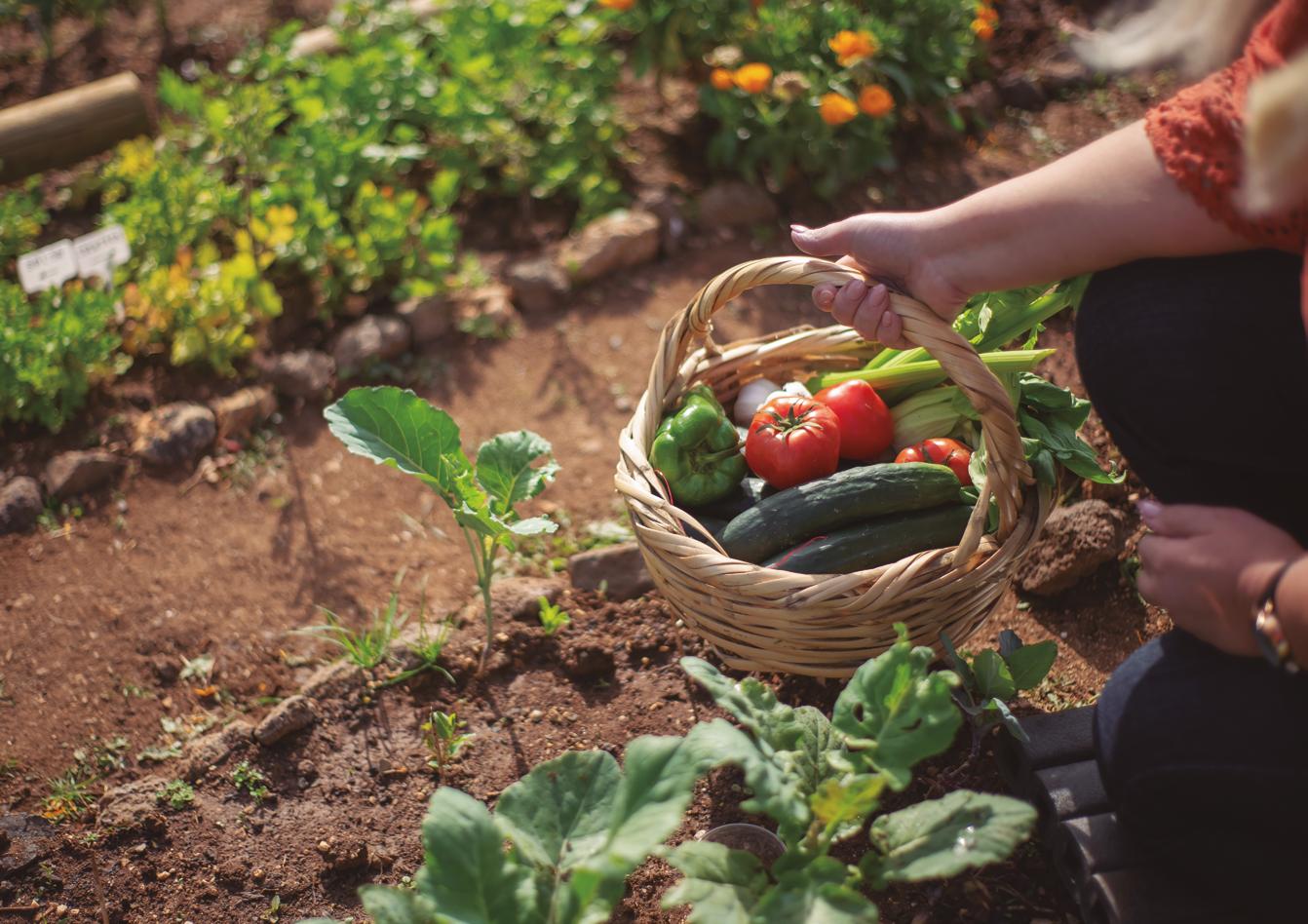
de conocimiento para identificar buenas prácticas, aunque creen que el apoyo en forma de recursos económicos también aceleraría esta transición. Una reflexión que me parece muy destacada es la que afirma que el sector «siempre ha innovado a base de músculo, pero en este caso (en referencia a la economía circular) va a tener que hacerlo a base de cerebro».
El estudio está disponible para su descarga en la página del Instituto de Estudios Almerienses y como ambientólogo autor de dicho estudio, creo que los ambientólogos tenemos un papel clave para el impulso a los modelos de Economía Circular, y en el caso de la agricultura intensiva de Almería, estamos siendo partícipes de esta transición.
OTWO 26 / SEPTEMBER 2021 45 44 OTWO 26 / SEPTEMBER 2021


RECOVERING THE LAGOON OF LA JANDA, A DREAM ACHIEVABLE THANKS TO ITS FRIENDS’ ASSOCIATION
The friends of the Laguna de la Janda Association Recuperar la Laguna de la Janda, un sueño alcanzable gracias a su asociación de amigos.
OTWO 26 / SEPTEMBER 2021 49 48 OTWO 26 / SEPTEMBER 2021
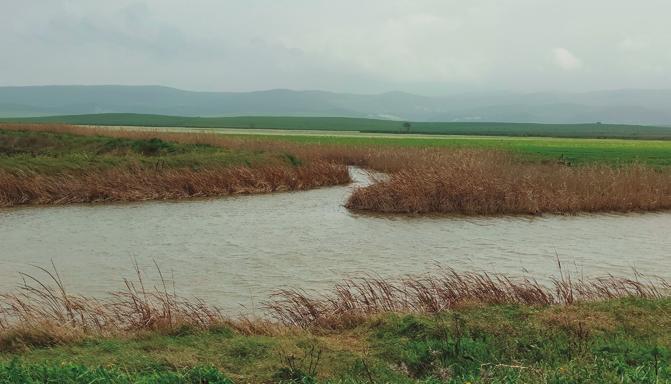

A look into the past.
The Janda Lagoon was the largest wetland in the Iberian Peninsula before it was drained. In the late nineteenth and early twentieth century hunters and naturalists who were fascinated by its natural, scenic and cultural values and left written records of its richness, entered this sea of water and vegetation. Among them there were English military, due to the proximity to the Rock of Gibraltar, hunting enthusiasts and passionate about birds (W. Verner, L. Irby) and aristocrats linked to the wine region of Jerez and Sanlúcar (A. Chapman, J. Buck). Spanish naturalists such as José Luis Bernaldo de Quirós and Francisco Bernis (a Spanish zoologist who witnessed the breeding of the last cranes in La Janda) also visited this wetland and were impressed by the exuberance of this area. Thanks to their testimonies, we can get an idea of the importance of La Janda and the great biodiversity that it harbored; such was its importance throughout history that it has given its name to an entire region. In addition to its incalculable natural value, La Janda was also an important source of food and materials for the construction of houses (castanets, bulrushes, reeds, etc.) and utensils for daily life.
Much earlier in time, in the late Paleolithic and early Neolithic the special location of this enclave led to the settlement of our ancestors who left us as a legacy their paintings and engravings in the shelters of the surrounding mountains, among which are representations of birds, animals and human forms, which are considered by some experts in the field a unique style worldwide, with its greatest exponent in the cave of “Tajo de las Figuras”, in Benalup-Casas Viejas. Other types of funerary or symbolic monuments date from this period, such as dolmens and menhirs, as well as anthropomorphic tombs, the latter of more uncertain dating.
Desiccation.
In the mid-twentieth century, wetlands were considered unhealthy and unproductive areas due to the impossibility of practicing agriculture in them and because they were associated with diseases that had mosquitoes as vectors, such as malaria. At the end of the 1960s, after several failed attempts that began in the 19th century with the “Moret Conces-
Una mirada al pasado.
La laguna de la Janda fue antes de su desecación el humedal más grande de la Península Ibérica. A finales del siglo XIX y principios del XX se adentraban en ese mar de agua y vegetación cazadores y naturalistas que quedaron fascinados por sus valores naturales, paisajísticos y culturales y dejaron constancia escrita de su riqueza. Entre ellos había militares ingleses, por la cercanía al Peñón de Gibraltar, amantes de la caza y apasionados por las aves (W. Verner, L. Irby) y aristócratas vinculados al marco bodeguero de Jerez y Sanlúcar (A. Chapman, J. Buck). Visitaron también este humedal naturalistas españoles como José Luis Bernaldo de Quirós y Francisco Bernis (zoólogo español que fue testigo de la cría de las últimas grullas en la Janda) que quedaron también impresionados por la exuberancia de este espacio. Gracias a sus testimonios, podemos hacernos una idea de la importancia que tuvo La Janda y de la gran biodiversidad que albergaba; tal fue su importancia a lo largo de la historia que ha dado su nombre a toda una comarca. Además de su incalculable valor natural, La Janda era también una importante fuente de alimento y de materiales para la construcción de viviendas (castañuela, enea, cañas, etc.) y utensilios para la vida cotidiana.
Mucho antes en el tiempo, a finales del paleolítico y principios del neolítico la ubicación tan especial de este enclave propició el asentamiento de nuestros antepasados que nos dejaron como legado sus pinturas y grabados en los abrigos de las sierras circundantes, entre las que aparecen representaciones de aves, animales y formas humanas, que son consideradas por algunos expertos en la materia un estilo único a nivel mundial, con su máximo exponente en la cueva del «Tajo de las Figuras», en Benalup-Casas Viejas. Datan de esa época también otro tipo de monumentos de carácter funerario o simbólico como dólmenes y menhires así como tumbas antropomorfas, estas últimas de datación más incierta.
La desecación.
A mediados del siglo XX, los humedales eran considerados zonas insalubres e improductivas por la imposibilidad de practicar la agricultura en ellos y por asociarse con enfermedades que tenían como vectores los mosquitos, como era el paludismo. A
50 OTWO 26 / SEPTEMBER 2021 OTWO 26 / SEPTEMBER 2021 51
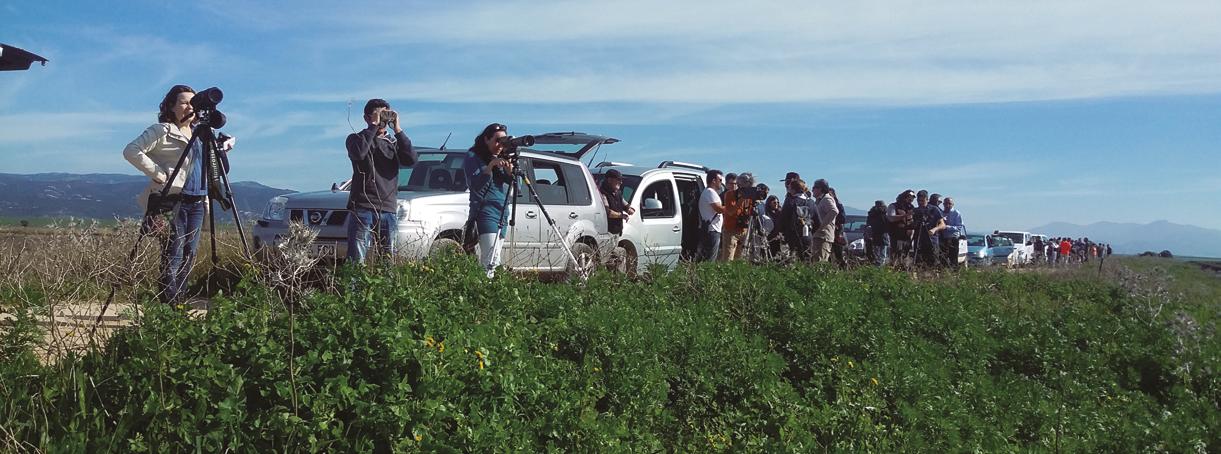
sion”, the desiccation process culminated, which led to a great loss of biodiversity, the disappearance of bird species such as the “torillo andaluz” (Turnix sylvaticus), the disappearance of nesting species due to the serious alteration of their habitat, and a great transformation of the vegetation, which was relegated to its original state only in marginal areas. The crane, whose only breeding center in southern Spain was the Janda, has since visited us only in the winter period.
Despite all the transformations suffered, even today it still maintains part of its natural wealth, which is enhanced by its privileged strategic location near the Strait of Gibraltar, which makes it a passage, resting and feeding area for countless birds that cross the Strait each year on their migrations. For this reason, it receives more and more visitors interested in ornithology.
Although its interest is recognized worldwide, there are many inhabitants of the environment who are unaware of its existence and its splendid past, being relegated to oblivion for many years, although it has remained in the memory of the cranes, which
finales de los años 60, tras varios intentos fallidos que se iniciaron en el siglo XIX con la «Concesión de Moret», culminó el proceso de desecación, que conllevó a una gran pérdida de biodiversidad, la desaparición de especies de aves como el «torillo andaluz» (Turnix sylvaticus), la desaparición de especies como nidificantes por la grave alteración de su hábitat, y a una gran transformación de la vegetación que quedó relegada en su estado original sólo en zonas marginales. La grulla, que tenía como único núcleo reproductor en el sur de España la Janda, desde entonces nos visita sólo en el periodo invernal.
A pesar de todas las transformaciones sufridas, aún hoy en día mantiene parte de su riqueza natural, que se ve acrecentada por su privilegiada situación estratégica cerca del Estrecho de Gibraltar, que la convierte en una zona paso, descanso y alimentación para una infinidad de aves que atraviesan el Estrecho cada año en sus migraciones. Por este motivo, recibe cada vez más visitantes interesados en la ornitología.
Aunque su interés es reconocido a nivel mundial, son muchos los habitantes del entorno que desco-
each year remind us in their winter stay that the wetland survives and evoke that past that in those times not too distant was their home.
The Friends of the Laguna de la Janda Association.
Cristina Parkes, Honorary President of the Association, had the privilege of knowing the lagoon on a visit with her father when she was a child and was impressed since then of its richness; aware of the great loss that the desiccation meant, she founded in 1994 together with Paz Lerma the “ Friends of the Laguna de la Janda Association”, a non-governmental organization that today consists of about 80 members from various backgrounds and very different professional fields that share common goals: “the restoration of a representative part of the old wetland according to ecological criteria, the conservation and promotion of its flora and fauna and its habitats, its declaration as a protected natural area and the dissemination of its ecological values and its historical and cultural heritage”.
In its more than 25 years of history, the Associa-
nocen de su existencia y su pasado esplendoroso, quedando relegada al olvido durante muchos años, aunque ha permanecido en la memoria de las grullas, que cada año nos recuerdan en su estancia invernal que el humedal sobrevive y nos evocan ese pasado del que en aquellos tiempos todavía no muy lejanos fuera su hogar.
La Asociación de Amigos de la Laguna de la Janda.
Cristina Parkes, Presidenta de Honor de la Asociación, tuvo el privilegio de conocer la Laguna en una visita en compañía de su padre cuando era pequeña y quedó impresionada desde entonces de su riqueza; consciente de la gran pérdida que supuso la desecación fundó en 1994 junto con Paz Lerma la «Asociación de Amigos de la Laguna de la Janda», organización no gubernamental que a día de hoy la constituyen unos 80 socios de diversas procedencias y de muy diferentes campos profesionales que comparten unos objetivos comunes: «la restauración de parte representativa del antiguo humedal atendiendo a criterios ecológicos, la conservación y fomento
52 OTWO 26 / SEPTEMBER 2021 OTWO 26 / SEPTEMBER 2021 53
tion has been acting before the administrations to achieve the restoration and protection of the wetland. As the main achievement in this line of work, more than 6,000 hectares of land, which coincide with the lagoons that formed the wetland, have recently been recognized by the State Attorney’s Office as Public Hydraulic Domain.
Activities of a very diverse nature have also been carried out (sometimes with the collaboration of other NGOs), some of a scientific nature such as participation in bird censuses and studies, others aimed at disseminating the values, sometimes focused on a general public and others on specific educational or social sectors. These include conferences, lectures, workshops, exhibitions, and protest actions, collaborations in publications and media and presence in social networks, thus helping to keep alive in society the goal of recovering the Laguna de la Janda and its immense natural and cultural heritage for all.
Annually, coinciding with the “World Wetlands Day”, an “encounter with the cranes” is held, through which a guided visit is made by ornithological specialists to the surroundings of the lagoon to watch the cranes in their wintering season, and to observe many other species of birds in the area.
Among the works carried out, a traveling exhibition “La Janda, a wetland that we must recover” has been designed by a team of partners, aimed primarily at secondary school students, showing different aspects of La Janda and its environment (birds, history, geography, rock art, ethnography, etc.), and is also available to other entities that may be interested.
Aware of the importance of bringing children closer to the rich natural and cultural heritage of the environment of La Janda, since their future depends on them, a book has recently been published, “Alba and the Old Crane”, in bilingual edition (Spanish-English), a story that tells the adventures of a young crane in his first year of migration to La Janda, which has been distributed free of charge to primary schools in the region of Campo de Gibraltar and La Janda.
Also oriented to the dissemination of values, last year 2019 the “First Conference on Heritage and Nature of the Laguna de la Janda” was held, with the premise that La Janda is much more than “birds”, in which different topics related to the heritage of La Janda and other similar successful experiences
de su flora y fauna y sus hábitats, su declaración como espacio natural protegido y la difusión de sus valores ecológicos y su patrimonio histórico y cultural».
En sus más de 25 años de historia la Asociación viene actuando ante las administraciones para conseguir la restauración y protección del humedal. Como principal logro en esa línea de trabajo, recientemente han sido reconocidas por la abogacía del estado como Dominio Público Hidráulico más de 6000 Has. de terreno, que coinciden con las lagunas que formaban el humedal.
Se vienen realizando asimismo actividades de muy diversa naturaleza (con la colaboración en ocasiones de otras ONG), algunas de carácter científico como la participación en la realización de censos y estudios de aves, otras encaminadas a la difusión de los valores, a veces enfocadas a un público generalizado y otras a sectores concretos de ámbito educativo o social. Entre ellas se incluyen jornadas, charlas, talleres, exposiciones, acciones reivindicativas, colaboraciones en publicaciones y medios de comunicación y presencia en redes sociales, contribuyendo de esta manera a mantener vivo en la sociedad el objetivo de recuperar para todos la Laguna de la Janda y su inmenso patrimonio natural y cultural.
Anualmente, coincidiendo con el «Día mundial de los humedales» se celebra el «encuentro con las grullas», a través del que se realiza una visita guiada por especialistas ornitólogos al entorno de la Laguna para avistamiento de las grullas en su invernada, y para la observación de otras muchas especies de aves de la zona.
Entre los trabajos realizados, ha sido diseñada por un equipo de socios una exposición itinerante «La Janda, un humedal que debemos recuperar», orientada principalmente a alumnos de Educación Secundaria, que muestra diferentes aspectos de la Janda y de su entorno (avifauna, historia, geografía, arte rupestre, etnografía, etc.), estando además a disposición de otras entidades que puedan estar interesadas.
Conscientes de la importancia que tiene acercar a los más pequeños a la riqueza del patrimonio natural y cultural del entorno de la Janda, puesto que de ellos depende su futuro, se ha publicado recien-

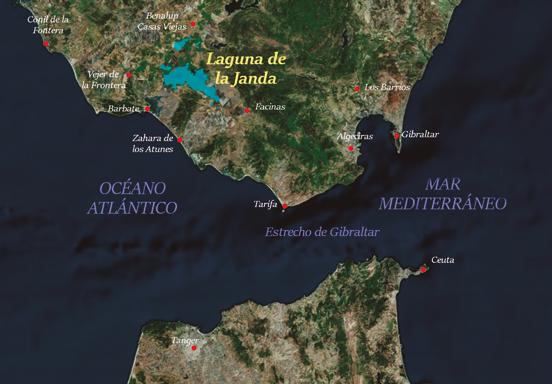
54 OTWO 26 / SEPTEMBER 2021 OTWO 26 / SEPTEMBER 2021 55

in other places were treated by experts, creating a space for dialogue that awakens or revives interest in this privileged environment.
A promising future:
In the past, wetlands were considered spaces to be eradicated, but today the situation has changed considerably. There is a growing awareness of the importance of conserving biodiversity in ecosystems and quality natural spaces. In view of the problems caused by climate change, wetlands in a good state of conservation are considered important carbon sinks that can contribute to fix an important part of the CO2 emitted into the atmosphere from the consumption of fossil fuels. The importance and necessity of “nature restoration” for the well-being of society is increasingly present in European policies. The restoration of the Laguna de La Janda is one of the most ambitious projects that currently exist in this regard.
On the other hand, the strategic location of La Janda next to the Strait of Gibraltar, makes it one of the main places in the world to observe bird migrations, and every year more and more ornithologists or bird enthusiasts visit it, every day increasing the demand for services related to ornithology, with the impact that this can have the hospitality sector, as it can become an important complement to the seasonality to which the beach tourism is subject.
La Janda is also located between the Natural Park of Los Alcornocales, the Parque Natural Del Estrecho and the Natural Park of La Breña y Marismas del Barbate, so the protection and recovery of this wetland would contribute to the creation of an important ecological corridor, thus helping to avoid the fragmentation of habitats in the area.
In addition to this enormous naturalistic attraction, the proximity of spectacular beaches, as well as the picturesque surrounding villages and the important historical and cultural heritage, sometimes as unknown as the Janda itself, and that never ceases to surprise us with discoveries of new archaeological remains, cave paintings, etc..
This opens a hopeful future for this unique area, with the forecasts of European funds “Next Generation”, which include the recovery of wetlands as projects of special interest to develop and with the
temente un libro, «Alba y la Vieja Grulla», en edición bilingüe (español-inglés), cuento que narra las aventuras de una grulla joven en su primer año de migración a la Janda, que ha sido distribuido gratuitamente a los centros de Educación Primaria de la comarca del Campo de Gibraltar y de la Janda. Orientadas también a la difusión de los valores, el pasado año 2019 se realizaron las «Primeras Jornadas de Patrimonio y Naturaleza de la Laguna de la Janda», con la premisa de que la Janda es mucho más que «aves», en la que fueron tratados por expertos diferentes temáticas relacionadas con el patrimonio de la Janda y con otras experiencias de éxito similares en otros lugares, creando un espacio de diálogo que despierte o reavive el interés por este entorno privilegiado.
Un futuro prometedor:
En tiempos pasados los humedales eran considerados espacios a erradicar, hoy en día la situación ha cambiado considerablemente. Cada día se es más consciente de la importancia que tiene conservar la biodiversidad en los ecosistemas, y espacios naturales de calidad. Ante la problemática suscitada a raíz del cambio climático, los humedales en buen estado de conservación se consideran como importantes sumideros de carbono que pueden contribuir a fijar una parte importante del CO2 que se emite a la atmósfera procedente del consumo de los combustibles fósiles. La importancia y necesidad de «restaurar naturaleza» para el bienestar de la sociedad está cada vez más presente en las políticas europeas. La restauración de la Laguna de La Janda es uno de los proyectos más ambiciosos que actualmente existen en este sentido. Por otra parte, la estratégica situación de la Janda junto al Estrecho de Gibraltar, la hace uno de los principales lugares en el mundo para observar las migraciones de aves, y cada año son más los ornitólogos o aficionados a las aves que la visitan, cada día mayor la demanda en servicios relacionados con la ornitología, con la repercusión que esto puede tener el sector de la hostelería, ya que puede llegar a suponer un importante complemento ante la estacionalidad al que está sometido el turismo de playa.
La Janda se encuentra además entre el Parque Natural de los Alcornocales, el Parque Natural Del Estrecho y el Parque Natural de la Breña y Marismas
56 OTWO 26 / SEPTEMBER 2021 OTWO 26 / SEPTEMBER 2021 57
inclusion by the Ministry of Ecological Transition of the recovery of the Janda as one of the main projects to be undertaken with such funds.
The Association of Friends of the Laguna de la Janda works for the recovery of this wetland since 1994 and numerous groups and organizations have joined her in this goal. Will we be able to make this great natural treasure again be a paradise of biodiversity for the enjoyment and benefit of all?
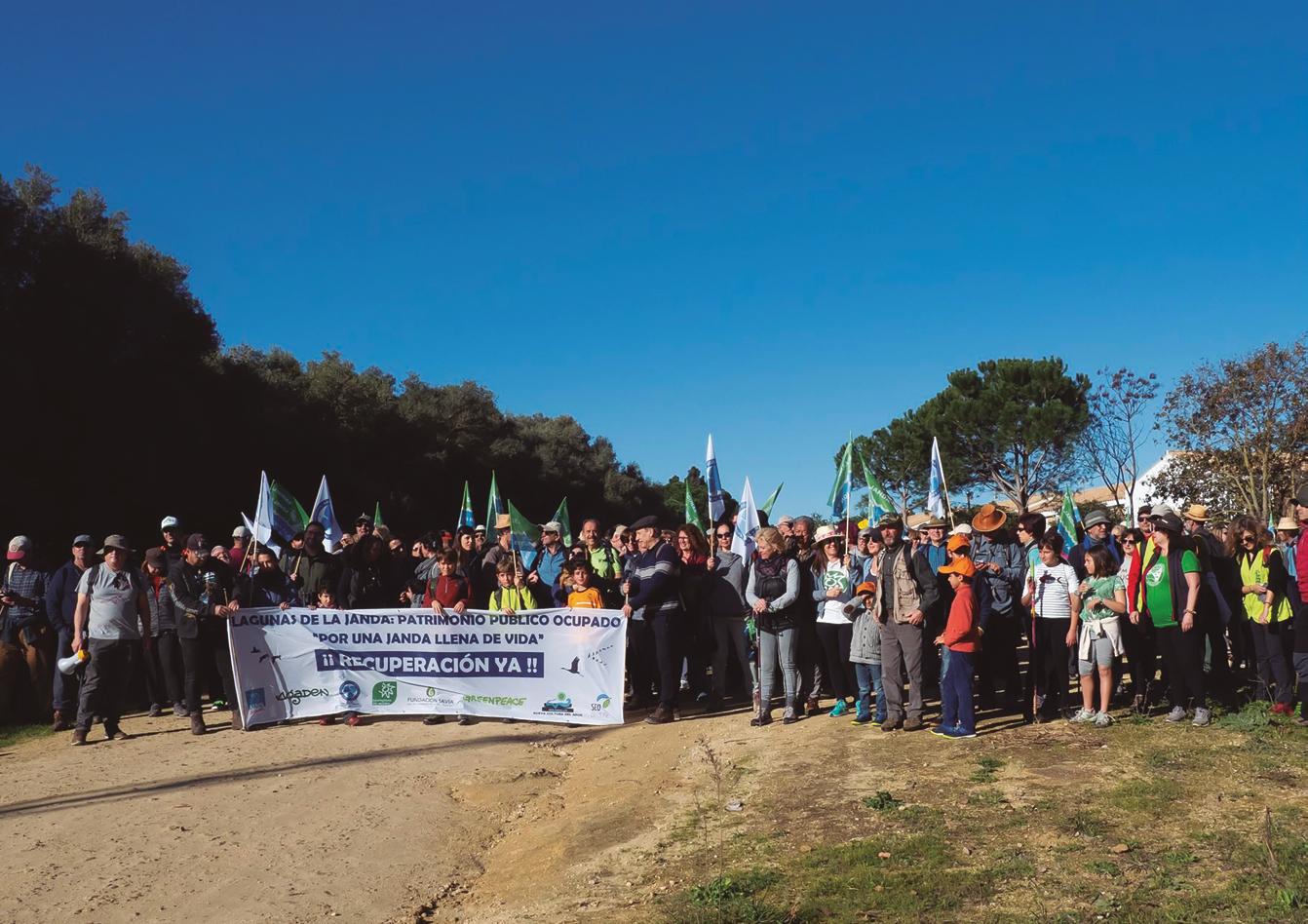
del Barbate por lo que la protección y recuperación de este humedal contribuiría a la creación de un importante corredor ecológico, contribuyendo así a evitar la fragmentación de los hábitats en la zona.
A este enorme atractivo naturalístico, se suman la cercanía de espectaculares playas, así como los pintorescos pueblos del entorno y el importante patrimonio histórico y cultural, tan desconocido a veces como la misma Janda, y que no deja de sorprendernos con descubrimientos de nuevos restos arqueológicos, pinturas rupestres, etc.
Se abre así un futuro esperanzador para este espacio tan singular, con las previsiones de fondos
europeos «Next Generation», que contemplan la recuperación de humedales como proyectos de especial interés a desarrollar y con la inclusión por parte del Ministerio de Transición Ecológica de la recuperación de la Janda como uno de los principales proyectos a acometer con tales fondos.
La Asociación de Amigos de la Laguna de la Janda trabaja por la recuperación de este humedal desde 1994 y numerosos colectivos y entidades se han sumado a ella en este objetivo. ¿Seremos capaces de lograr que este gran tesoro natural vuelva a ser un paraíso de biodiversidad para el disfrute y beneficio de todos?.
OTWO 26 / SEPTEMBER 2021 59 58 OTWO 26 / SEPTEMBER 2021


Wastage Products Ltd
AquaGib
Monique’s Bistro
Eroski Mas Cafe
O’Reilly’s Jury’s Cafe
Gibraltar Arms
Bridge Bar & Grill
Westside Secondary School
The Lord Nelson
Victoria Stadium Complex
Bistro Point
St Bernard’s Upper Primary School
Alameda Wildlife
Conservation Park (AWCP)
John Mackintosh Hall
Blands Travel
The Star Bar
The Britannia Bar

The Three Owls
Trusted Novus Bank
Paper Cloud
University of Gibraltar
Little English
Europa FC Academy
Domino’s Pizza
Risso’s Daily
Soul Kitchen
Europa Rugby Facilities
SUMMER LIFEGUARD POSTS
Little Bay
Camp Bay
Eastern Beach
Western Beach
Catalan Bay
Sandy Bay

A NEW JOURNEY INTO THE HEART OF DARKNESS
Interview with Gillermo Pérez, President of Aldepama
Un
nuevo viaje al corazón de las tinieblas
Entrevista a Gillermo Pérez, Presidente de Aldepama
Juanjo Trujillo
The Princess Sofia Park was built in the late sixties of the last century, but it was not until 1974 when Patrimonio Nacional under the Ministry of Finance gave it free of charge to the municipality of La Línea de la Concepción. From that moment on, this public space became a stage for speculation, abandonment and proposals for projects as messianic as they were hallucinatory.
I interview one of the oldest and most combative members of Los Locos del Parque, Mr. Guillermo Pérez Ruiz, educated in the Catholic Workers Youth (JOC). It was during a course in Cadiz on Christianity and work given by this ecclesiastical establishment where he acquired worker awareness and social responsibility. After arriving from military service, he enrolled in the intensive courses of Center No. 4 of Accelerated Vocational Training where he studied electricity. When he finished, he was hired by an elevator company from Seville, which sent him to Cordoba and later to Granada. When the construction boom arrived, he became independent and created an elevator maintenance cooperative that was a business success, his market expanded along the
El Parque Princesa Sofía se construyó a finales de la década de los sesenta del siglo pasado, pero no fue hasta el año 1974 cuando Patrimonio Nacional dependiente del Ministerio de Hacienda lo cede gratuitamente al ayuntamiento de La Línea de la Concepción. Desde ese momento este espacio público se convertirá en un escenario de especulaciones, abandonos y propuestas de proyectos tan mesiánicos como alucinados.
Entrevisto a uno de los socios más antiguo y combativo de Los Locos del Parque, Don Guillermo Pérez Ruiz, educado en la Juventud Obrera Católica (JOC). Fue durante un curso en Cádiz sobre cristiandad y trabajo e impartido por este estamento eclesiástico donde adquirió la conciencia obrera y la responsabilidad social. Después de llegar del servicio militar se apunta a los cursos intensivos del Centro n° 4 de Formación Profesional Acelerada donde estudió electricidad. Cuando acabó fue contratado por una empresa sevillana de ascensores que lo destinó a Córdoba y posteriormente a Granada. Cuando llegó el boom de la construcción se independizó y creó una cooperativa de mantenimiento de ascensores que fue todo un éxito empresarial, su mercado se expandió por la costa granadina intervi-
OTWO 26 / SEPTEMBER 2021 63 62 OTWO 26 / SEPTEMBER 2021
ILLUSTRATION: JUANJO TRUJILLO
coast of Granada, intervening in cities as important as Motril or Almuñecar.
At that time of Franco’s regime, the influences of the big companies before the Delegation of Industry exerted pressures so that the conditions for the small businessmen were hardened. They put so many obstacles and demands on him that he had to sell his company to one of the large national groups. Far from being discouraged, he decided to return to the Campo de Gibraltar, where there were fewer problems with the administration, renewing his elevator conservator’s license and resuming his work. Together with his brother, who at that time was also working in the elevator sector in the center of the peninsula, they created a maintenance company. It worked so well that it was acquired by the prestigious German brand Thyssen. Soon after he repeated this success, creating another company that later sold to the American giant OTIS, Don Guillermo was in charge of the maintenance of the elevators in the Sotogrande area until the day he retired.
In 1988 he created ALDEPAMA ( Linense Association for the Defense of Heritage and Environment), which became the best defense of the Princess Sofia Park along with the Association Los Locos del Parque and Verdemar.
Don Guillermo, it is curious that an association has to use the term “Defense” in its name. I can’t help but ask you from what or from whom should heritage and the environment be defended?
Well, unfortunately, to defend it from speculation, to prevent them from taking away what belongs to the citizens.
What were the beginnings of ALDEPAMA like?
At that time, I was very involved in the citizens’ movements and I began to become aware of the barbarities that were being done in urban planning issues. The beginning of the attempts of private use of the Princess Sofia Park begins in the time of Mayor Fernandez Pons, of the Popular Party, requesting the expansion of use of the park. However, thanks to pressure from ALDEPAMA, only recreational, cultural and leisure uses were granted. The National Heritage Delegation made it clear that commercial uses were not allowed. This extension would also allow constructions for these non-commercial uses
niendo en ciudades de la importancia de Motril o Almuñécar.
En aquella época del franquismo las influencias de las grandes empresas ante la Delegación de Industria ejercían presiones para que se endurecieran las condiciones para los pequeños empresarios. Le pusieron tal cantidad de obstáculos y exigencias que tuvo que vender su compañía a una de los grandes grupos nacionales. Lejos de desanimarse, decidió volver de nuevo al Campo de Gibraltar, donde había menos problemas con la administración, renovando su carnet de conservador de ascensores y retomando su trabajo. Junto con su hermano que por aquel entonces también trabajaba en el sector de los ascensores por el centro peninsular crearon una empresa de mantenimiento. Funcionó tan bien que fue adquirida por la prestigiosa marca alemana Thyssen. Al poco tiempo volvió a repetir este éxito, creando otra empresa que luego vendió al gigante norteamericano OTIS, encargándose don Guillermo del mantenimiento de los ascensores en la zona de Sotogrande hasta el día que se jubiló.
En 1988 creó ALDEPAMA (Asociación Linense en Defensa del Patrimonio y el Medio Ambiente), que se convirtió en la mejor defensa del Parque Princesa Sofía junto con la Asociación Los Locos del Parque y Verdemar.
Don Guillermo, resulta curioso que una asociación tenga que utilizar el término «Defensa» en su nombre. No puedo evitar preguntarle ¿de qué o de quién hay que defender al patrimonio y al medio ambiente?
Pues desgraciadamente defenderlo de la especulación, evitar que nos quiten aquello que es de la ciudadanía.
¿Cómo fueron los inicios de ALDEPAMA?
Por aquella época yo estaba muy involucrado en los movimientos ciudadanos y comencé a tomar consciencia de las barbaridades que se estaban haciendo en temas de urbanismo. El inicio de los intentos de aprovechamiento privado del Parque Princesa Sofía comienza en la época del alcalde Fernández Pons, del Partido Popular, solicitando la ampliación de uso del parque. Pero gracias a la presión de ALDEPAMA sólo le otorgan aquellos usos que sean de carácter recreativo, cultural y de ocio. Dejando claro la Delegación de Patrimonio Nacional que no estaban permitidos los usos comerciales. En esa ampliación también se permitiría la construcciones destinados a estos usos no comerciales siempre

64 OTWO 26 / SEPTEMBER 2021 OTWO 26 / SEPTEMBER 2021 65
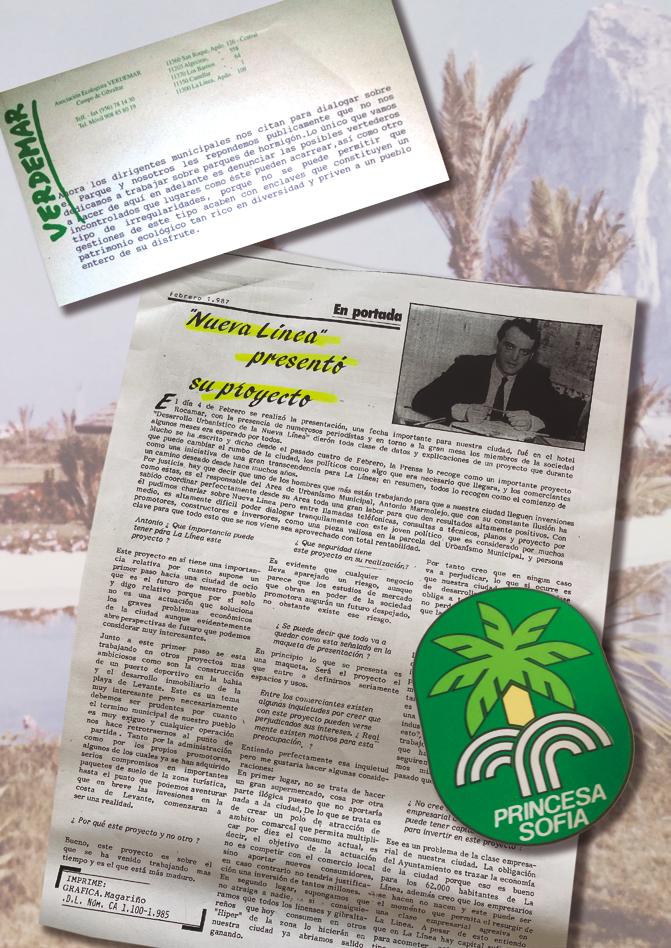
as long as they did not exceed two percent of the land and fifteen meters from its perimeter. When the Ministry of Finance made the free cession of the park, it included a clause in which it demanded a budget item for the maintenance of the park from the city council. There was never any money for this, but there was plenty of money for speculation.
At that time the executive Angel Serrano, who became president of the Real Balompédica Linense, presented a project that intended to turn it into a theme park with ice rinks included.
I remind Mr. Guillermo that much earlier, in February 1987, the “Nueva Línea” project was presented at the Rocamar Hotel, with the presence of numerous journalists organized by the company Desarrollo Urbanístico de la Nueva Línea. Those were the times of Mayor Salvador Pagán Fernández, of the PSOE, and they intended to set up a casino, a discotheque, a water park, stores, restaurants, in short, everything closely related to heritage and the environment.
But going back to the time when Pons governed, on October 2, 1997, in a full council meeting it was agreed, “given the needs of the municipality, given its social situation and lack of an attractive tourist, cultural and recreational offer and that propitiated by private initiative, requests the Directorate General of State Heritage, attached to the Ministry of Economy and Finance the expansion of the uses of the park”. It is worth asking why such a precarious and abandoned situation had been reached, although the answer was already stated by Noam Chomsky: «This is the technique of privatization: cut the budget to ensure that things do not work, people get upset, and it is used as an excuse to pass it into the hands of private capital».
During the period when Juan Carlos Juárez Arriola governed, initially by the GIL and then by the Popular Party, a good collection of anomalous situations occurred, such as the appropriation of a plot of the park to rent it for commercial purposes. The area where the Mac Donald, La Pesquera and subway parking areas are currently located.
Already in July 2004 the Ministry of Finance sent a letter to the city council warning that it could be in breach of the agreement that was agreed with the free transfer. And it warns of the paralysis of all the interventions. Finally, in December of the same year,
que no sobrepasara el dos por ciento del terreno y alejado quince metros desde su perímetro. Cuando el Ministerio de Hacienda hizo la cesión gratuita del parque incluyó una cláusula en la que exigía al ayuntamiento una partida presupuestaria para el mantenimiento del parque. Nunca hubo dinero para ello, pero si muchas ganas para especular.
En aquella época el empresario Ángel Serrano, que llegó a ser presidente de la Real Balompédica Linense, presentó un proyecto que pretendía convertirlo en un parque temático con pistas de hielo incluida.
Le recuerdo a don Guillermo que mucho antes, en febrero de 1987 se presentó en el hotel Rocamar el proyecto «Nueva Línea», con presencia de numerosos periodistas organizado por la empresa Desarrollo Urbanístico de la Nueva Línea. Eran tiempos del alcalde Salvador Pagán Fernández, del PSOE, y pretendían montar un casino, una discoteca, un parque acuático, tiendas, restaurantes, en fin todo muy relacionado con el patrimonio y el medio ambiente.
Pero volviendo a la época donde gobernaba Pons, el 2 de octubre de 1997, en un pleno del ayuntamiento se acordó, «dadas las necesidades del Municipio, ante su situación social y falta de una oferta turística, cultural y lúdica atractiva y que propiciado por la iniciativa privada, solicita a la Dirección General del Patrimonio del Estado, adscrito al Ministerio de Economía y Hacienda la ampliación de los usos del parque». Cabe preguntar por qué motivo se había llegado a esa situación tan precaria y de abandono, aunque la respuesta ya la enunció Noam Chomsky: «Esta es la técnica de la privatización: cortar el presupuesto para asegurarse que las cosas no funcionen, la gente se molesta, y se usa como excusa para pasarlo a manos del capital privado». Durante el periodo donde gobernó Juan Carlos Juárez Arriola, inicialmente por el GIL y luego por el Partido Popular, se sucedieron una buena colección de situaciones anómalas como la apropiación de una parcela del parque para arrendarlo con fines comerciales. La zona dónde actualmente se encuentran el Mac Donald, La Pesquera y zonas de aparcamientos subterráneos. Ya en julio de 2004 el Ministerio de Hacienda envió un escrito al ayuntamiento advirtiéndole de que podría estar incumpliendo el acuerdo que se pactó con la cesión gratuita. Y avisa de la paralización de todas las intervenciones. Por fin, en diciembre del mismo año, el
67 OTWO 26 / SEPTEMBER 2021
the Ministry confirmed in writing that the agreement of use had been breached and demanded the reversion of the property.
And finally El Bulevar?
Built illegally in 2008, it is also denounced by ALDEPAMA and with a firm sentence of illegality.
Instead of following the court’s ruling, Juarez signs another public tender file for the concession of private use for Avda 20 de abril, where El Bulevar is currently located. This document reports the installation of prefabricated and removable commercial modules, including the execution of the complementary work.
What happened to all those complaints, allegations and sentences?
Well, there is a firm sentence and a demolition order for all these illegal installations, but as in this country justice goes at such a slow pace that... Anyway, this is the million-dollar question.
What did happen was a smear campaign, insults and insults to my person, from the mayor’s office to the local media related to the city council. Nevertheless, here I am, about to turn 81 years old.
What is the current situation of the ALDEPAMA association?
We are still active, but we no longer act with the same intensity as in the past, the body does not respond as it used to. Now we have made a series of allegations to the new PGOU, where it is proposed to remove an area of 30,000 square meters to the park, we have already denounced it to National Heritage.
On February 12, 2019, with the current corporation of the party La Línea 100x100 and with José Juan Franco Rodríguez as mayor, governing by majority, is made entry registration at the town hall of a letter from Aldepama stating that the existing buildings on the west side of the Princess Sofia Park as the McDonald Restaurant, Parking La Frontera and La Pesquera and the Boulevard, of which the first three have Final Judgment of Demolition, while the Boulevard and by extension the Burger King has
ministerio confirma con un escrito que se ha incumplido el acuerdo de uso y exige la reversión de los bienes.
¿Y por último llegó El Bulevar?
Construido ilegalmente en 2008, también está denunciado por ALDEPAMA y con sentencia firme de ilegalidad.
En vez de seguir el dictamen de la justicia, Juárez firma otro expediente de concurso público para la concesión de uso privativo para la Avda 20 de abril, donde actualmente se ubica El Bulevar. En este documento se informa de la instalación de módulos comerciales prefabricados y desmontables, incluida la ejecución de la obra complementaria.
¿En qué quedó todas esas denuncias, alegaciones y sentencias?
Pues hay una sentencia firme y una orden de derribo para todas estas instalaciones ilegales, pero como en este país la justicia va a un ritmo tan lento que…En fin, esta es la pregunta del millón.
Lo que si ocurrió fue una campaña de desprestigio, insultos y agravios hacia mi persona, desde la alcaldía hasta los medios de comunicación locales afines al ayuntamiento. Pero aquí sigo, apunto de cumplir 81 años.
¿En qué situación se encuentra actualmente la asociación ALDEPAMA?
Seguimos activos, pero ya no actuamos con la misma intensidad que en otras épocas, ya el cuerpo no responde como antes. Ahora hemos hecho una serie de alegaciones al nuevo PGOU, donde se propone quitar un área de 30.000 metros cuadrados al parque, nosotros ya lo hemos denunciado a Patrimonio Nacional.
El 12 de Febrero de 2019, con la actual corporación del partido La Línea 100x100 y con José Juan Franco Rodríguez como alcalde, gobernando por mayoría, se hace registro de entrada en el ayuntamiento de un escrito de Aldepama manifestando que las construcciones existentes en la parte oeste del Parque Princesa Sofía como el Restaurante McDonald, Parking La Frontera y La Pesquera y el Bulevar, de las cuales las tres primeras tienen Sentencia Firme de Derribo, mientras que el Bulevar y por Extensión

68 OTWO 26 / SEPTEMBER 2021 OTWO 26 / SEPTEMBER 2021 69
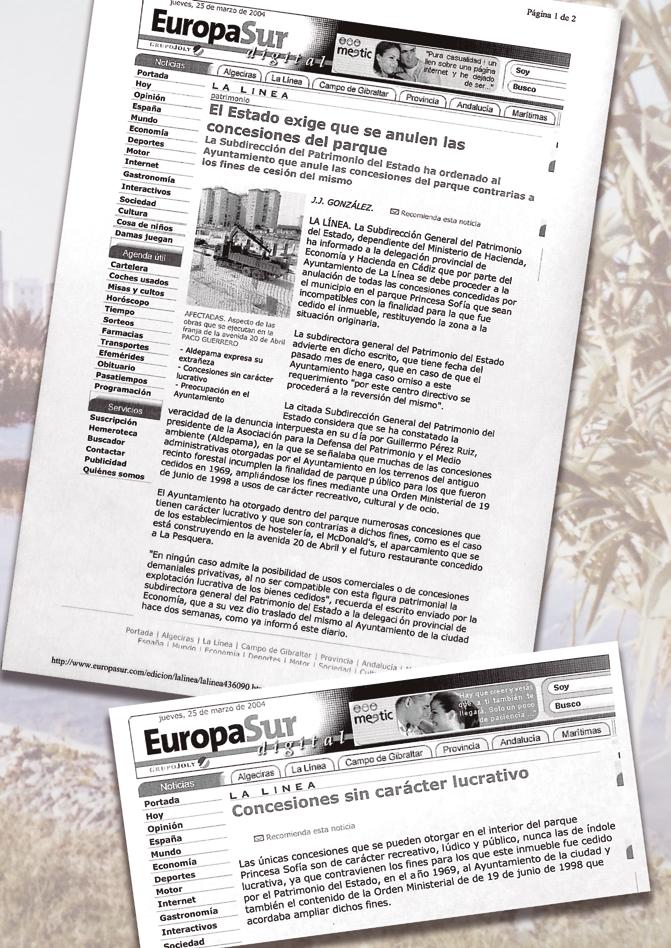
open criminal proceedings for exceeding the meters and permitted uses and therefore requests that the memory is rectified in the surface that appears 174. 027 square meters, for 207,723, in accordance with that reflected in the deed of assignment. If you go through the Bulevar area today, you will see that, instead of demolishing the illegal constructions, the ones that were once stopped by court order are being set up, this time with the justification of temporarily locating the stores of the central market, while it is being reformed.
As reported on June 15, 2008 by the newspaper Europa Sur: «Aldepama has recovered for the municipality, thanks to its work, 40,000 square meters of Burgo, 37,650 of a plot in the Zabal, land in Jardines street and is now studying to request the recovery of 103,000 square meters in the industrial area of Zabal. Before the provincial delegation of Public Works and sometimes before the Public Prosecutor, the association has denounced the work of the Boulevard, “an outrage”, the construction of the Congress Palace because “it occupies more meters and has more volume than allowed by the PGOU and occupies more than 8 linear meters that belong to the Maritime-Terrestrial Demarcation”. Their work has also helped the State to recover part of its heritage such as the Diego Salinas building, for which Aldepama was awarded 10% of the recovered property, or the Camarón square which, although the government team claims that it is municipal property, the association is clear that it belongs to the State».
Moreover, with this third installment we close this report on Los Locos del Parque, an example of solidarity activism and, above all, citizen activism for the defense of heritage in the face of speculative political eagerness. And although this is the end of this trilogy, as luminous as it is sad, I am committed to investigate, write and edit a publication that develops everything that OTWO has told you during these summer months. I cannot have a better way of thanking heroes such as Don Guillermo Pérez or Don Alfonso Llorente. And I end with a question that makes me uneasy every time I walk through the park, now that it is more beautiful than ever: What would have happened to this heritage without associations like ALDEPAMA, Los Locos del Parque or Verdemar?
el Burger King tiene diligencias penales abiertas por exceder los metros y usos permitidos y por lo que solicita que se rectifique en la memoria la superficie que aparece de 174.027 metros cuadrados, por la de 207.723, acorde con la reflejada en la escritura de cesión. Si hoy pasan por la zona del Bulevar comprobarán que en vez de demoler las construcciones ilegales, se están habilitando las que en su día se detuvieron por orden judicial, esta vez con la justificación de ubicar provisionalmente las tiendas del mercado central, mientras lo reforman.
Según informó el quince de junio de 2008 el diario Europa Sur: «Aldepama ha recuperado para el municipio, gracias a su labor, 40.000 metros cuadrados del Burgo, 37.650 de una parcela en el Zabal, suelo en la calle Jardines y ahora mismo está estudiando pedir la recuperación de 103.000 metros cuadrados en el polígono industrial del Zabal. Ante la delegación provincial de Obras Públicas y en ocasiones ante Fiscalía, la asociación tiene denunciada la obra del Bulevar, “una tropelía”, la construcción de Palacio de Congresos porque “ocupa más metros y tiene más volumen de lo permitido por el PGOU y ocupa más de 8 metros lineales que pertenecen a la Demarcación Marítimo-Terrestre”. Su trabajo también ha servido para que el Estado recupere parte de su patrimonio como el edificio del Diego Salinas, por lo que Aldepama fue premiada con el 10% del bien recuperado, o la plaza del Camarón que, a pesar de que el equipo de gobierno afirma que es de propiedad municipal, la asociación tiene claro que pertenece al Estado». Y con esta tercera entrega cerramos este reportaje sobre Los Locos del Parque, todo un ejemplo de activismo solidario y sobre todo ciudadano para la defensa del patrimonio ante los afanes especulativos de la política. Y aunque aquí acabe esta trilogía tan luminosa como triste, me comprometo a investigar, escribir y editar una publicación que desarrolle todo lo que en OTWO le hemos contado durante estos meses de verano. No puedo tener mejor forma de agradecimiento a héroes como don Guillermo Pérez o don Alfonso Llorente. Y termino con una pregunta que me desasosiega cada vez que paseo por el parque, ahora que está más hermoso que nunca: ¿Qué le hubiera ocurrido a este patrimonio sin asociaciones como ALDEPAMA, Los Locos del Parque o Verdemar?
OTWO 26 / SEPTEMBER 2021 71 70

“From that moment on, this public space became a stage for speculation, abandonment and proposals for projects as messianic as they were hallucinatory”.
«Desde ese momento este espacio público se convertirá en un escenario de especulaciones, abandonos y propuestas de proyectos tan mesiánicos como alucinados».

CAVE OF ARDALES,
TWO CENTURIES SINCE ITS DISCOVERY.
A contribution to the making of spanish prehistory. Cueva de ardales, dos siglos desde su descubrimiento. Un aporte para la confección de la prehistoria española.
Autor: Hugo A. Mra Perales.
Photographs: Pedro Cantalejo Duarte y Handpas Project
OTWO 26 / SEPTEMBER 2021 75 74 OTWO 26 / SEPTEMBER 2021


Two centuries have just passed since the discovery of this unique cave (Guía de la Cueva de Ardales, y centro de la prehistoria. Pedro Cantalejo, María del Mar Espejo, José Ramos and Gerd C. Weniger), which has contributed so many findings in the clarification of part of our distant past. Its discovery is due to an earthquake in the area, which caused the stone blocks that obstructed the access to collapse, leaving part of the entrance free. At first, the researchers thought that it was a mine of precious stones, changing their opinion when they saw that it was the reflections produced by the crystalline minerals in the walls. The cave was so well accepted by the locals and the proximity of the spas of Ardales and Carratraca, that a fee was charged for access to the cave, reaching the point of paying two reales (1821). In the process of research in those years, some researchers such as Sebastián de Miñano, Fco. María Tubino and Pascual Madoz, recognize findings of crystallized human remains, but only one of them (Tubino), relates them to the Stone Age. Even this researcher took the findings of crystallized bone remains to the Paris Universal Exposition of 1878, defending their ascription to the Stone Age period. Just a year later, in 1879, Marcelino Sanz de Santuola made the discovery of the Altamira Cave, which did not have the expected effect and was almost forgotten. It was not until 1902 that it meant a change for the Prehistory of Spain, when in an article published in “L’Anthropologie”, Cartailhac recognized his mistake singing the “MEA CULPA DE UN ESCEPTICO”, thus admitting and testifying the antiquity, the value and the importance of the prehistoric paintings of Altamira.
For a long time the cave of Ardales was a tourist attraction for the bourgeoisie that passed through the nearby spas. It was around 1859 when Doña Trinidad Grund, a prominent person in the city of Malaga, due to the charitable works that she carried out during her life, undertook the improvements for the access to the cave, such as the construction of the stairways, which are still used today to make part of the interior circuit. In addition to providing the tour with a lighting system, by means of oil lamps that gave light to the great vaults, stalactites and immense columns, he included guides in the excursions, to make the tour more enjoyable. Already in the first
Se acaban de cumplir dos siglos desde el descubrimiento de esta singular cavidad (Guía de la Cueva de Ardales, y centro de la prehistoria. Pedro Cantalejo, María del Mar Espejo, José Ramos y Gerd C. Weniger), que tantos hallazgos ha aportado en el esclarecimiento de parte de nuestro pasado muy lejano. Su descubrimiento se debe a un terremoto que hubo por la zona, siendo el causante de que los bloques de piedra que obstruían el acceso colapsasen, dejando libre parte de la entrada. Al principio, los investigadores pensaron que se trataba de una mina de piedras preciosas, cambiando su opinión al ver que se trataba de los reflejos que producían los minerales cristalinos de las paredes. Incluso tuvo tal aceptación la cueva por los lugareños y la proximidad de los balnearios de Ardales y Carratraca, que se cobró por el acceso a la misma, llegándose a pagar dos reales (1821). En el proceso de investigación en aquellos años, algunos investigadores como Sebastián de Miñano, Fco. María Tubino y Pascual Madoz, reconocen hallazgos de restos humanos cristalizados, pero solo uno de ellos (Tubino), los relaciona con la Edad de Piedra. Incluso este investigador llevo los hallazgos de restos óseos cristalizados a la Exposición Universal de París de 1878, defendiendo su adscripción al periodo de la Edad de Piedra. Justo un año después, en 1879, se realiza, por arte de Marcelino Sanz de Santuola el descubrimiento de la Cueva de Altamira, que no causo el efecto esperado y casi pasó al olvido. No fue hasta 1902 el que supusiera un cambio para la Prehistoria de España, cuando en un artículo publicado en «L’Anthropologie», Cartailhac reconoce su equivocación entonando el «MEA CULPA DE UN ESCEPTICO», admitiendo y testificando así la antigüedad, el valor y la importancia de las pinturas prehistóricas de Altamira.
Durante bastante tiempo la cueva de Ardales fue un reclamo turístico para la burguesía que pasaba por los balnearios de las proximidades. Siendo sobre 1859 cuando Doña Trinidad Grund, persona destacada en la ciudad de Málaga, debido a las obras de caridad que realizo durante su vida, acometió las mejoras para el acceso a la cavidad, como la construcción de las escalinatas, que aun actualmente son las que se utilizan para realizar parte del circuito interior. Además de proveer al recorrido de un sistema de iluminación, mediante lámparas de aceite
77 OTWO 26 / SEPTEMBER 2021
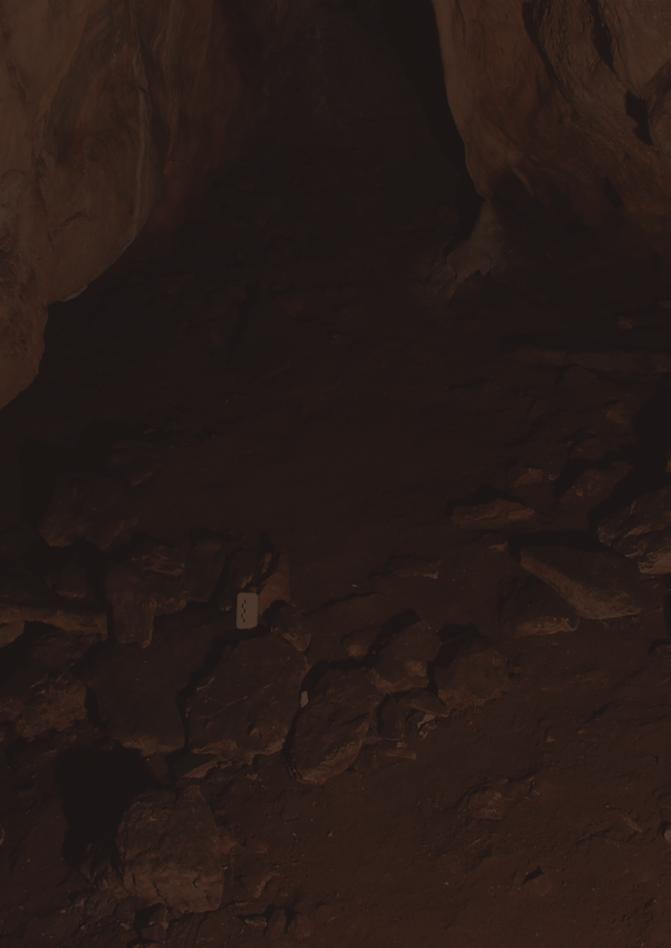
decades of the 20th century, Henri Breuil discovered Paleolithic art in the cave of Ardales, recognizing the importance of the cave and publishing his research of the site in the magazine L’Anthropologie XXXI in 1921, placing several scenes in the Paleolithic, more specifically in the Aurignacian and highlighting the importance of them by considering the same authorship for both. From these findings, its relevance in the scientific world positioned the Ardales cave within the European inventory of caves with Paleolithic art, being Hugo Obermaier in 1925, who reflected in his masterpiece “The Fossil Man”, the pictorial art of this splendid enclave.
In the following years, due to the Spanish Civil War, the management implemented by Doña Trinidad Grund in the cave was completely abandoned. Even later, in the post-war period, the cave fell into oblivion, lacking an exhaustive study of all its paintings and engravings. During the following years, some researchers, such as Simeón Giménez and Manuel Laza, made several visits and studies of the cave. Years later, Abbé Breuil once again gave the cave of Ardales the importance it deserved in his publication “Quatre cents siècles d’Art Parietal”, in which he listed the most important Paleolithic sites on the European continent. In the sixties, studies of the sites with art on the Cantabrian coast intensified, with Francisco Jordá carrying out several works in the Malaga caves, including engravings and cave paintings of the cave in question. In the eighties the Galerías Altas were discovered by the researchers J.A. Molina and A. Vela, who carried out the topography of these galleries, documentation that is still in use today. In 1985, the Ardales Town Council promoted the study and investigation of the Ardales Cave, and a team was organized, headed by María del Mar Espejo, and composed of Pedro Cantalejo, Federico Ramírez and Manuel Cisneros, as well as the scientific researchers José Ramos and Juan José Durán. In the following years, this team grew, producing numerous articles and monographs, which updated the advances in research and discoveries. At present, the great team that forms this project is coordinated by José Ramos Muñoz (Professor of Prehistory at the University of Cadiz), and Gerd-Christian Weniger (director of the Neanderthal Museum in Mattmann, Germany).
que daban luz a las grandes bóvedas, estalactitas e inmensas columnas, incluyo guías en las excursiones, para hacer más ameno el recorrido. Ya en las primeras décadas del siglo XX, Henri Breuil descubrió arte paleolítico en la cueva de Ardales, reconociendo la importancia de la cavidad y publicando sus investigaciones del yacimiento en la revista L’Anthropologie XXXI en 1921, situando ya varias escenas en el paleolítico, más concretamente en el Auriñaciense y destacando la importancia de las mismas por considerar la misma autoría para ambas. A partir de estos hallazgos, su relevancia en el mundo científico posiciono a la cueva de Ardales dentro del inventario europeo de cuevas con arte paleolítico, siendo Hugo Obermaier en 1925, quien reflejo en su obra maestra «El hombre Fósil», el arte pictórico de este esplendido enclave. En los años siguientes y debidos a la Guerra Civil Española, se abandonó por completo la gestión implantada por Doña Trinidad Grund en la cavidad. Incluso después, en la postguerra, la cueva cayo en el olvido, careciendo de un estudio exhaustivo todas sus pinturas y grabados. Durante los siguientes años, algunos investigadores como Simeón Giménez y Manuel Laza, realizan varias visitas y estudios sobre la cavidad. Años más tarde el abate Breuil volvió a dar la importancia que merecía a la cueva de Ardales en su publicación «Quatre cents siècles d’Art Parietal», donde recogía los enclaves paleolíticos más relevantes del continente Europeo. Ya en los años sesenta se intensifican los estudios de los yacimientos con arte de la cornisa cantábrica, siendo Francisco Jordá quien realiza varios trabajos en las cuevas malagueñas, incluyendo grabados y pinturas rupestres de la cueva que nos ocupa. En la década de los ochenta se descubren las Galerías Altas, por los investigadores J.A. Molina y A. Vela, que realizan la topografía de esas galerías, documentación que aun en la actualidad se utiliza. En 1985 el Ayuntamiento de Ardales promueve el estudio e investigación de la Cueva de Ardales, y se organiza un equipo, encabezado por María del Mar Espejo, y compuesto por Pedro Cantalejo, Federico Ramírez y Manuel Cisneros, además de los investigadores científicos José Ramos y Juan José Durán. En los años siguientes, este equipo fue creciendo, realizando numerosos artículos y monografías, que van actualizando los avances en las investigaciones y descubrimientos. En la actua-

78 OTWO 26 / SEPTEMBER 2021
Photographs: Pedro Cantalejo Duarte.
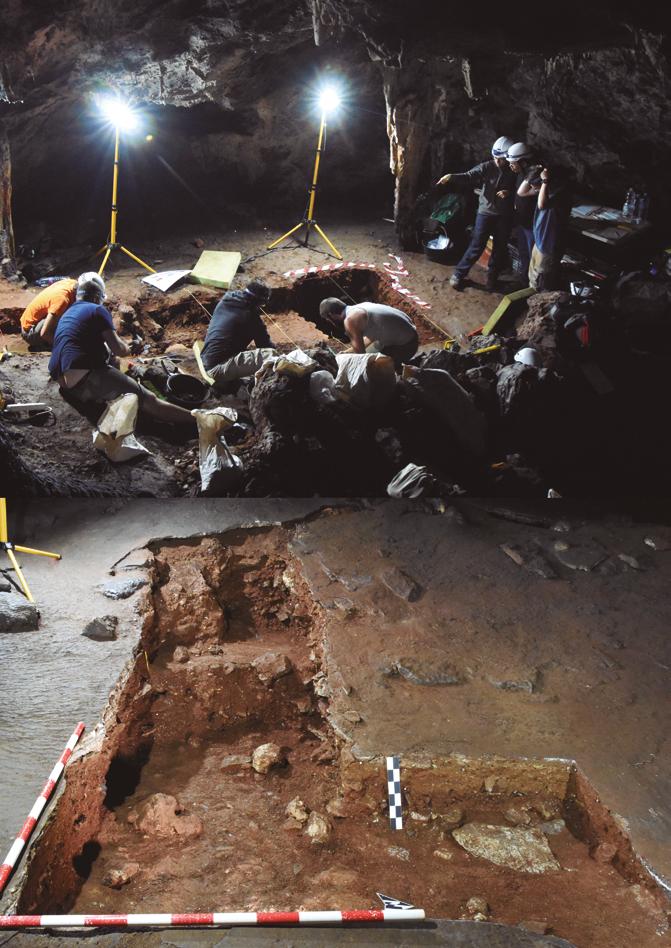

Next, we will approach the geology, morphology and structure of the Ardales Cave, located in the Cerro de la Calinoria, belonging to the Betic Mountain Range. The composition of these lands starts from the Triassic, and is formed by marble and limestone minerals. All this set belongs to the Bonella-Capellán Unit, where rocks of the dolomitic limestone type of gray color predominate. This type of minerals, over time is subjected to the processes of karstic dissolution in the limestone sedimentary rocks, caused by the filtrations produced by rainwater in the cavity currently known as the Cueva de Ardales. This formation process took place during the last five million years, causing a network of galleries and rooms, with a total development of 1,597 meters.
The current access to the cave is through stairways built in the nineteenth century, leading to several rooms and galleries, which even today, retain the names given to them in the years after its discovery. The Hall of the Stars and the Hall of the Virgin, the galleries of the Calvary and the Labyrinths, as well as the halls of the Lake, of the Dressing Room, etc., stand out. In all these rooms and galleries, a series of speleothems, such as stalactites, stalagmites and large column-like formations, have been formed during the five million years of their creation.
The relevance that this cave has had during the whole period of prehistory that most directly touches us has been mainly related to its sporadic use, both inside and in the areas near the cave. It was used in a period of approximately 50,000 years, both by Neanderthal groups and by Homo sapiens. This results in such a contribution of testimonies, both of movable material culture and of parietal art that turns this fortunate enclave into an open book of our past.
The large amount of cave representations, both engraved and painted, position this cave as one of the most important for its artistic content, within the enclaves with Paleolithic representations both in the Iberian Peninsula and throughout the southern part of France. It is necessary to emphasize the great quantity of Paleolithic cave art, with the oldest representations located in the room of the Stars, which presents traces and digitations (points), made with red pigment, and with dates of more than 45,000 years old. Another relevant motif in this
lidad el gran equipo que forma este proyecto está coordinado por José Ramos Muñoz (Catedrático de Prehistoria de la Universidad de Cádiz), y Gerd-Christian Weniger (director del Neanderthal Museum de Mattmann, Alemania). A continuación nos aproximaremos a la geología, morfología y estructura de la Cueva de Ardales, ubicada en el Cerro de la Calinoria, perteneciente a la Cordillera Bética. La composición de estas tierras arranca del Triásico, y la forman minerales del tipo mármoles y calizas. Todo este conjunto pertenece a la Unidad Bonella-Capellán, donde predominan las rocas del tipo calizas dolomíticas de color gris. Este tipo de minerales, a lo largo del tiempo está sometido a los procesos de disolución kárstica en las rocas sedimentarias calizas, provocados por las filtraciones que se producen por el agua de lluvia la cavidad que actualmente conocemos como la Cueva de Ardales. Este proceso de formación se realizó durante los últimos cinco millones de años, provocando una red de galerías y salas, con desarrollo total de 1.597 metros. El acceso actual a la cavidad es a través de unas escalinatas construidas en el siglo XIX, dando paso a varias salas y galerías, que aún hoy en día, conservan los nombres que se les dieron en los años posteriores a su descubrimiento. Destacan la Sala de las Estrellas y la Sala de la Virgen, las galerías del Calvario y de Los Laberintos, así como las salas del Lago, del Camarín, etc. En todas estas salas y galerías, se han formado durante los cinco millones de años que duro su proceso de creación, una serie de espeleotemas, tal como estalactitas, estalagmitas y grandes formaciones del tipo columnas. La relevancia que ha tenido esta cueva durante todo el periodo de la prehistoria que más directamente nos toca, ha sido sobre todo estar relacionada con su uso esporádico, tanto de su interior como en las zonas próximas a la misma. Fue utilizada en un espacio de tiempo aproximado de 50.000 años, tanto por grupos neandertales como por el Homo sapiens. Lo que provoca un aporte tal de testimonios, tanto de cultura material mueble como de arte parietal que convierte este afortunado enclave en un libro abierto de nuestro pasado.
La gran cantidad de representaciones rupestres tanto grabadas como pintadas, posicionan esta cavidad como una de las más importantes por su
81 OTWO 26 / SEPTEMBER 2021
ca-
Photographs: Pedro Cantalejo Duarte.

vity are the airbrushed negative handprints, painted with black pigment.
Nowadays, these representations of hands in negative, in the whole area of the extreme south of the peninsula, represent a change in the established patterns, since in a period of ten years ago, only the two hands in negative from the Ardales cave and the hand also in black pigment from the Gorham cave in Gibraltar were known. The first finding of hands in negative in outdoor shelters was located in the Tajo de las Abejeras (Castellar de la Frontera), specifically in the cave of Abejeras II, where 8 airbrushed hands were recorded in studies conducted by the University of Cadiz and the Handpas project, several years later were located in the set of caves of Palomas (Tarifa), four imprints of hands in negative.
In the tour among the rooms and labyrinths, it is worth mentioning the large horse engraved with the representation of its legs in a reduced size, as well as its head, and the representation of a female torso with legs, but without head or arms. Continuing with the tour in an area dominated by stalagmites, our ancestors represented several groups of deer, and the figure of a wild male that was represented using a yellowish ochre pigment. Below these motifs, there are several engravings of hinds, represented only on the front side. In the right zone of these figures, the head of a doe is located, where the author represented it with three lines. Just above, less than a meter away, there is another magnificent engraving where a running deer is represented, giving the sensation that it is climbing a slope, possibly representing the animal fleeing from a predator or being hunted. All these findings in the south of the Iberian Peninsula have meant a change of thought, in everything related to these motifs. Independently of these figures, the Ardales cave has several motifs related to fauna, and a female figure, represented in the Galería del Calvario (Calvary Gallery). There are many more motifs in the cave, but due to their location and complexity of access, it is not possible to show them to the public.
The Ardales cave marks a reference in Paleolithic art at international levels, with the possibility of being visited, opens us to see the world where our ancestors made these magnificent cave representations, even today difficult to interpret and wi-
contenido artístico, dentro de los enclaves con representaciones paleolíticas tanto en la península ibérica como toda la zona sur de Francia. Hay que destacar la gran cantidad de arte rupestre paleolítico, con las más antiguas representaciones localizadas en la sala de las Estrellas, que presenta trazos y digitaciones (puntos), realizadas con pigmento de color rojo, y con dataciones de más de 45.000 años de antigüedad. Otro de los motivos relevantes en esta cavidad son las huellas en negativo de manos aerografiadas, plasmadas con pigmento de color negro.
En la actualidad, estas representaciones de manos en negativo, en toda la zona del extremo sur peninsular, suponen un cambio en los patrones establecidos, pues en un periodo de diez años atrás, solo se conocían las dos manos en negativo de la cueva de Ardales y la mano también en pigmento negro de la cueva de Gorham en Gibraltar. El primer hallazgo de manos en negativo en abrigos al aire libre se localizó en el Tajo de las Abejeras (Castellar de la Frontera), concretamente en la cueva de Abejeras II, donde se registraron 8 manos aerografiadas en los estudios realizados por la Universidad de Cádiz y el proyecto Handpas, varios años más tarde se localizan en el conjunto de cuevas de Palomas (Tarifa), cuatro improntas de manos en negativo.
En el recorrido entre las salas y laberintos, destacar el gran caballo grabado con la representación de sus patas a tamaño reducido, al igual que su cabeza, así como la representación de un torso femenino con piernas, pero sin cabeza ni brazos. Continuando con el recorrido en una zona donde predominan las estalagmitas, nuestros antepasados representaron varios grupos de cérvidos, y la figura de un macho montés que se representó utilizando un pigmento amarillento ocre. Debajo de estos motivos se localizan varios grabados de ciervas, representadas solamente por la parte delantera. En la zona derecha de estas figuras, se localiza la cabeza de una cierva, donde el autor la represento con tres líneas. Justo encima a menos de un metro aparece otro magnifico grabado donde se representó un cérvido a la carrera, dando la sensación que sube una pendiente, posiblemente se quiso representar al animal en la huida de un depredador o ser cazado. Todos estos hallazgos en la zona sur de la península ibérica, han supuesto un cambio de pensamiento, en todo lo relacionado con estos motivos. In-

82 OTWO 26 / SEPTEMBER 2021
Photographs: Pedro Cantalejo Duarte.


thout knowing with certainty the reason for being, the reason for its realization. We hope that with the passage of time and technological advances we will be able to understand the legacy that our ancestors left on the walls of the caves.
The visit to Ardales is fully justified: the town is quite accessible from the tourist areas of the coast, especially by the A-357 road, and has interesting elements such as the Convent of Capuchinos, the church Ntra. Señora de los Remedios, the castle of La Peña, the Roman bridge and the impressive gorge of Los Gaitanes, with the world famous Caminito del Rey.
However, the element most closely related to the cave is an excellent institution, the Ardales Prehistoric Center, where in addition to displaying the best information about the cave and its prehistoric context, it treasures a remarkable archaeological collection formed on the basis of the surrounding sites. We will only say that in 2010 the Council of Europe included both the cave and the prehistoric center in the European Cultural Itinerary.
To visit Ardales and its wonders, it is best to obtain information at 952 45 80 46, or at patrimonio@ ardales.es.
But the importance of the Ardales cave is twofold: not only is it an exceptional prehistoric site, with a rich artistic heritage, but it is also a model case of how heritage can be researched, protected and disseminated, with excellent results in terms of its socio-cultural use and successful tourist exploitation. What has been done in Ardales in recent years should be imitated in many towns that treasure a cultural heritage that can create many jobs.
dependientemente a estas figuraciones, la cueva de Ardales cuenta con varios motivos relacionados con la fauna, y una figura femenina, representados en la Galería del Calvario. En la cueva existen muchos más motivos pero por su situación y complejidad en el acceso, no es posible mostrarlos al público.
La cueva de Ardales marca un referente en el arte paleolítico a niveles internacionales, con la posibilidad de ser visitada, nos abre poder ver el mundo donde nuestros antepasados realizaban estas magnificas representaciones rupestres, aun hoy en día difíciles de interpretar y sin saber con certeza la razón de ser, el porqué de su realización. Esperemos que con el paso del tiempo y los avances tecnológicos lleguemos a poder entender el legado que nuestros antepasados dejaron en las paredes de las cuevas.
La visita a Ardales está plenamente justificada: la población es bastante accesible desde las zonas turísticas de la costa, en especial por la carretera A-357, y tiene elementos tan interesantes como el Convento de Capuchinos, la iglesia Ntra. Señora de los Remedios, el castillo de la Peña, el puente Romano y el impresionante desfiladero de Los Gaitanes, con el mundialmente famoso Caminito del Rey.
Pero el elemento más relacionado con la cueva es una excelente institución, el Centro de Prehistoria de Ardales, donde además de exponer la mejor información sobre la cueva y su contexto prehistórico, se atesora una notable colección arqueológica formada en base a los yacimientos del entorno. Solo diremos que en 2010 el Consejo de Europa incluyó tanto la cueva como el centro de prehistoria, en el Itinerario Cultural Europeo.
Para visitar Ardales y sus maravillas, lo más recomendable es recabar información en el nº 952 45 80 46, o en patrimonio@ardales.es
Pero la importancia de la cueva de Ardales es doble: no solo es un excepcional enclave prehistórico, con un rico patrimonio artístico, sino que constituye un caso modélico de cómo se puede investigar, proteger y divulgar el patrimonio, con excelentes resultados en cuanto al aprovechamiento socio-cultural del mismo y con una exitosa explotación turística. Lo realizado en Ardales en los últimos años debería ser imitado en multitud de poblaciones que atesoran un patrimonio cultural susceptible de crear multitud de puestos de trabajo.

OTWO 26 / SEPTEMBER 2021 85
Photography: Pedro Cantalejo Duarte.

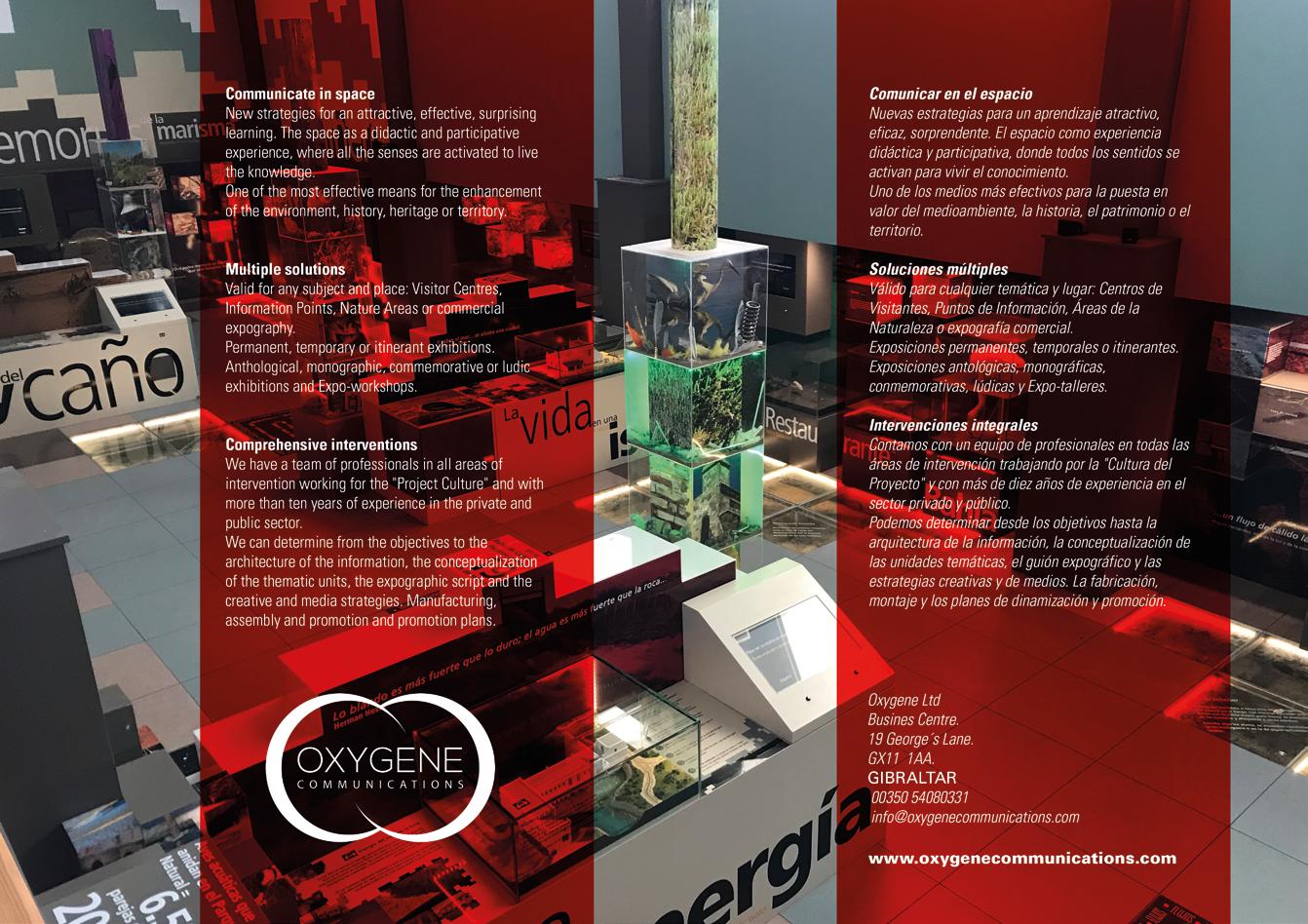
VOLUME 2 / VOLUMEN 2
Volubilis, a piece of Rome in the Mauri’s country
Volubilis, un trozo de Roma en el país de los Mauri
Juanlu González
Article and images


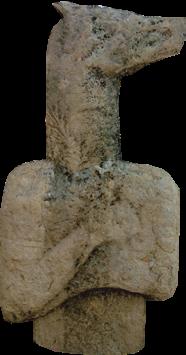
The first time I visited Volubilis, I found ri ght on the walkway at the entrance to the site, with what appeared to be a stele of Anubis, the Egyptian god of the dead, very recognizable by its characteristic head of a dog or jackal. I remember my surprise, which I immediately related to other Egyptian cults that spread throughout the Mediterranean, such as that of the goddess Isis, one of whose temples is located in Baelo Claudia, next to the classic Capitoline triad (Jupiter, Juno and Minerva) present in all self-respecting Roman cities. But it did not fit me, I never heard cults to Anubis outside Egypt. It had to be something else.
Volubilis, whose name seems to come from walili, oleander in Berber, is undoubtedly the main Roman city of Morocco and one of the best preserved of all North Africa. It was declared a World Heritage

La primera vez que visité Volubilis, me encontré justo en el paseo de la entrada al yacimiento, con lo que parecía ser una estela de Anubis, el dios egipcio de los muertos, muy reconocible por su característica cabeza de perro o de chacal. Recuerdo mi sorpresa, que enseguida relacioné con otros cultos egipcios que se extendieron por el Mediterráneo, como el de la diosa Isis, uno de cuyos templos se encuentra en Baelo Claudia, junto a la clásica triada capitolina (Júpiter, Juno y Minerva) presente en todas las ciudades romanas que se precien. Pero no me cuadraba, jamás oí cultos a Anubis fuera de Egipto. Tenía que ser algo más.
Volubilis, cuyo nombre parece proceder de walili, adelfa en bereber es, sin duda, la principal ciudad romana de Marruecos y una de las más mejor conservadas de todo el norte de África. Fue declarada Patrimonio de la Humanidad por la UNESCO en 1997. Podría afirmarse, en puridad, que no está geográficamente situada en el Estrecho de
89 88
OTWO 26 / SEPTEMBER 2021 OTWO 26 / SEPTEMBER 2021
Site by UNESCO in 1997. It could be said, strictly speaking, that it is not geographically located in the Strait of Gibraltar, since its distance from the Pillars of Hercules is about 200 km. However, it is enough to take a look at the theme of its many well-preserved mosaics in the inhabited area of the city to realize that the whole imaginary of the city revolved around the founding myths of the Strait and its legendary characters. It is also no coincidence that the main roads that reach it, connected them with Lixus (Larache) and Tingis (Tangier), clearly located in our study area.
Although it is considered exclusively Roman, its foundation was Carthaginian, from the third century BC. However, after the defeat of Carthage, it did not automatically become part of the Roman Empire. For almost 200 years, it retained a certain independence from Rome as a client state. It became the capital of the Kingdom of Mauretania, the country of the “mauri”, a state that united the Berber tribes (Amazighs) of Algeria and Morocco. In 44 A.D., it was definitively incorporated into the Pax Romana as the province of Mauretania Tingitana.
It had about 20,000 inhabitants, who lived from the production of wheat and oil, as evidenced by the frequent olive mills for grinding olives that can still be seen among the ruins. It was also an area from which wild animals were imported for the Roman circuses, such as lions, tigers, panthers, monkeys or elephants, perfectly immortalized in some of its magnificent mosaics. In spite of the deterioration suffered by the abandonment, it is still possible to be delighted with many public buildings that remain standing, such as the basilica, the capital temples or a triumphal arch, as well as houses of patricians that can make us think of the luxury in which the richest of the city lived, where enormous mosaics are preserved as delicate carpets with the most varied motifs.
The evolution of this city is linked to what may be one of the most famous love affairs in history: that of Mark Antony and Cleopatra, immortalized, among others by William Shakespeare. Plays, operas, paintings, novels, films, comics... created by the best artists in the world over many hundreds of years prove it. Once again, the Strait shows its voracious appetite for being part of many key moments in the evolution of humanity.
Gibraltar, ya que su distancia a las columnas de Hércules es de alrededor de 200 km. Sin embargo, basta echar una ojeada a la temática de sus muchos y bien conservados mosaicos de la zona habitada de la urbe, para darse cuenta de que todo el imaginario de la ciudad giraba alrededor de los mitos fundacionales del Estrecho y sus legendarios personajes.
Tampoco es casual que las calzadas principales que llegan hasta ella, las conectaran con Lixus (Larache) y con Tingis (Tánger), situadas claramente en nuestra área de estudio.
Aunque se la considere como exclusivamente romana, su fundación fue cartaginesa, del siglo III antes de Cristo. Sin embargo, tras la derrota de Cartago, no pasó automáticamente a integrarse en el Imperio Romano. Durante casi 200 años, conservó cierta independencia de Roma con la figura de estado clientelar. Se convirtió en la capital del Reino de Mauretania, el país de los «mauri», un estado que unió a las tribus bereberes (amazighs) de Argelia y Marruecos. En el año 44 d.C., se incorporó definitivamente a la Pax Romana como provincia Mauretania Tingitana.
Llegó a tener unos 20.000 habitantes, que vivían de la producción de trigo y aceite, como demuestran las frecuentes almazaras para moler aceituna que aún pueden verse entre las ruinas. También era una zona desde la que se importaban animales salvajes para los circos romanos, como leones, panteras, monos o elefantes, perfectamente inmortalizados en alguno de sus magníficos mosaicos. A pesar del deterioro sufrido por el abandono, aún es posible deleitarse con muchos edificios públicos que permanecen en pie, como la basílica, los templos capitalinos o un arco del triunfo, además de casas de patricios que nos pueden hacer pensar en el lujo en el que vivían los mas ricos de la ciudad, donde se conservan enormes mosaicos a modo de delicadas alfombras con los más variados motivos.
El devenir de esta ciudad entronca con la que puede ser una de las relaciones amorosas más conocidas de toda la historia: la de Marco Antonio y Cleopatra, inmortalizada, entre otros por William Shakespeare. Obras de teatro, óperas, cuadros, novelas, películas, cómics… creados por los mejores artistas del mundo durante muchos centenares de años así lo demuestran. Nuevamente el Estrecho demuestra su voraz


OTWO 26 / SEPTEMBER 2021 91 90 OTWO 26 / SEPTEMBER 2021



What does the last pharaoh of Egypt have to do with Volubilis? Let us remember that Cleopatra committed suicide with the bite of a snake to avoid being taken to Rome as booty and to be exhibited during the triumphal procession that was organized through the streets of Rome after each military victory. Mark Antony had committed suicide shortly before, when he was led to believe that his beloved was dead. In the absence of first-class trophies, the emperor Octavian chose to take their daughter Cleopatra Selene to Rome, who was adopted by her own sister and educated according to the values of the nascent Roman Empire.
A similar case happened shortly before with Juba II. Coincidentally, her father, Juba I, king of Numidia (a Berber kingdom closely linked to Mauretania in present-day Morocco, Tunisia and Algeria), also committed suicide when he was defeated by Caesar and his kingdom incorporated into the Empire as a Roman province. As it could not be otherwise, the king’s son was taken to Rome to participate in the triumphal procession and was educated by the nobility. All very original.
Octavian Augustus reinstated Juba II as king of Numidia and Mauretania in 25 B.C. in exchange for his loyalty to Rome and even found him a queen to match, our Cleopatra Selene. They established the capital at Volubilis, built with a fusion of Roman, Greek, Egyptian and even Berber styles. Roman for obvious reasons, both were educated in the imperial city and served Rome; in fact, they were so Romanized that they were not much to the liking of their subjects. Greek and Egyptian because they were the nationality of the queen, let us not forget that her mother, the immortal pharaoh, was the last of the Ptolemaic dynasty, a saga of Hellenic origin that ruled Egypt since the death of Alexander the Great. And Berber because it was the culture of the subjects, in fact the guides of the site always insist that many of the geometric patterns of the mosaics of Volubilis are similar to those of the carpets that are still braided today in their ancestral looms.
Both kings were cultured people, protectors of the arts and sciences. In fact, Juba II is known to have written treatises on archaeology and natural history -much quoted by renowned classical au -
apetito por formar parte de muchos momentos clave en el devenir de la humanidad.
¿Qué tiene que ver la última faraona de Egipto con Volubilis? Recordemos que Cleopatra se suicidó con la mordedura de una serpiente para evitar ser llevada a Roma como botín y ser exhibida durante el paseo triunfal que se organizaba por las calles de Roma tras cada victoria militar. Marco Antonio se había suicidado poco antes, cuando le hicieron creer que su amada estaba muerta. A falta de trofeos de primera, el emperador Octavio optó por llevarse a Roma a la hija de estos, Cleopatra Selene, quien fue adoptada por su propia hermana y educada según los valores del naciente imperio romano.
Un caso similar sucedió poco antes con Juba II. Casualmente, su padre, Juba I, rey de Numidia (un reino bereber muy vinculado a Mauretania en la actual Marruecos, Túnez y Argelia), también se suicidó cuando fue vencido por César y su reino incorporado al Imperio como provincia romana. Como no podía ser de otra manera, el hijo del rey fue llevado a Roma para participar en el paseíllo triunfal y fue educado por la nobleza. Todo muy original.
Octavio Augusto restituyó a Juba II como rey de Numidia y Mauretania en el año 25 a.C. a cambio de ser fiel a Roma y hasta le buscó una reina a la altura, nuestra Cleopatra Selene. Establecieron la capital en Volubilis, construida con una fusión de estilos romano, griego, egipcio e incluso bereber. Romano por razones obvias, ambos fueron educados en la urbe imperial y prestaban servicio a Roma; de hecho estaban tan romanizados que no eran muy del agrado de sus súbditos. Griego y egipcio porque eran la nacionalidad de la reina, no olvidemos que su madre, la faraona inmortal, fue la última de la dinastía ptolemaica, una saga de origen heleno que gobernó Egipto desde la muerte de Alejandro Magno. Y bereber porque era la cultura de los súbditos, de hecho los guías del yacimiento siempre insisten que muchos de los patrones geométricos de los mosaicos de Volubilis son similares a los de las alfombras que siguen trenzando hoy día en sus telares ancestrales. Ambos reyes eran personas cultas, protectoras de las artes y las ciencias. De hecho, a Juba II se le conocen tratados de arqueología e historia natural —muy citados por autores clásicos reconocidos como Plinio— pero también sobre gramática, teatro
OTWO 26 / SEPTEMBER 2021 93 92 OTWO 26 / SEPTEMBER 2021

thors such as Pliny- but also on grammar, theater or painting. He sent naturalist expeditions to the Canary Islands and Madeira. He is credited with the first historical reference to the islands and even their name, which alludes to the wild dogs (canis) that inhabited the islands and surprised the curious visitors. Subsequently, it was the canary, the songbird so familiar for its song, which acquired the name of the islands and not the other way around as is popularly believed.
But let’s leave aside the history of the kings, who rarely tell us the true stories of the people and let’s look a little to the ground. In Volubilis wanders a strange and humble inhabitant, like an unnoticed European tourist, who has never returned home despite the ruin of the city, the earthquakes it suffered or climate change. It is the small snail, Cernuella virgata, a mollusk native to southern Europe, linked to the northern shore of the Mediterranean Sea that lives in rather warm areas, not far from the coast. However, an isolated colony of these snails inhabits naturalized in the ruins of the city. How did they get there? It is very difficult to know for sure, but the small snail is a gregarious species, which is why it was part of the gastronomy of Mediterranean cuisine from very early prehistoric times. It is most likely that some live specimens of the species were imported, intentionally or accidentally, through the Strait, which adapted perfectly to life in those fertile lands, remaining in Volubilis until today, in which Morocco has become a net exporter of snails to our country through the controlled breeding of this authentic delicacy, tasted in Andalusia mainly between the months of May and July each year, using a recipe very similar to the one cooked in the lands of the Mauri.
o pintura. Envió expediciones naturalistas a Canarias y Madeira. Se le atribuye la primera referencia histórica de las islas e incluso su nombre, que hace alusión a los perros (canis) salvajes que habitaban las islas que sorprendieron a los curiosos visitantes. A posteriori, fue el canario, el ave cantora tan familiar por su canto, el que adquirió el nombre de las islas y no al revés como se cree popularmente. Pero dejemos a un lado la historia de los reyes, que raramente nos cuentan las verdaderas historias de los pueblos y miremos un poco a tierra. En Volubilis deambula un extraño y humilde habitante, a modo de desapercibido turista europeo, que jamás volvió a casa a pesar de la ruina de la ciudad, de los terremotos que sufrió o del cambio climático. Se trata del caracol chico, Cernuella virgata, un molusco originario del sur de Europa, ligado a la orilla norte del Mar Mediterráneo que reside en zonas más bien cálidas, no muy alejadas de la costa. Sin embargo, una colonia aislada de estos caracoles habita naturalizado en las ruinas de la ciudad. ¿Cómo llegaron hasta allí? Es muy difícil saberlo con certeza, pero el caracol chico es una especie gregaria, lo que propició el que formara parte de la gastronomía de la cocina mediterránea desde fechas muy tempranas ya en la prehistoria. Lo más probable es que a través del Estrecho se importaran, intencional o accidentalmente, algunos ejemplares vivos de la especie, que se adaptaron perfectamente a la vida en aquellas fértiles tierras, permaneciendo en Volubilis hasta fechas actuales, en las que Marruecos se ha convertido en exportador neto de caracoles a nuestro país mediante la cría controlada de este auténtico manjar, degustado en Andalucía principalmente entre los meses de mayo y julio de cada año, mediante una receta muy similar a la que se cocina en tierras de los mauri.


94 OTWO 26 / SEPTEMBER 2021
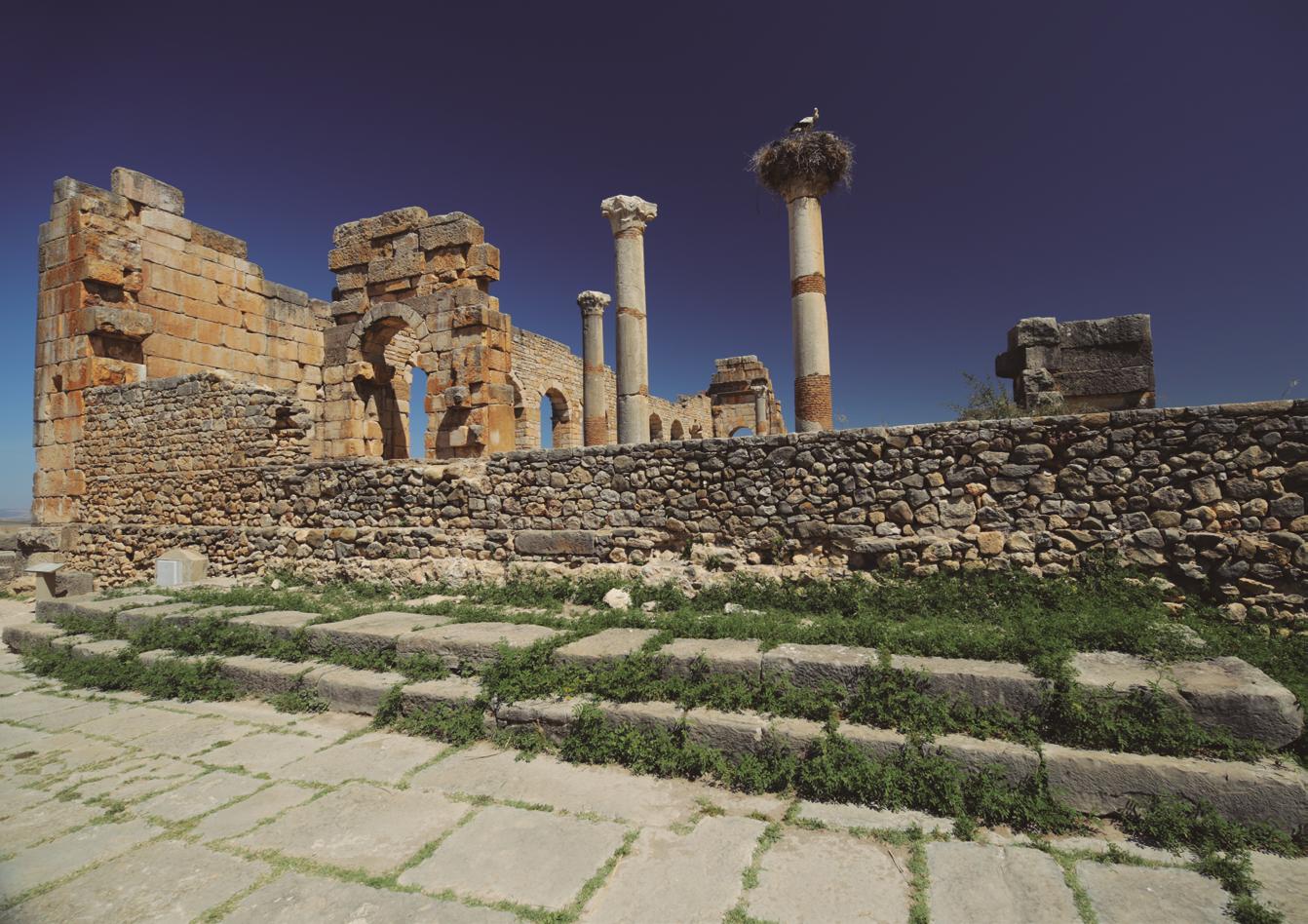
OTWO 26 / SEPTEMBER 2021 97 96 OTWO 26 / SEPTEMBER 2021



Among the many activities that Clubhouse Gibraltar provides is the popular beach outings during the summer which provides an opportunity to get together and benefit both from each other’s company and from all that nature has to offer us at the seaside.
We find the beach a place where we can relax, disconnect from all our troubles, and simply relax in the environment. It gives us a sense of freedom and space, just as we look at the big blue sea and the bright blue clear sky, whilst we enjoy sunbathing and absorb the sun’s energy. Salt water also soothes our skin and every time we go for a swim it also helps all our body joints.
We find ourselves connected to the environment and nature, where white butterflies and birds are flying around and singing. We connect with nature and find a sense of belonging, a connection of warmth and peace, a beautiful feeling of openness that helps our Mental Health.
The beach also brings back good memories from our childhood, memories of our family that gives us a feeling of togetherness. All the amazing vibrant colors come together beautifully with the clear blue sky, the bright yellow sun and the deep blue sea, a wonderful space of freedom and relaxation is created, helping all the troubles go away or cease to exist for that moment.
There are many other benefits, sounds and sensations experienced, like listening to the waves, watching the birds flying, lying down in the sun (when it is not too hot) and absorbing the warmth and vitamin D and walking barefoot along the seashore which is good for our circulation amongst other benefits.
The beach is a refreshing place that makes us feel better. It gives us a boost in our mood and relaxes our minds. We love to hear the waves break onto the rocks, it’s so soothing for us, after a while we can feel less stressed, and our anxiety levels going down.
The feeling of the sand on our feet just makes us feel connected to the moment which helps a lot with our state of mind.
Entre las muchas actividades que ofrece el Clubhouse Gibraltar se encuentran las populares salidas a la playa durante el verano, que brindan la oportunidad de reunirse y beneficiarse tanto de la compañía de los demás como de todo lo que la naturaleza nos ofrece en la orilla del mar.
La playa nos parece un lugar donde podemos relajarnos, desconectar de todos nuestros problemas y simplemente descansar en el entorno. Nos da una sensación de libertad y de espacio, al contemplar el gran mar azul y el cielo claro y brillante, mientras disfrutamos tomando el sol y absorbiendo su energía. El agua salada también alivia nuestra piel y cada vez que vamos a nadar, ayuda a todas las articulaciones de nuestro cuerpo.
Nos encontramos conectados con el entorno y la naturaleza, donde las mariposas blancas y los pájaros vuelan y cantan. Conectamos con la naturaleza y encontramos un sentido de pertenencia, una conexión de calidez y paz, una hermosa sensación de apertura que ayuda a nuestra Salud Mental. La playa también nos trae buenos recuerdos de nuestra infancia, recuerdos de nuestra familia que nos dan una sensación de unión. Todos los increíbles colores vibrantes se unen maravillosamente con el cielo azul claro, el sol amarillo brillante y el mar azul profundo, se crea un maravilloso espacio de libertad y relajación, que ayuda a que todos los problemas se vayan o dejen de existir por ese momento.
Hay muchos otros beneficios, sonidos y sensaciones que se experimentan, como escuchar las olas, ver el vuelo de los pájaros, tumbarse al sol (cuando no hace demasiado calor) y absorber el calor y la vitamina D y caminar descalzo por la orilla del mar, que es bueno para nuestra circulación, entre otros beneficios.
La playa es un lugar refrescante que nos hace sentir mejor. Nos da un impulso a nuestro estado de ánimo y nos relaja la mente. Nos encanta oír cómo rompen las olas contra las rocas, es muy relajante para nosotros, después de un rato podemos sentirnos menos estresados, y nuestros niveles de ansiedad bajan.
La sensación de la arena en nuestros pies nos hace sentir conectados con el momento, lo que ayuda mucho a nuestro estado de ánimo.
101 100 OTWO 26 / SEPTEMBER 2021 OTWO 26 / SEPTEMBER 2021

Alexandra Lester
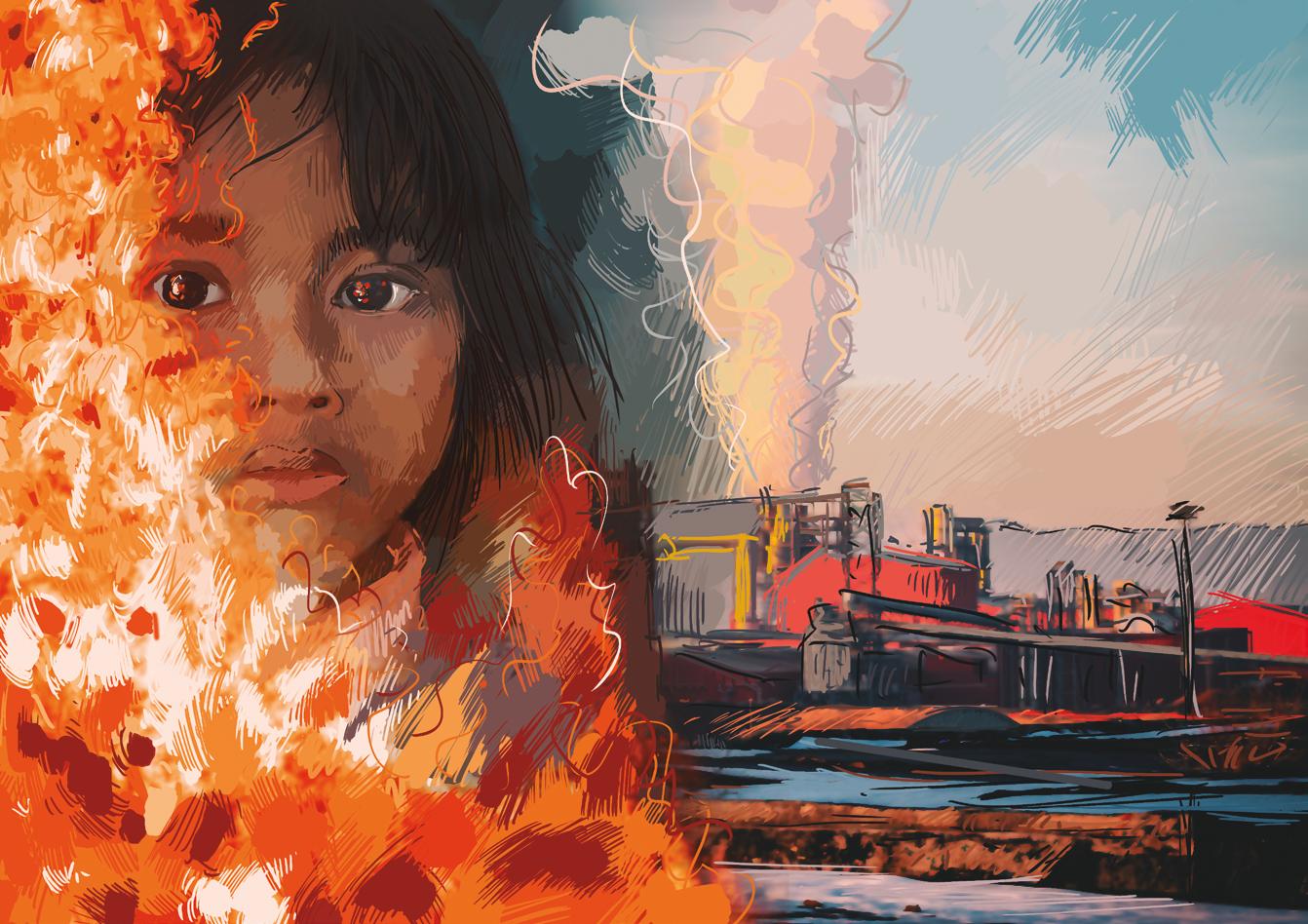
Promise Me You’ll Try
Promise me you’ll try?
Try to help. My lungs are dying. My very core is dying.
I cannot breathe
Promise me you’ll try?
Try to help.
My life depends on it. And so does yours.
Promise me you’ll try?
Try to prevent. My children from dying. My oceans from dying.
Promise me you won’t forget. Or you won’t live to regret the damage you cause without a second’s pause.
Promise me you won’t Ignore my pleas. This is not a time for your governments to appease.
Promise me you’ll be the solution.
Or before you know it, we’ll be dead from pollution.
Your promise might seem fairly small individually, but millions of people taking these actions together will have a massive, powerful impact.
The change starts now. It’s your planet, and you have the power to protect it this Earth Hour.
Prométeme que lo intentarás
¿Prometes que lo intentarás?
Intenta ayudar. Mis pulmones están muriendo. Mi núcleo se está muriendo. No puedo respirar
¿Prometes que lo intentarás?
Intenta ayudar.
Mi vida depende de ello. Y la tuya también.
¿Prometes que lo intentarás?
Trata de prevenir. Que mis hijos mueran. Que mis océanos mueran.
Prométeme que no olvidarás. O que no vivirás para lamentar el daño que causaste sin un segundo de pausa.
Prométeme que no Ignorarás mis ruegos. Este no es un momento para que sus gobiernos para apaciguar.
Prométeme que serás la solución.
O antes de que te des cuenta, estaremos muertos por la contaminación.
Tu promesa puede parecer bastante pequeña individualmente, pero millones de personas tomando estas acciones juntas tendrán un impacto masivo y poderoso.
El cambio empieza ahora. Es tu planeta y tienes el poder de protegerlo en esta Hora del Planeta.
102
OTWO 26 / SEPTEMBER 2021
Aged 15 ILLUSTRATION: JUANJO TRUJILLO
OTWO 26 / SEPTEMBER 2021 103 ILLUSTRATION: JUANJO TRUJILLO

El camino de la naturaleza
Nature’s Way
Owen Wiseman
Can greenery improve academic performance as we send our kids back to school?
Can greenery improve academic performance as we send our kids back to school?
Tras un año de cambios sísmicos en la forma de impartir la educación, los niños de países de todo el mundo volverán a la enseñanza presencial. A pesar de los increíbles esfuerzos de los educadores, muchos de estos alumnos sufrieron un retraso académico, posiblemente debido a la desigualdad en el acceso a la tecnología y los recursos. Los responsables de la toma de decisiones deben buscar recursos que apoyen a todos los estudiantes y no a unos pocos afortunados.
¿Puede la vegetación mejorar el rendimiento académico en la vuelta al colegio de nuestros hijos?
¿Puede la vegetación mejorar el rendimiento académico en la vuelta al colegio de nuestros hijos?
After a year of seismic shifts in how education is delivered, children in countries around the globe will be returning to in-person teaching. Despite the incredible efforts by educators, many of these students were set back academically, potentially by unequal access to technology and resources. Decision makers need to look at resources that support all students rather than the lucky few.
Our study of the month was authored by Rodney Matsuoka of the Department of Landscape Architecture at the University of Illinois. Their research sought to understand whether the landscaping and natural spaces in and around a high school impacted student achievement and grades.
Did nature have its way?
The research is on our side! It is already well-known that views of nature have significant impacts on the body and mind, with the ground-breaking 1984 paper by Ulrich showing post-surgical patients recovering quicker when they had a view of greenery. Matsuoka looked at 101 public schools across southeastern Michigan and discovered that larger windows in classrooms and views of nature from the cafeteria promote academic achievement. Not only did students score higher on standardized tests, but there were significant associations with graduation rates and plans to attend a four-year college.
With this in mind, all school boards and decision-makers should invest in nature-based solutions and green architecture to support the well-being of our children.
Join us next month to learn how nature can help create a safer neighbourhood for all. In the meantime, follow Science & Nature for weekly research bites and to connect with our author.
Matsuoka, Rodney H. “Student performance and high school landscapes: Examining the links.” Landscape and urban planning 97.4 (2010): 273-282.
Nuestro estudio del mes es obra de Rodney Matsuoka, del Departamento de Arquitectura del Paisaje de la Universidad de Illinois. Su investigación pretendía comprender si el paisajismo y los espacios naturales de un instituto y sus alrededores influían en el rendimiento y las calificaciones de los estudiantes.
¿Se salió con la suya la naturaleza?
¡La investigación está de nuestro lado! Ya se sabe que las vistas de la naturaleza tienen un impacto significativo en el cuerpo y la mente, con el innovador artículo de Ulrich de 1984, que mostraba que los pacientes posquirúrgicos se recuperaban más rápidamente cuando tenían una vista de la vegetación. Matsuoka estudió 101 escuelas públicas del sureste de Michigan y descubrió que las ventanas más grandes en las aulas y las vistas de la naturaleza desde la cafetería fomentan el rendimiento académico. No sólo los alumnos obtuvieron mejores resultados en los exámenes estandarizados, sino que hubo asociaciones significativas con las tasas de graduación y los planes de asistir a una universidad de cuatro años.
Teniendo esto en cuenta, todos los consejos escolares y los responsables de la toma de decisiones deberían invertir en soluciones basadas en la naturaleza y en la arquitectura verde para apoyar el bienestar de nuestros niños.
Acompáñanos el mes que viene para saber cómo la naturaleza puede ayudar a crear un barrio más seguro para todos. Mientras tanto, sigue a Ciencia y Naturaleza para ver los artículos de investigación semanales y para conectar con nuestro autor.
Matsuoka, Rodney H. “Student performance and high school landscapes: Examining the links.” Landscape and urban planning 97.4 (2010): 273-282.
105 104
???????
OTWO 26 / SEPTEMBER 2021 OTWO 26 / SEPTEMBER 2021

Zucchini and Carrot Bread
Pan de calabacín y zanahoria
DESCRIPTION
A delicious moist alternative to sweet bread. Add raisins, nuts or seeds to make it extra special. Serve hot or cold.
INGREDIENTS
1 ½ cups grated zucchini.
1 cup grated carrots.
¾ cup white sugar.
1 egg.
½ cup vegetable oil.
1 ½ cups all-purpose flour.
½ teaspoon salt .
½ teaspoon baking soda.
¼ teaspoon baking powder.

1 teaspoon ground cinnamon.
2 teaspoons lemon zest. Honey to serve.
METHOD:
Preheat oven to 325 degrees F (165 degrees C). Grease an 8x4 inch loaf pan.
In a bowl, beat together the zucchini, carrots,sugar, egg, and oil. In a separate bowl, sift together the flour, salt, baking soda, and baking powder; stir in the cinnamon and lemon zest. Stir the flour mixture into the zucchini mixture just until blended. Pour the batter into the prepared pan.
DESCRIPCIÓN
Una deliciosa y sabrosa alternativa al pan dulce. Añada pasas, nueces o semillas para hacerlo más especial.
Sírvalo caliente o frío.
INGREDIENTES
1 ½ tazas de calabacín rallado.
1 taza de zanahorias ralladas.
¾ de taza de azúcar blanco.
1 huevo.
½ taza de aceite vegetal.
½ cucharadita de sal.

1 ½ tazas de harina para todo uso.
½ cucharadita de bicarbonato de sodio.
¼ cucharadita de levadura en polvo.
1 cucharadita de canela molida.
2 cucharaditas de ralladura de limón.
Miel para servir.
PREPARACIÓN:
Precalentar el horno a 325 grados F (165 grados C). Engrasar un molde para pan de 8x4 pulgadas.

Bake 45 minutes in the preheated oven, until a knife inserted in the center comes out clean. Remove from heat, and cool about 10 minutes before turning

En un bol, bate el calabacín, las zanahorias, el azúcar, el huevo y el aceite. En otro bol, tamiza la harina, la sal, el bicarbonato y la levadura en polvo; añade la canela y la ralladura de limón. Incorpora la mezcla de harina a la mezcla de calabacín hasta que se mezclen. Vierte la masa en el molde preparado.
Hornea 45 minutos en el horno precalentado, hasta que al introducir un cuchillo en el centro éste salga limpio. Retíralo del horno y déjalo enfriar unos 10 minutos antes de pasarlo a una rejilla para que se enfríe por completo.
Rocía con miel y disfruta.

107
OTWO 26 / SEPTEMBER 2021 OTWO 26 / SEPTEMBER 2021
Guía rápida de: Alemania.


Language: German.
Currency: EUR.
Capital: Berlin.
Famous for: Technology and Innovation. Beer. Rich history.
Some top places: Visit edgy, cultural & historical Berlin. Enjoy both the old and the new in Munich and surrounding Bavaria. Hike the hauntingly beautiful Black Forest. Explore the medieval town of Rothenburg ob der Tauber. Wander at the magical Schloss Neuschwanstein Castle. Discover the vineyards, castles and beautiful scenery of the Rhine Valley. Explore historical Dresden, Saxony and the stunning Saxon Switzerland National Park.
Activities: Climbing, hiking, culture, history, gastronomy, skiing, winter sports.

Weather:
High Season (Jul - Aug) Warm weather, busy. Shoulder (Apr – Jun & Sep - Oct) Pleasant weather, busy at times.
Low Season (Nov - Feb) Cold weather, few tourists.
Eco fact: In 2020, Germany produced nearly half of its energy from renewable sources.
Eco resorts:
Budget: Hotel Lamm from £60 per night (Baden Württemberg).
Mid: Hotel Zoo from £120 er night (Berlin).
Luxury: Hubertus Mountain Refugio Allgäu from £250 per night (Balderschwang, Barvaria).
Idioma: Alemán.
Moneda: EURO.
Capital: Berlín.
Famoso por: Tecnología e innovación. Cerveza. Una rica historia.
Algunos de los mejores lugares: Visite la vanguardista, cultural e histórica Berlín. Disfrutar de lo antiguo y lo nuevo en Múnich y los alrededores de Baviera. Recorrer la inquietantemente bella Selva Negra. Explorar la ciudad medieval de Rothenburg ob der Tauber. Pasee por el mágico castillo de Neuschwanstein. Descubra los viñedos, los castillos y los hermosos paisajes del valle del Rin. Explorar la histórica Dresde, Sajonia y el impresionante Parque Nacional de la Suiza Sajona.
Actividades: Escalada, senderismo, cultura, historia, gastronomía, esquí, deportes de invierno.
Clima:
Temporada alta (julio-agosto) Tiempo cálido, concurrido. Temporada media (abril-junio y septiembre-octubre)
Tiempo agradable, a veces muy concurrida. Temporada baja (Nov - Feb) Tiempo frío, pocos turistas. Hecho ecológico:
En 2020, Alemania produjo casi la mitad de su energía a partir de fuentes renovables. Resorts ecológicos:
Presupuesto: Hotel Lamm desde 60£ por noche (Baden Württemberg).
Medio: Hotel Zoo a partir de 120£ por noche (Berlín) De lujo: Refugio de montaña Hubertus Allgäu desde 250£ por noche (Balderschwang, Barvaria).
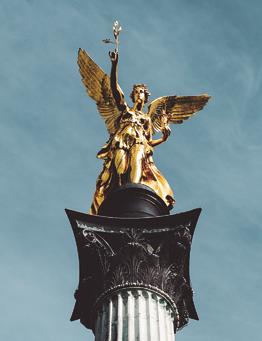
109 108
OTWO 26 / SEPTEMBER 2021 OTWO 26 / SEPTEMBER 2021
Travel Diary: Day 1
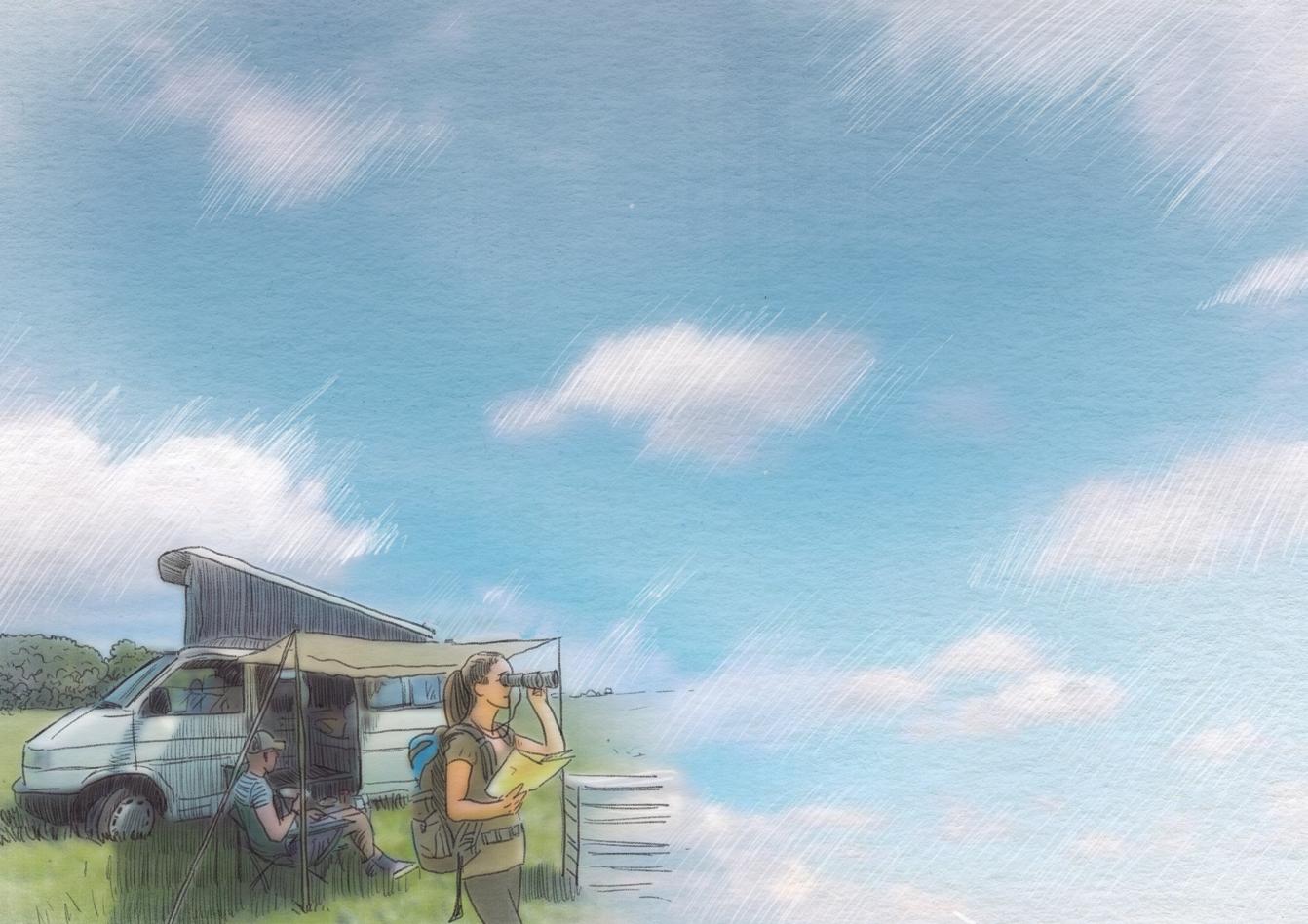
As the OTWO project grows and gathers momentum, it is obvious that there will be a certain amount of travel involved and that this will be fundamental to the growth of the network we are trying to develop.
The smaller more rudimentary the manufacturers and growers we approach the more disconnected they are from the modern platforms, and the more at the mercy of the established supermarket networ-
ks they become. There is simply no alternative, we have to move around otherwise the best products and offers will not reach our network. They will be lost into established methods and their iniquitous wealth and quality distributions.
Of course we must do this in the most environmentally friendly way, ensuring our carbon footprint is either small or non-existent.
This will be a project that we develop together with you, as indeed we are doing the network. Basic decisions have to be taken and it will be exciting to share with you the thinking and pretty pictures of course.
The first decision was mode of transport. Some areas will be remote, and connectivity will become a problem. The method must therefore be self-sufficient and provide for modern amenities like internet access etc. There may also be a need for overnight facilities particularly when we decide to develop articles and columns to bring to you details of collaborators and their services or products.
It really doesn’t take much thought. Mobility with work and sleep facilities, few things will work better than a camper van for this.
First important decision then done; we will acquire a Camper Van that will meet the strict criteria we advocate so that it will also be a standard bearer and effectively become and advertising platform for our project.
It would have been easy to go down the route of acquiring sponsors for the project and buy the latest hybrid or even full electric offers on the market, but is that really the best way to go?
Consumerism is the single biggest problem we
have as a society. Even when we consider the offers of electric cars, this that or the other that we are all being bombarded with at the moment, consider this – do I really need to buy anything at all. Is it not better to consume less by recycling products that have been produced now for years and not to force more and more products onto the rubbish heap?
The answer must be yes, we must consider whether it is possible to avoid buying anything new – at this point of course, all the fashion conscious of us will be up in arms. “But I have to be with the latest trends, I enjoy quality products of modern design so why not?”. A careful selection of the product will not only be in vogue but may even mark a trend. So looking into the market for used camper vans is certainly a good start to the project.
When it comes to iconic vans with a well-established camper design, no-one comes close to the revolutionary VW transporter which started production in March 1950 and is still going strong over 70 years later.
Next month we will go into the history of the Transporter so that we can begin to develop our interpretation of the best Camper in today’s market. This promises to be an eye opening journey for us as we go into propulsion units and self sufficient energy systems. Cannot wait to share.
In the meantime if any of you have already done something like this please do not hesitate to share. As always OTWO projects do not look for readers only, we look to share and network ideas for all to build on. We will make a difference working individually but joined in focus and intent!
OTWO 26 / SEPTEMBER 2021 111 110 OTWO 26 / SEPTEMBER 2021
ILLUSTRATION: JUANJO TRUJILLO
Diario de Viaje: Día 1

Amedida que el proyecto de la OTWO crece y cobra impulso, es obvio que habrá una cierta cantidad de viajes y que esto será fundamental para el crecimiento de la red que estamos tratando de desarrollar.
Cuanto más pequeños y rudimentarios sean los fabricantes y cultivadores a los que nos acerquemos, más desconectados estarán de las plataformas modernas y más a merced de las redes de supermercados establecidas. Sencillamente, no hay alternativa, tenemos que movernos porque, de lo contrario, los mejores productos y ofertas no llegarán a nuestra red. Se perderán en los métodos establecidos y sus inicuas distribuciones de riqueza y calidad.
Por supuesto, debemos hacerlo de la forma más respetuosa con el medio ambiente, garantizando que nuestra huella de carbono sea pequeña o inexistente.
Este será un proyecto que desarrollaremos junto con ustedes, como de hecho estamos haciendo con la red. Hay que tomar decisiones básicas y será emocionante compartir con vosotros las ideas y las bonitas imágenes, por supuesto.
La primera decisión fue el modo de transporte. Algunas zonas serán remotas y la conectividad será un problema. Por ello, el método debe ser autosuficiente y disponer de comodidades modernas, como acceso a Internet, etc. También puede ser necesario contar con facilidades para pasar la noche, sobre todo cuando decidamos elaborar artículos y columnas para dar a conocer los detalles de los colabora-
dores y sus servicios o productos.
Realmente no hace falta pensarlo mucho. Movilidad con instalaciones para trabajar y dormir, pocas cosas funcionarán mejor que una furgoneta camper para esto.
Primera decisión importante entonces; adquiriremos una furgoneta camper que cumpla con los estrictos criterios que propugnamos para que también sea un estandarte y se convierta efectivamente en una plataforma publicitaria de nuestro proyecto.
Habría sido fácil seguir el camino de la adquisición de patrocinadores para el proyecto y comprar las últimas ofertas híbridas o incluso totalmente eléctricas del mercado, pero ¿es realmente el mejor camino?
El consumismo es el mayor problema que tenemos como sociedad. Incluso cuando consideramos las ofertas de coches eléctricos, esto o lo otro con lo que nos bombardean en este momento, pensemos en esto: ¿realmente necesito comprar algo? ¿No es mejor consumir menos reciclando los productos que ya se fabrican desde hace años y no obligar a tirar más y más productos a la basura?
La respuesta debe ser afirmativa, debemos plantearnos si es posible evitar comprar nada nuevo; en este punto, por supuesto, todos los que se preocupan por la moda se levantarán en armas. “Pero tengo que estar con las últimas tendencias, me gustan los productos de calidad de diseño moderno, así que ¿por qué no?”.
Una cuidadosa selección del producto no sólo estará de moda, sino que incluso puede marcar una tendencia. Así que buscar en el mercado de furgonetas camper de segunda mano es sin duda un buen
comienzo para el proyecto.
Cuando se trata de furgonetas icónicas con un diseño de camper bien establecido, nadie se acerca al revolucionario transportador VW, que comenzó a producirse en marzo de 1950 y que sigue funcionando con fuerza más de 70 años después. El próximo mes nos adentraremos en la historia del Transporter para empezar a desarrollar nuestra interpretación del mejor Camper del mercado actual. Este pro-
mete ser un viaje que nos abrirá los ojos al adentrarnos en las unidades de propulsión y los sistemas de energía autosuficientes. No puedo esperar a compartirlo.
Mientras tanto, si alguno de ustedes ya ha hecho algo como esto, por favor no dude en compartirlo. Como siempre, los proyectos de OTWO no buscan sólo a los lectores, sino que buscan compartir y poner en red las ideas para que todos las aprovechen. Marcaremos la diferencia trabajando individualmente, pero unidos en el enfoque y la intención.
OTWO 26 / SEPTEMBER 2021 113 112 OTWO 26 / SEPTEMBER 2021
ILLUSTRATION: JUANJO TRUJILLO


PRODUCT RANGE
Toilet Roll, Kitchen Roll, Facial Tissue, Pocket Tissue, Baby Wipes, Anti-Bacterial Handy Wipes, Anti-Bacterial Surface Wipes, Make-Up Cleansing Wipes, Straws, Shaker Straws,



The Cheeky Panda® is an example of the innovative disruptor concept – taking the world’s fastest growing plant Bamboo and turning it into tissue. They provide a truly sustainable alternative to one of the biggest environmental concerns of the present-day deforestation. The company is built on our passion for environmental and social responsibility, their products are a catalyst for change and they are a deliverer of truly innovative products that are making the world a better place.


21
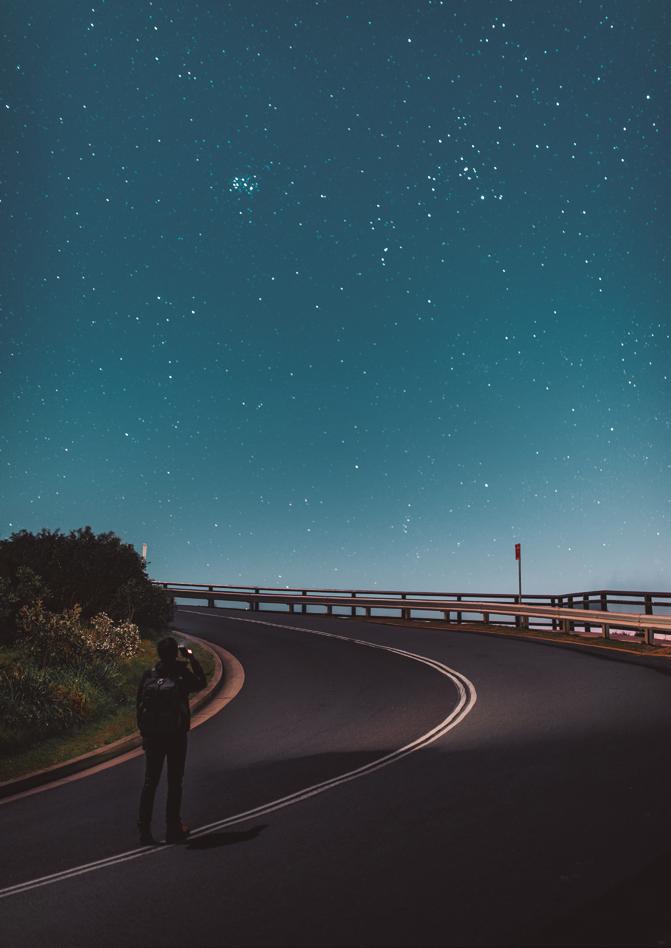
Transport available for groups.Check with us for your requirements. OTWO is a facilitator on these packages. All activities are contracted directly between the respective centre operator and the client.
Prices are for the month of September only, please contact us for other dates.
Transporte disponible para grupos. Consultenos si estás interesado. OTWO es un mediador de estos paquetes. Todas las actividades se contratan directamente entre el operador y el cliente.
Precios válidos solo para el mes de septiembre, consulte para otras fechas.
115 Plastic Free • Carbon Footprint • Vegan & Cruelty Free Why Bamboo • Kind to Skin FOR MORE INFORMATION CLICK ON EACH SECTION
www.bamboopanda.gi Shop via our new website now live! Discounted Products, Monthly Subscription Services and more! The Future is Cheeky
Baby Nappies.
OTWO 26 / SEPTEMBER 2021 Catálogo de Experiencias VERANO
OTWO Magazine
+00350 22500799
Organized by:
Tel.
info@otwomag.com
SUMMER CATALOG 21
In2Adventures Stand Up Paddle Lessons
In2Adventures Clases de remo de pie (SUP)
We are a Gibraltar based adventure and activity company established in 2013. We promote the importance of a healthy lifestyle through fun-based activities tailored to our clients needs.
Our aim is to respectfully promote the amazing natural features of our environment. We work with a number of local charities and believe in the community. We encourage people to explore Gibraltar and enjoy the outdoors through our activities. Our Core values are based on combining adventure, the outdoors, education and fun.
Gibraltar has a fantastic caring community and at the core of In2adventures culture is an aim to help strengthen our Community. We work closely with charities to raise money for worthy causes and provide a platform for educating and inspiring young people.
“SUP” Lesson
Join us for a beginners SUP session to learn the basics from kneeling and to finally stand up paddle boarding. Once you have completed this session, you are able to join on other more advanced SUP adventures such as the Sunset and the SUP safari around the stunning southerly coastline of Gibraltar. This session is for people who are keen to develop paddling skills, learn the correct techniques and keep safe on the water.
SUP Certificate included for completing the lesson.
2 HOURS
INCLUDES: Board, Paddle & instructor.
MAY WE RECOMMEND:Buoyancy Aid £5 per guest per hour. Wet suit £5 per guest per hour.
£35 PER PERSON

Somos una empresa de aventura y actividades con sede en Gibraltar establecida en 2013. Promovemos la importancia de un estilo de vida saludable a través de actividades basadas en la diversión y adaptadas a las necesidades de nuestros clientes. Nuestro objetivo es promover respetuosamente las increíbles características naturales de nuestro entorno. Trabajamos con varias organizaciones benéficas locales y creemos en la comunidad. Animamos a la gente a explorar Gibraltar y a disfrutar del aire libre a través de nuestras actividades. Nuestros valores fundamentales se basan en la combinación de la aventura, el aire libre, la educación y la diversión. Gibraltar cuenta con una fantástica comunidad solidaria y en el centro de la cultura de In2adventures está el objetivo de ayudar a fortalecer nuestra Comunidad. Trabajamos estrechamente con organizaciones benéficas para recaudar fondos para causas dignas y proporcionamos una plataforma para educar e inspirar a los jóvenes.
Clases de “SUP”
Acompáñanos en nuestras clases de SUP para principiantes, para aprender los fundamentos desde el arrodillamiento hasta el stand up paddle boarding. Una vez que hayas completado esta sesión, podrás unirte a otras aventuras de SUP más avanzadas, como la puesta de sol y el safari de SUP alrededor de la impresionante costa del sur de Gibraltar. Esta sesión es para personas que quieren desarrollar sus habilidades de remo, aprender las técnicas correctas y mantenerse seguras en el agua. Certificado SUP incluido por completar la clase.
2 HORAS
INCLUYE: Tabla, remo e instructor.
PODEMOS RECOMENDAR: Chaleco salvavidas 5 libras por persona y hora. Traje de neopreno £5 por huésped por hora.
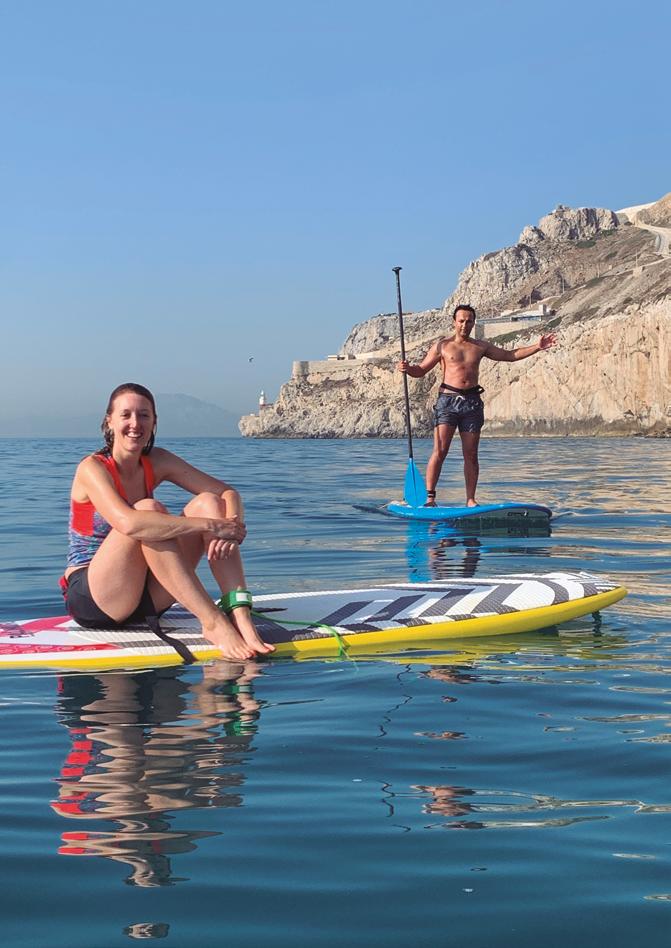
Jimmy Gracia
Jimmy is an outdoors man and is qualified as an instructor in many adventure activities. A keen mountaineer and also a qualified paddle sport coach, his teaching technique is first class. Following a full successful career in the military he developed his outdoor instructor skills and trained in the outdoor industry in Cornwall. He has been on numerous expeditions around the world including high altitude mountaineering in the Himalayas and paddle boarding across the Straights of Gibraltar.

Jimmy Gracia
Jimmy es un hombre del aire libre y está cualificado como instructor en muchas actividades de aventura. Es un montañero entusiasta y también un entrenador cualificado de deportes de remo, su técnica de enseñanza es de primera clase. Tras una exitosa carrera en el ejército, desarrolló sus habilidades como instructor de actividades al aire libre y se formó en la industria de las actividades al aire libre en Cornualles. Ha participado en numerosas expediciones por todo el mundo, incluyendo montañismo de gran altitud en el Himalaya y paddle boarding a través del Estrecho de Gibraltar.
117 116
35 LIBRAS POR PERSONA OTWO 26 / SEPTEMBER 2021 OTWO 26 / SEPTEMBER 2021
EBikes Group Tours Gibraltar

EBIKES GROUP TOURS
Gibraltar
Enjoy breath taking views across 3 countries and 2 continents, explore Gibraltar’s fascinating history and be introduced to our most famous inhabitants, the Barbary macaques – the only free roaming monkeys in Europe!
Price: £69 per person.
Highlights
Europa Point and Lighthouse. Upper Rock Nature Reserve.
Pillars of Hercules Monument.
Windsor Suspension Bridge. O’Hara’s Battery (top of Rock 424m). Skywalk.
Ape’s Den.
Great Siege Tunnels.
Moorish Castle. …And many more.
What’s included?
Premium e-bike by Riese&Müller. Cycle helmet.
Safety instructions.
Entrance fee into the Nature Reserve. An official tour guide. Bottled water.
DURATION:
3 hours. Suitable for everyone over 155 cm, over 12 years old and capable of riding a bicycle.
GROUP TOURS
Gibraltar
Disfrute de las impresionantes vistas de 3 países y 2 continentes, explore la fascinante historia de Gibraltar y conozca a nuestros habitantes más famosos, los macacos de Berbería, ¡los únicos monos que se desplazan libremente en Europa!
Precio: £69 por persona.
Puntos destacados
Punta de Europa y el Faro
Reserva Natural Upper Rock (Parte superior del peñon)
Monumento de las Columnas de Hércules
Puente colgante de Windsor
Bateria de O’Hara (parte superior del peñon - 424m).
El Skywalk
Guarida de los monos
Gran túneles de asedio
Castillo Arabé. …y muchos más
¿Qué está incluido?
Alta calidad E-bike de Riese&Müller. Casco de bicicleta
Instrucciónes de seguridad
Entrada a la reserva natural Guía oficial Agua embotellada.
DURACIÓN:
3 horas. Adecuadas para todos los que midan más de 155 cm, tengan más de 12 años de edad y puedan montar en bicicleta.
Organized by: OTWO Magazine
Tel. +00350 22500799
info@otwomag.com
Transport available for groups.Check with us for your requirements.
OTWO is a facilitator on these packages. All activities are contracted directly between the respective centre operator and the client.
Organized by: OTWO Magazine
Tel. +00350 22500799
info@otwomag.com
Transporte disponible para grupos.
Consultenos si estás interesado.
OTWO es un mediador de estos paquetes. Todas las actividades se contratan directamente entre el operador y el cliente.
119 118
OTWO 26 / SEPTEMBER 2021 OTWO 26 / SEPTEMBER 2021
MOUNTAIN BIKE ADVENTURE MTB TRAVERSE “WHITE VILLAGES”
Our adventure takes place between the provinces of Cadiz and Malaga, cycling along the old route of the Jerez - Almargen railway.
Work on the Jerez-Almargen railroad began on January 9, 1927. A total of 110 kilometers were paved, 19 tunnels were built (the longest being 1,200 meters), several viaducts and bridges (the Zaframagón, the most spectacular) and 12 stations (Jerez, El Rizo, Jédula, Arcos, Bornos, Villamartin, Puerto Serrano, Coripe, Zaframagón, Navalagrulla, Olvera and Corbones).
The works came to a standstill with the fall of the regime of General Jerez, and were later resumed on several occasions, but budgetary difficulties prevented the continuation of the work, so it was never used.
Today part of the route has been converted into the Vía Verde de la Sierra, a path for hiking and mountain biking. In recent years, several agreements have been signed to try to recover the initial section linking Jerez de la Frontera and Puerto Serrano, to give continuity to this road with great potential for tourism and economic development in the area.
The Journey.
The crossing MTB Pueblos Blancos is an original mountain bike route to be done in two stages and in which the towns of El Puerto de Santa María (Cádiz) and Ronda (Málaga) are joined, adding between the two stages a total of 190 km and 3000 m of positive difference in altitude.
The route passes through a total of nine municipalities in the province of Cadiz (El Puerto de Santa



Maria, Jerez de la Frontera, Arcos de la Frontera, Bornos, Villamartin, Puerto Serrano, Olvera, Setenil de las Bodegas and Torre Alhaquime), ending in the Malaga town of Ronda.
It passes through spectacular stretches such as the following:
- Mouth of the Guadalete river (El Puerto Sta. Mª).
- Circuito de Velocidad (Jerez de la Frontera).
- Old Sugar Train Station (Jedula).
- Meanders of the Guadalete river (Arcos de la Frontera).
- Historic center of Arcos de la Frontera.
- Reservoir of Bornos.
- Greenway of the Sierra (Puerto Serrano-Olvera).
- Castle of Olvera.
- Castle of Torre Alhaquime.
- Urban network (Setenil de las Bodegas).
- Tajo de Ronda.
All the necessary logistics will be provided for the adventure, which will be carried out on an all-inclusive basis (activity, lodging, meals, previous advice, etc.).
Duration: 2 days.
Minimum/Maximum number of participants: 6/10 participants.
Recommended Dates: From September to May.
Services:
Instructor guide and previous advice. Lodging and meals.
First aid kit.
RC and Accident Insurance.
Photos with video summary.
Gifts (T-shirt and finisher medal).
Price: Full adventure.......... £180
121 120
OTWO 26 / SEPTEMBER 2021 OTWO 26 / SEPTEMBER 2021
AVENTURA EN BICI DE MONTAÑA TRAVESIA MTB “PUEBLOS BLANCOS”

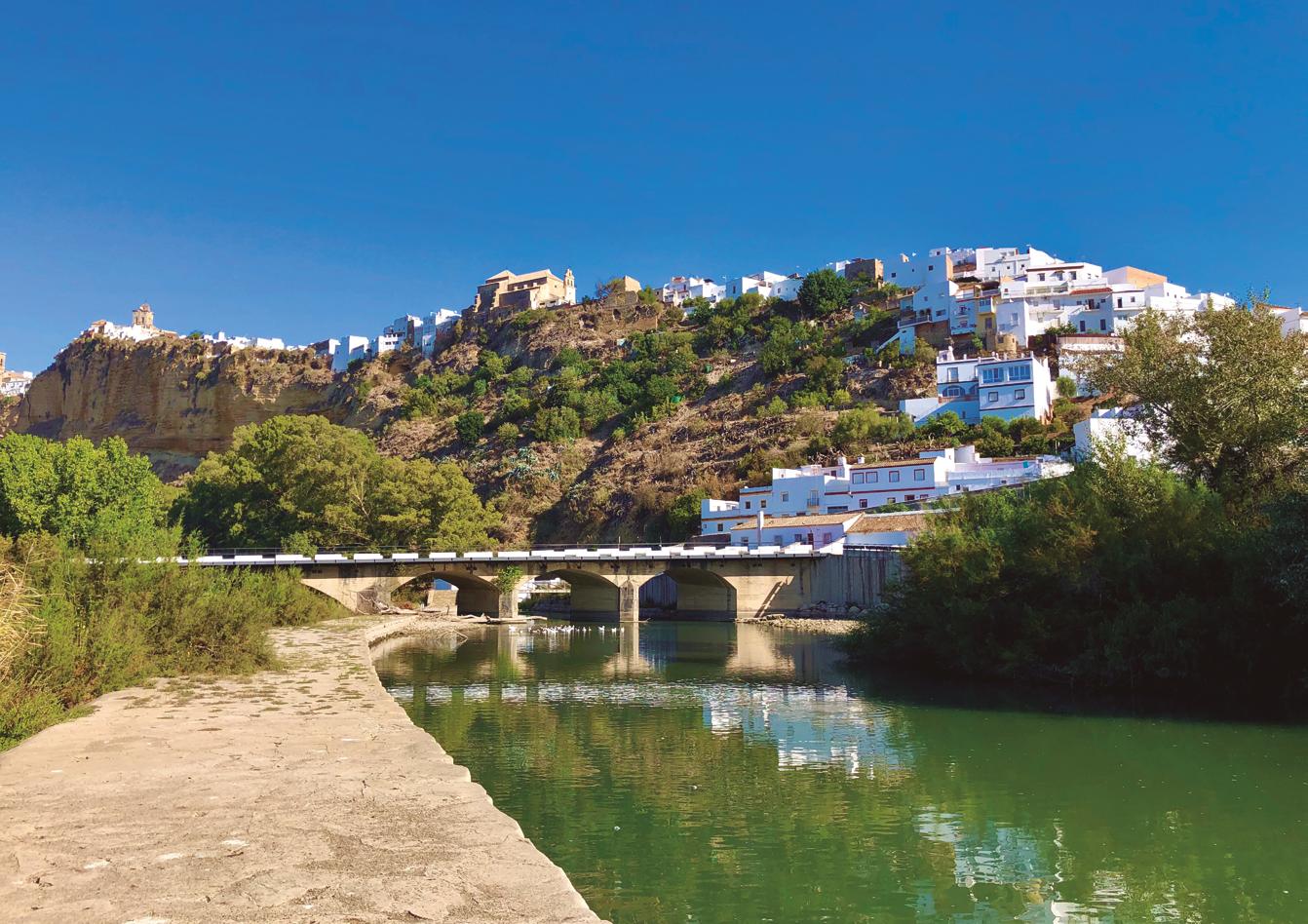
Nuestra aventura se realiza entre las provincias de Cádiz y Málaga, recorriendo en bici parte del antiguo trazado de la vía férrea Jerez – Almargen.
Las obras del ferrocarril Jerez-Almargen se iniciaron el 9 de enero de 1927. Se explanaron 110 kilómetros, se construyeron 19 túneles (el más largo de 1.200 metros), varios viaductos y puentes (el de Zaframagón, el más espectacular) y 12 estaciones (Jerez, El Rizo, Jédula, Arcos, Bornos, Villamartin, Puerto Serrano, Coripe, Zaframagón, Navalagrulla, Olvera y Corbones).
Las obras se paralizaron con la caída del régimen del general jerezano, reanudándose posteriormente en varias ocasiones, pero las dificultades presupuestarias impidieron la continuación de los trabajos, por lo que nunca se llegó a utilizar.
Hoy parte del trazado se ha reconvertido en la Vía Verde de la Sierra, un camino para practicar el senderismo y bicicleta de montaña. En los últimos años se han firmado varios convenios para tratar de recuperar el tramo inicial que une Jerez de la Frontera y Puerto Serrano, para dar continuidad a este camino con un gran potencial para el turismo y el desarrollo económico de la zona.
La Travesía.
La Travesía MTB Pueblos Blancos es una original ruta en bicicleta de montaña a realizar en 2 etapas y en las que se unen las localidades de El Puerto de Santa María (Cádiz) y Ronda (Málaga), sumando entre las dos etapas un total de 190 km totales y 3000 m de desnivel positivo.
El recorrido pasa por un total 9 municipios de la provincia de Cádiz (El Puerto de Santa María, Jerez de la Frontera, Arcos de la Frontera, Bornos, Villamartin, Puerto Serrano, Olvera, Setenil de las Bodegas y Torre Alhaquime), finalizando en la localidad malagueña de Ronda.
Se pasa por tramos espectaculares como los siguientes:
- Desembocadura del rio Guadalete (El Puerto Sta. Mª).
- Circuito de Velocidad (Jerez de la Frontera).
- Antigua estación del tren del Azúcar (Jedula).
- Meandros del rio Guadalete (Arcos de la Frontera).
- Casco histórico de Arcos de la Frontera.
- Embalse de Bornos.
- Vía Verde de la Sierra (Puerto Serrano-Olvera).
- Castillo de Olvera.
- Castillo de Torre Alhaquime.
- Entramado urbano (Setenil de las Bodegas).
- Tajo de Ronda.
Para la aventura se dispondrá de toda la logística necesaria, realizándose en régimen de todo incluido (actividad, alojamientos, comidas, asesoramiento previo, etc).
Duración:
2 días.
Mínimo/Máximo de participantes: 6/10 participantes.
Fechas Recomendadas: De Septiembre a Mayo.
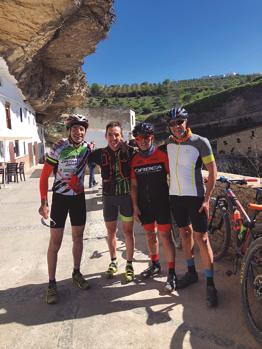
Servicios:
Monitor guía y asesoramiento previo. Alojamiento y Comidas.. Botiquín primeros auxilios.
Seguros RC y Accidentes.
Reportaje fotográfico con vídeo resumen. Regalos (Camiseta y Medalla finisher).
Precios: Aventura completa………. £180
123 122
OTWO 26 / SEPTEMBER 2021


8 George’s Lane, Gibraltar / info@spiritoftherock.gi / +350 540 67487 / www.spiritoftherock.gi


































































































































